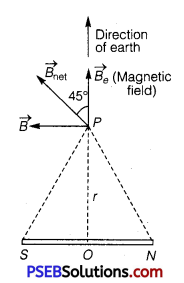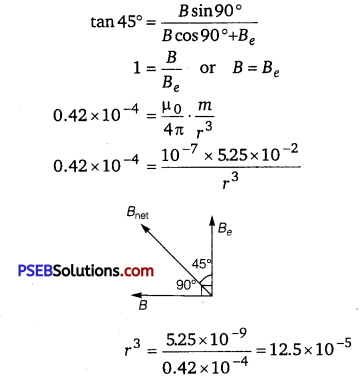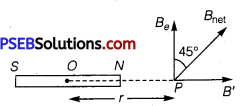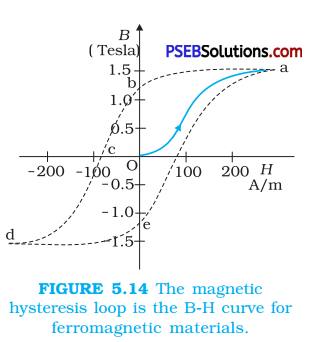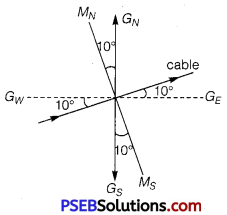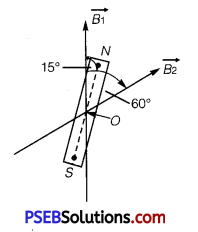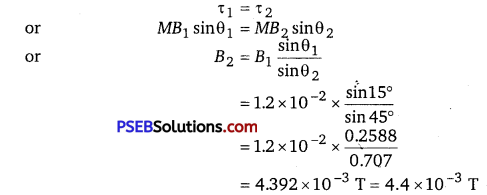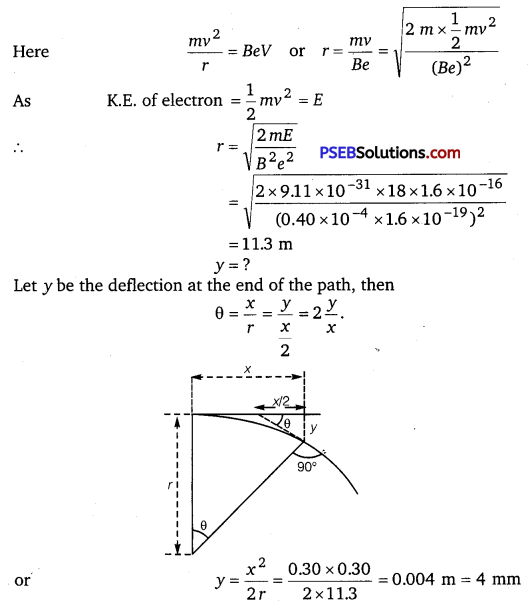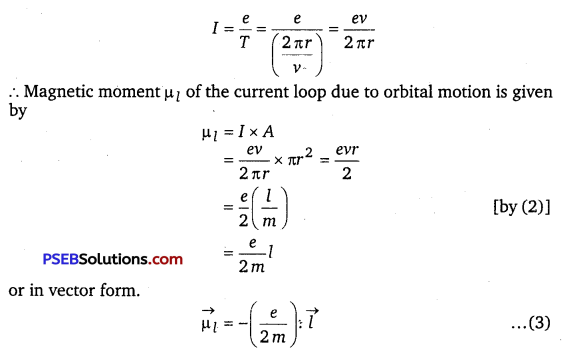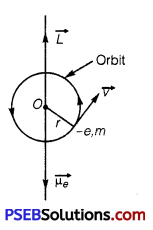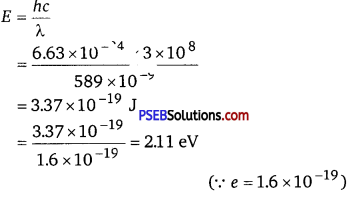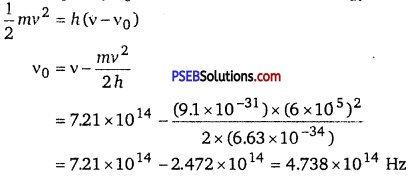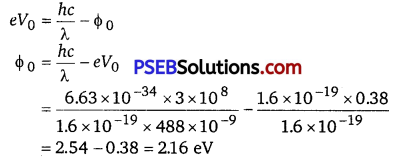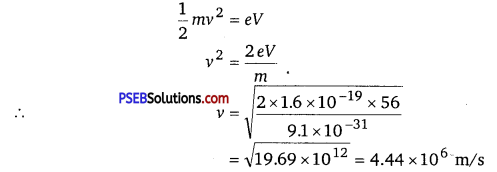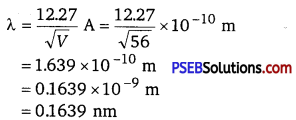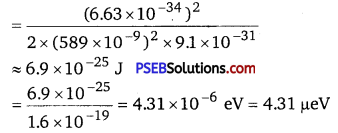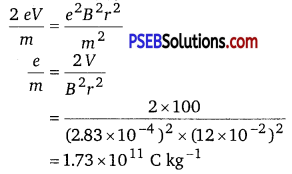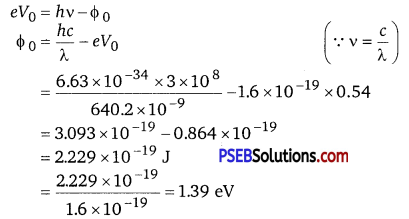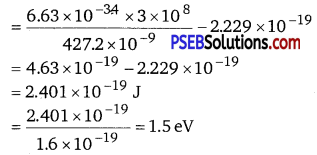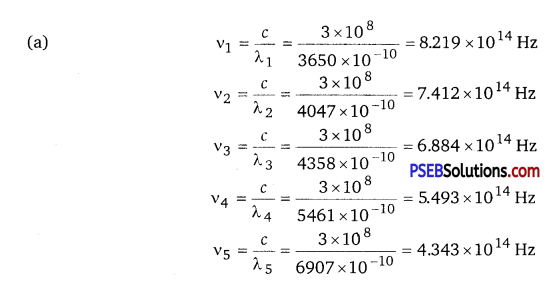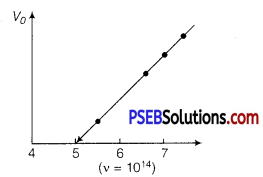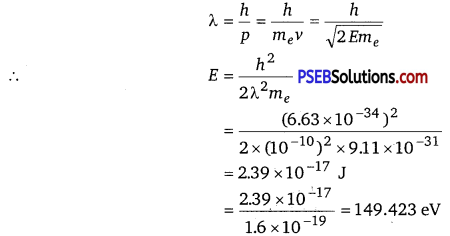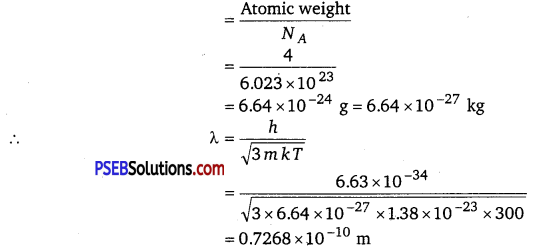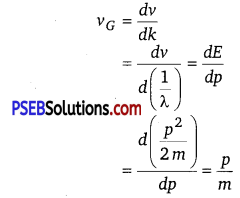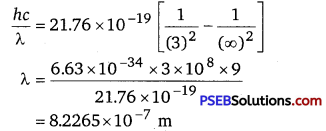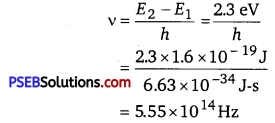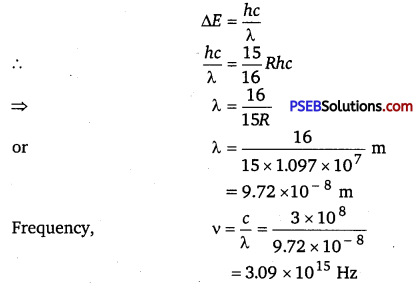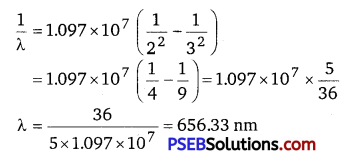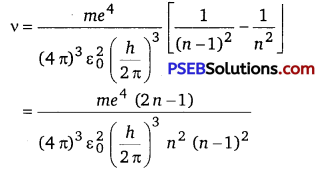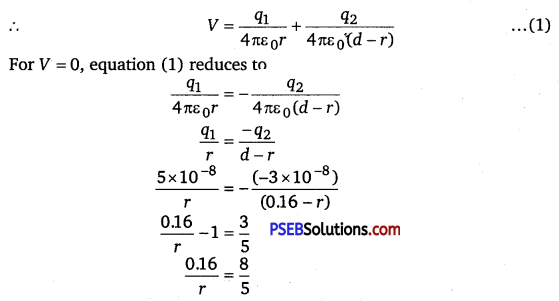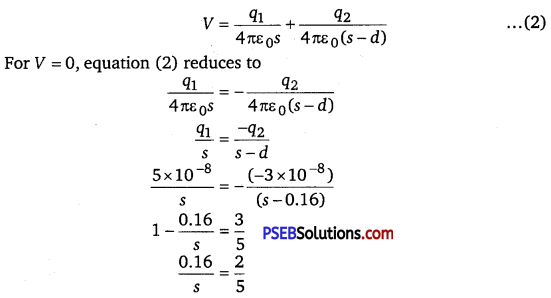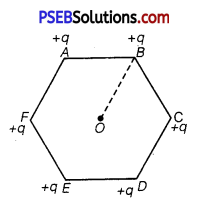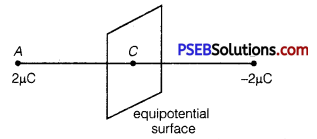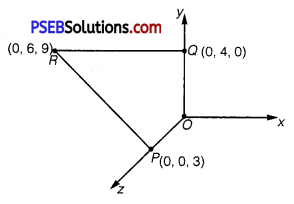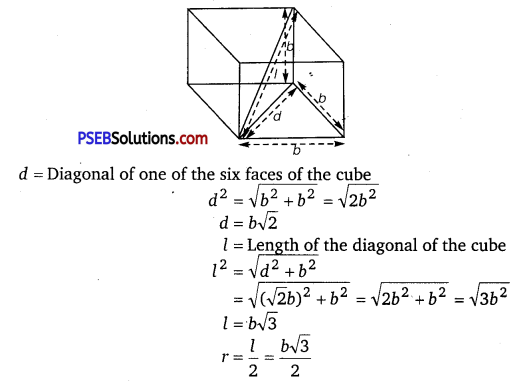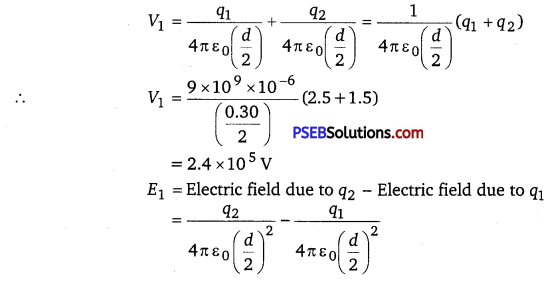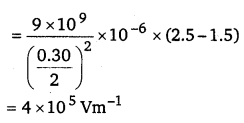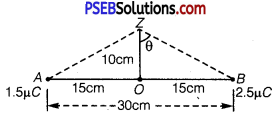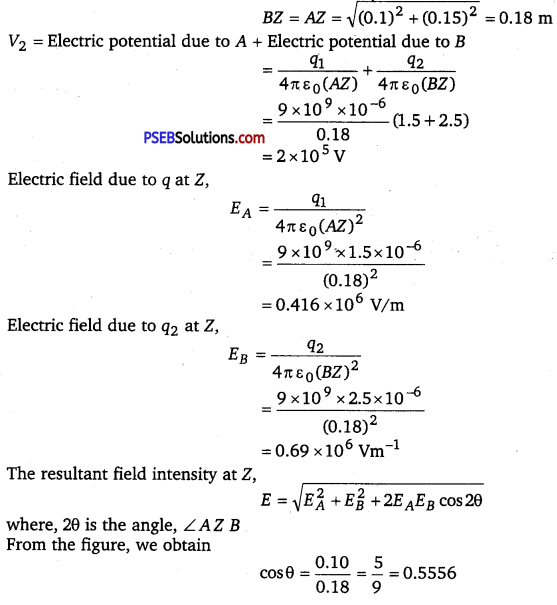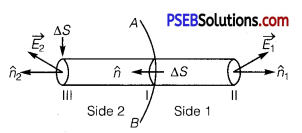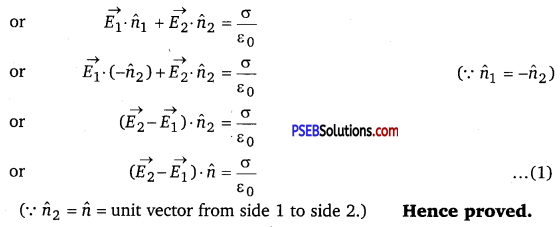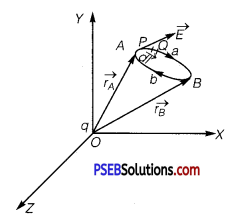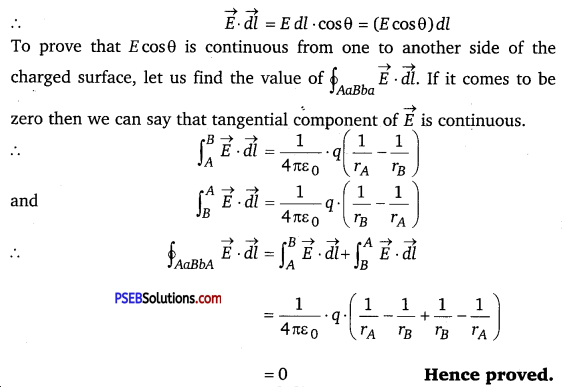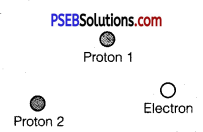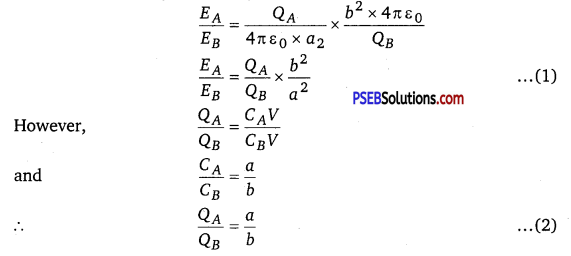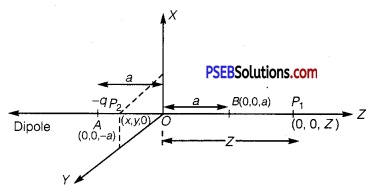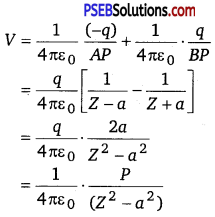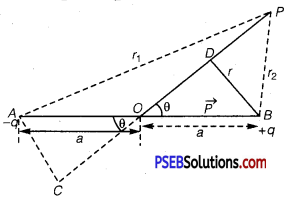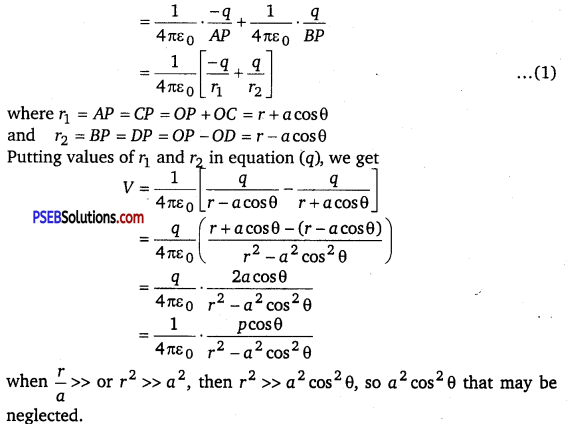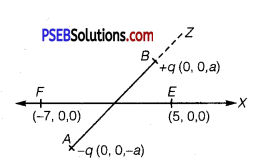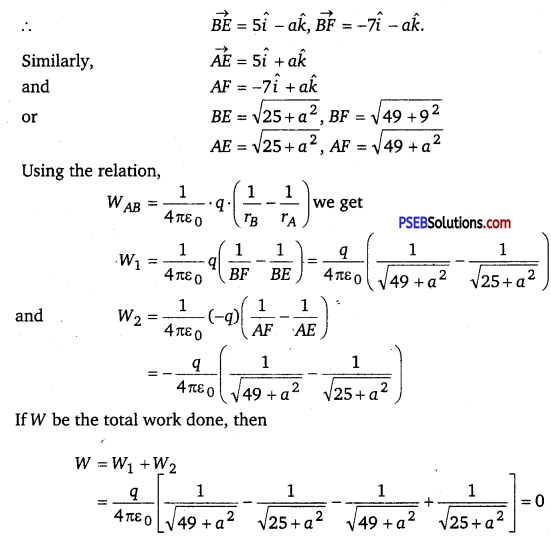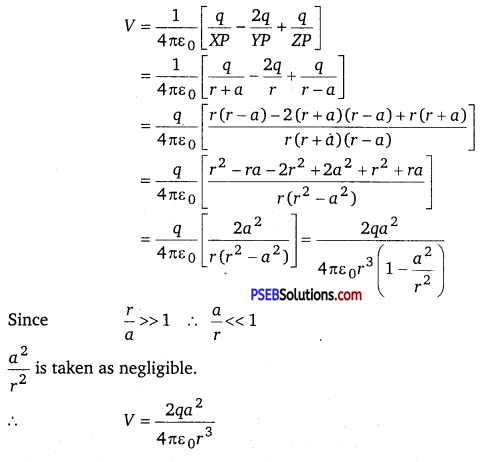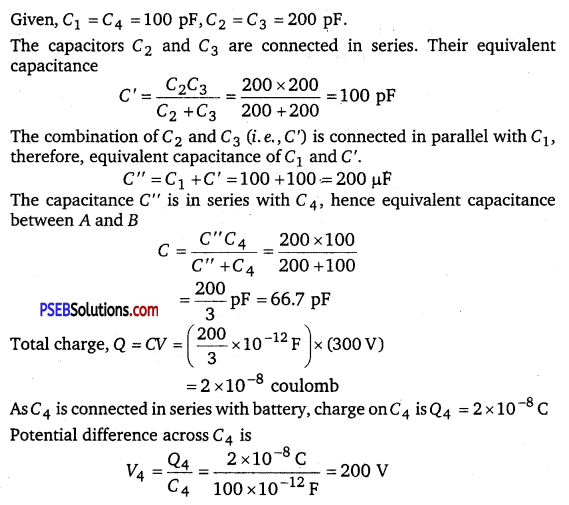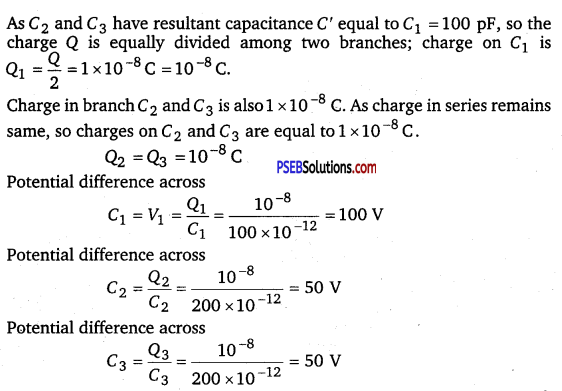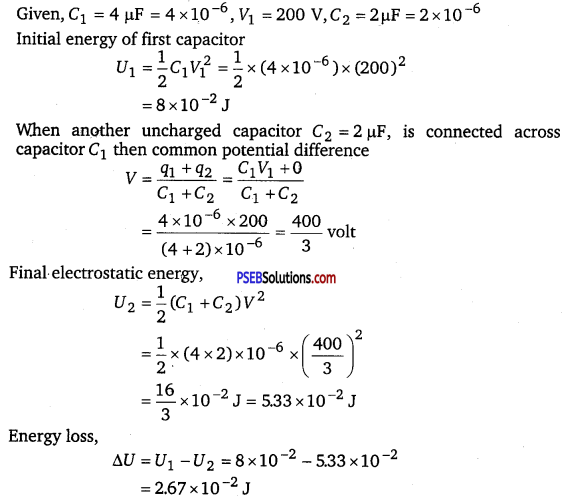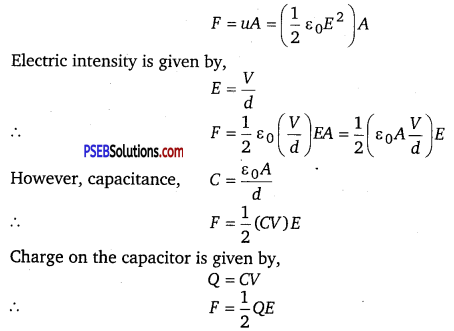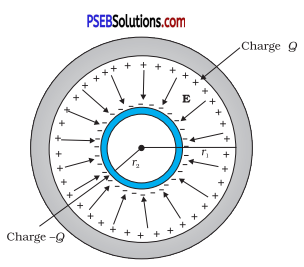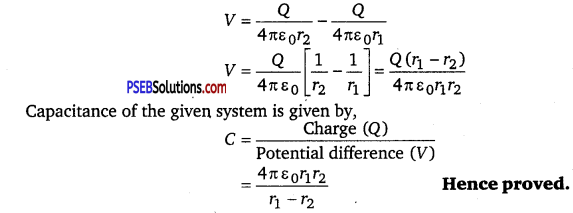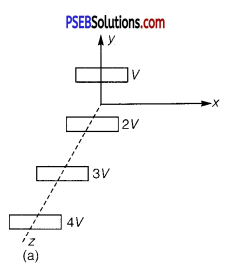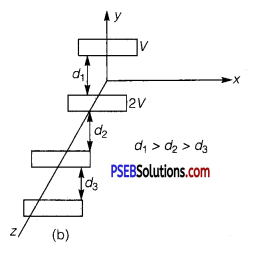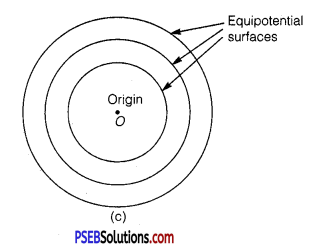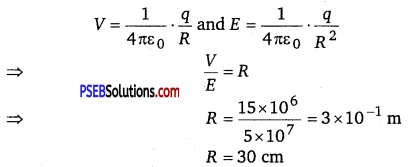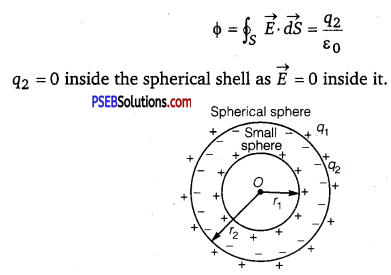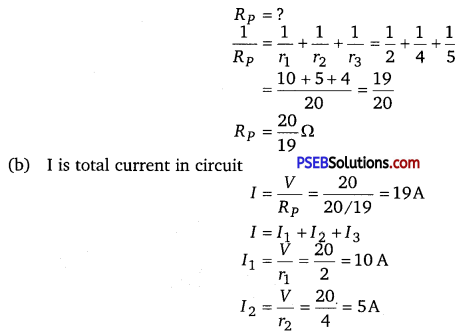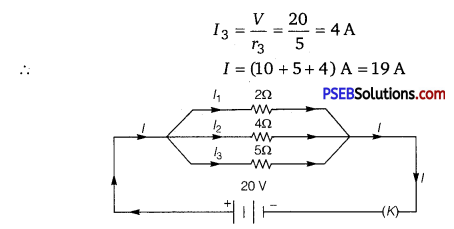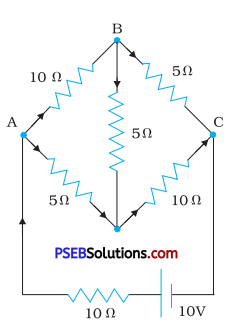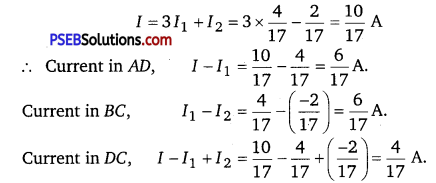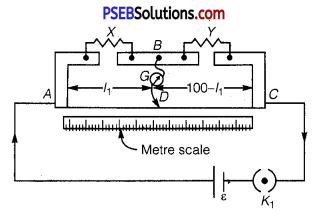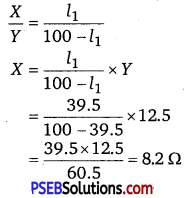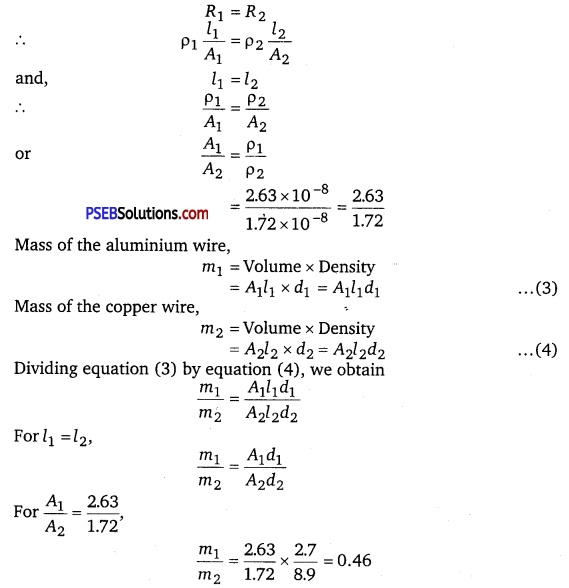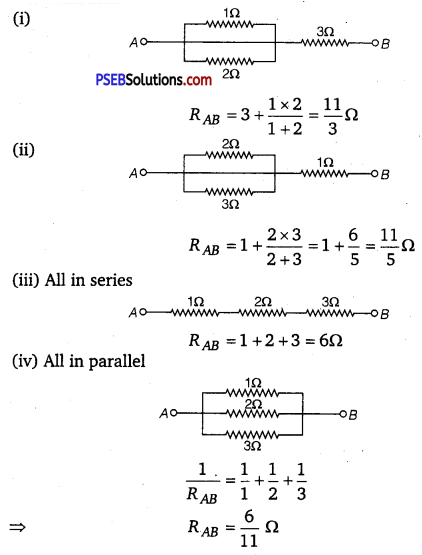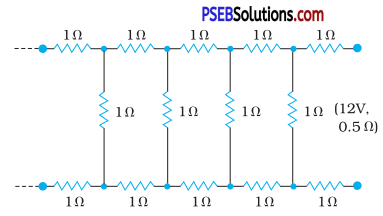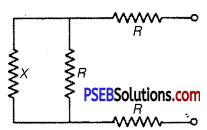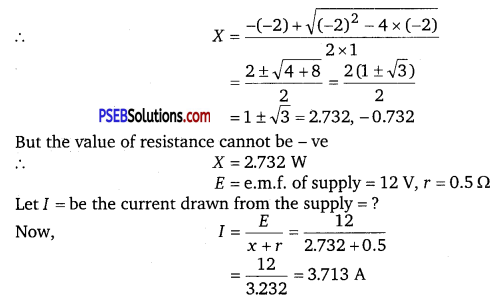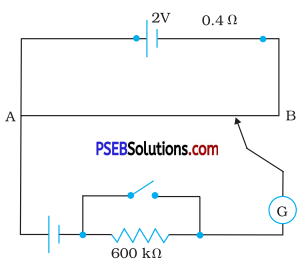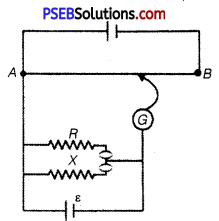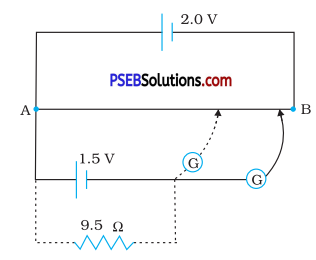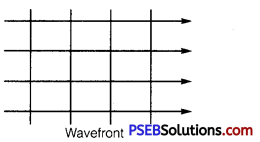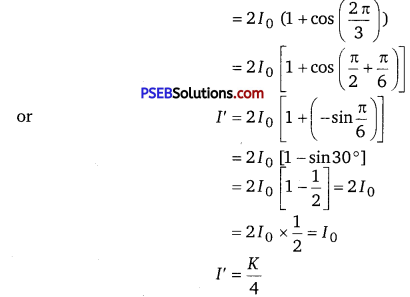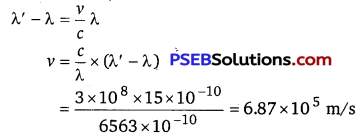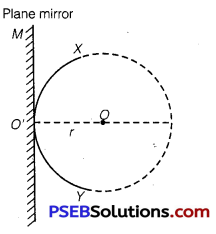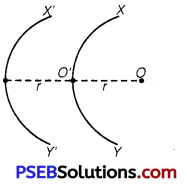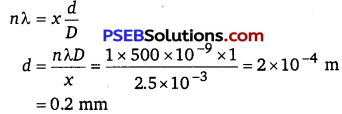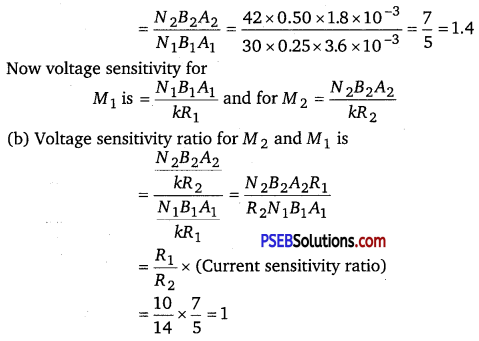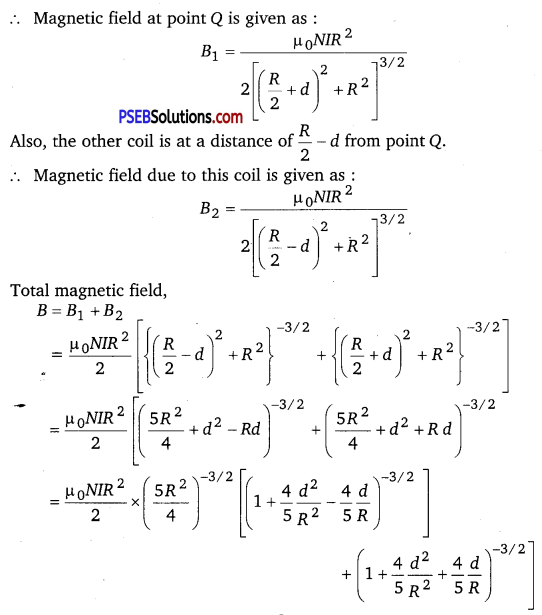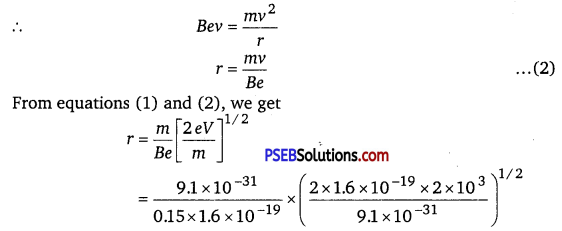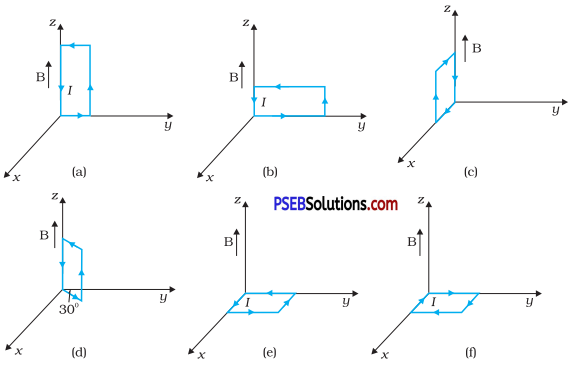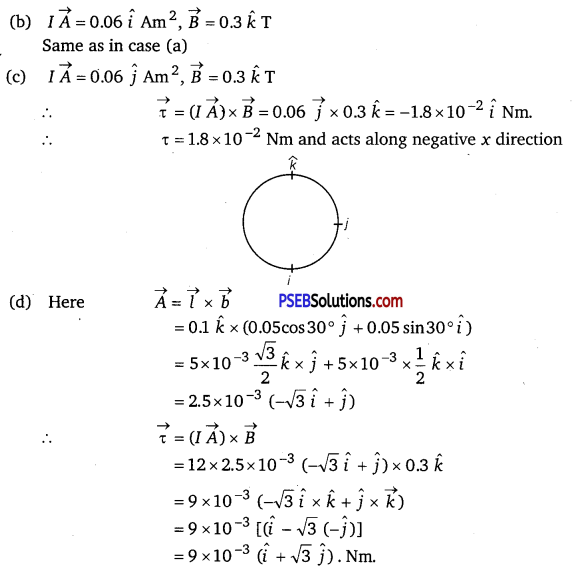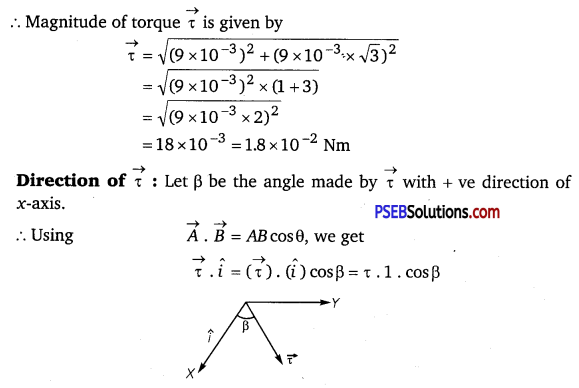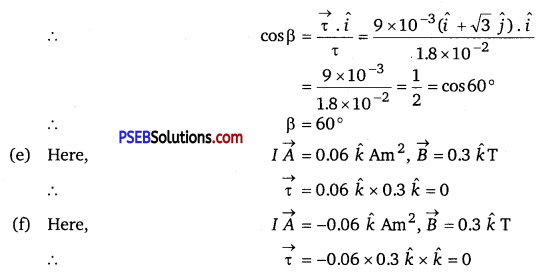Punjab State Board PSEB 12th Class Physical Education Book Solutions Chapter 1 ਸਰੀਰਕ ਯੋਗਤਾ Textbook Exercise Questions and Answers.
PSEB Solutions for Class 12 Physical Education Chapter 1 ਸਰੀਰਕ ਯੋਗਤਾ
Physical Education Guide for Class 12 PSEB ਸਰੀਰਕ ਯੋਗਤਾ Textbook Questions and Answers
ਇੱਕ ਅੰਕ ਵਾਲੇ ਪ੍ਰਸ਼ਨ-ਉੱਤਰ (One Mark Question Answers)
ਪ੍ਰਸ਼ਨ 1.
ਤਾਕਤ ਕਿੰਨੇ ਪ੍ਰਕਾਰ ਦੀ ਹੁੰਦੀ ਹੈ ? ਉੱਤਰ-ਤਾਕਤ ਦੋ ਪ੍ਰਕਾਰ ਦੀ ਹੁੰਦੀ ਹੈ-
- ਸਥਿਰ ਤਾਕਤ,
- ਗਤੀਸ਼ੀਲ ਤਾਕਤ !
ਪ੍ਰਸ਼ਨ 2.
ਸਰੀਰਕ ਯੋਗਤਾ ਦੇ ਕਿੰਨੇ ਅੰਗ ਹੁੰਦੇ ਹਨ ?
ਉੱਤਰ:
ਤਾਕਤ, ਸਹਿਣਸ਼ੀਲਤਾ, ਰਫਤਾਰ, ਲੱਚਕ, ਫੁਰਤੀ ਅਤੇ ਤਾਲਮੇਲ ਯੋਗਤਾ ।
ਪ੍ਰਸ਼ਨ 3.
ਛੋਟੀ ਦੂਰੀ ਦੀਆਂ ਦੌੜਾਂ ਦੱਸੋ ।
ਉੱਤਰ:
100 ਮੀ., 200 ਮੀ., 400 ਮੀ., 100 ਹਰਡਲ ਅਤੇ 110 ਮੀ. ਹਰਡਲ, 4 × 100 ਰਿਲੇਅ ਅਤੇ 4 × 200 ਰਿਲੇਅ ।
ਪ੍ਰਸ਼ਨ 4.
ਸੁਸਤ ਲਚਕ ਵੱਧ ਹੁੰਦੀ ਹੈ ਜਾਂ ਚੁਸਤ ਲਚਕ ?
ਉੱਤਰ:
ਸੁਸਤ ਲਚਕ ।
ਦੋ ਅੰਕਾਂ ਵਾਲੇ ਪ੍ਰਸ਼ਨ-ਉੱਤਰ (Two Marks Question Answers)
ਪ੍ਰਸ਼ਨ 5.
ਮੱਧ ਸਮੇਂ ਦੀ ਸਹਿਨਸ਼ੀਲਤਾ ਕੀ ਹੈ ?
ਉੱਤਰ:
ਮੱਧ ਸਮੇਂ ਦੀ ਸਹਿਣਸ਼ੀਲਤਾ (Middle Term Endurance)-ਇਸ ਦੀ ਜ਼ਰੂਰਤ ਉਹਨਾਂ ਮੁਕਾਬਲਿਆਂ ਵਿਚ ਪੈਂਦੀ ਹੈ ਜੋ ਕਿ 2 ਤੋਂ 10 ਮਿੰਟ ਵਿਚ ਖ਼ਤਮ ਹੋ ਜਾਂਦੇ ਹਨ , ਜਿਵੇਂ ਕਿ ਮੱਧ ਦੂਰੀ ਦੀਆਂ ਦੌੜਾਂ ਇਸ ਦੀਆਂ ਉਦਾਹਰਣਾਂ ਹਨ ।

ਪ੍ਰਸ਼ਨ 6.
ਲੰਮੇ ਸਮੇਂ ਦੀ ਸਹਿਣਸ਼ੀਲਤਾ ਬਾਰੇ ਤੁਸੀਂ ਕੀ ਜਾਣਦੇ ਹੋ ?
ਉੱਤਰ:
ਲੰਬੇ ਸਮੇਂ ਦੀ ਸਹਿਣਸ਼ੀਲਤਾ (Long Term Endurance) – ਇਸ ਕਿਸਮ ਦੀ ਸਹਿਣਸ਼ੀਲਤਾ ਐਰੋਬਿਕ ਊਰਜਾ ਪ੍ਰਣਾਲੀ ‘ਤੇ ਨਿਰਭਰ ਕਰਦੀ ਹੈ । ਲੰਬੇ ਸਮੇਂ ਦੀ ਸਹਿਣਸ਼ੀਲਤਾ ਦਾ ਵਿਕਾਸ ਉਹਨਾਂ ਮੁਕਾਬਲਿਆਂ ਲਈ ਕੀਤਾ ਜਾਂਦਾ ਹੈ ਜੋ ਕਿ 10 ਮਿੰਟ ਜਾਂ ਇਸ ਤੋਂ ਵੀ ਵੱਧ ਸਮੇਂ ਲਈ ਖੇਡੇ ਜਾਂਦੇ ਹਨ । ਜਿਵੇਂ ਕਿ ਮੈਰਾਥਨ, 5000 ਮੀਟਰ ਅਤੇ ‘ 10,000 ਮੀਟਰ ਦੀਆਂ ਦੌੜਾਂ ਇਸ ਦੀਆਂ ਉਦਾਹਰਨਾਂ ਹਨ ।
ਪ੍ਰਸ਼ਨ 7.
ਸੁਸਤ ਲਚਕ ਬਾਰੇ ਤੁਸੀਂ ਕੀ ਜਾਣਦੇ ਹੋ ?
ਉੱਤਰ:
ਸੁਸਤ ਲਚਕ (Passive Flexibility) – ਇਹ ਬਿਨਾਂ ਕਿਸੇ ਬਾਹਰੀ ਮੱਦਦ ਜਾਂ ਸਹਾਰੇ ਦੇ ਵੱਡੀ ਦਰ ਤੇ ਕ੍ਰਿਆਵਾਂ ਕਰਨ ਦੀ ਯੋਗਤਾ ਹੁੰਦੀ ਹੈ । ਉਦਾਹਰਨ ਦੇ ਤੌਰ ਤੇ ਕਿਸੇ ਸਾਥੀ ਖਿਡਾਰੀ ਦੀ ਮਦਦ ਨਾਲ ਸਚਿੰਗ (Stretching) ਕਸਰਤਾਂ ਕਰਨਾ । ਇਹ ਚੁਸਤ ਲਚਕ ਤੋਂ ਵੱਧ ਹੁੰਦੀ ਹੈ ।
ਤਿੰਨ ਅੰਕਾਂ ਵਾਲੇ ਪ੍ਰਸ਼ਨ-ਉੱਤਰ (Three Marks Question Answers)
ਪ੍ਰਸ਼ਨ 8.
ਸਹਿਣਸ਼ੀਲਤਾ ਨੂੰ ਕਿੰਨੇ ਭਾਗਾਂ ਵਿੱਚ ਵੰਡਿਆ ਗਿਆ ਹੈ ? ਇਹਨਾਂ ਬਾਰੇ ਵਿਸਥਾਰਪੂਰਵਕ ਜਾਣਕਾਰੀ ਦਿਉ ।
ਉੱਤਰ:
ਸਹਿਣਸ਼ੀਲਤਾ ਦੇ ਪ੍ਰਕਾਰ (Types of Endurance) – ਲੋੜਾਂ ਮੁਤਾਬਿਕ ਸਹਿਣਸ਼ੀਲਤਾ ਨੂੰ ਹੇਠ ਲਿਖੇ ਭਾਗਾਂ ਵਿਚ ਵੰਡਿਆ ਜਾ ਸਕਦਾ ਹੈ-
1. ਕਿਆ ਦੇ ਸੁਭਾਅ ਅਨੁਸਾਰ (As per Nature of the Activity)
(ਉ) ਬੁਨਿਆਦੀ ਸਹਿਣਸ਼ੀਲਤਾ (Basic Endurance) – ਬੁਨਿਆਦੀ ਸਹਿਣਸ਼ੀਲਤਾ ਮੁੱਖ ਤੌਰ ਤੇ ਐਰੋਬਿਕ ਸਹਿਣਸ਼ੀਲਤਾ ਤੇ ਨਿਰਭਰ ਕਰਦੀ ਹੈ । ਐਰੋਬਿਕ ਤੋਂ ਭਾਵ ਹੈ ਕਿ ਜਿਸ ਵਿਚ ਆਕਸੀਜਨ ਦੀ ਪੂਰਤੀ ਕਸਰਤਾਂ ਅਤੇ ਅਭਿਆਸ ਨਾਲ ਮਿਲਦੀ ਰਹੇ । ਇਹ ਹੌਲੀ-ਹੌਲੀ ਕੀਤੀਆਂ ਜਾਂਦੀਆਂ ਹਨ ਜਿਸ ਵਿਚ ਸਰੀਰ ਦੇ ਸਾਰੇ ਮਸਲ ਗਰੁੱਪ ਭਾਗ ਲੈਂਦੇ ਹਨ ਜਾਂ ਸ਼ਾਮਲ ਹੁੰਦੇ ਹਨ । ਦੌੜਨਾ, ਜੋਗਿੰਗ, ਚੱਲਣਾ ਅਤੇ ਤੈਰਾਕੀ ਬੁਨਿਆਦੀ ਸਹਿਣਸ਼ੀਲਤਾ ਦੇ ਉਦਾਹਰਨ ਹਨ ।
(ਅ) ਆਮ ਸਹਿਣਸ਼ੀਲਤਾ (General Endurance – ਇਹ ਐਰੋਬਿਕਸ ਅਤੇ ਐਨਰੋਬਿਕਸ ਦੋਵੇਂ ਕ੍ਰਿਆਵਾਂ ‘ਤੇ ਨਿਰਭਰ ਕਰਦੀ ਹੈ । ਇਹ ਹੌਲੀ ਅਤੇ ਤੇਜ਼ ਗਤੀ ਦੋਵਾਂ ਪ੍ਰਕਾਰਾਂ ਨਾਲ ਕੀਤੀ ਜਾਂਦੀ ਹੈ । ਇਹ ਸਹਿਣਸ਼ੀਲਤਾ ਖਿਡਾਰੀ ਨੂੰ ਬਿਨਾਂ ਥਕਾਵਟ ਦੇ ਲੰਬੇ ਸਮੇਂ ਦੇ ਕੰਮ ਕਰਨ ਦੇ ਯੋਗ ਬਣਾਉਂਦੀ ਹੈ ।
(ਬ) ਵਿਸ਼ੇਸ਼ ਸਹਿਣਸ਼ੀਲਤਾ (Specific Endurance) – ਵਿਸ਼ੇਸ਼ ਸਹਿਣਸ਼ੀਲਤਾ ਹਰ ਖੇਡ ਲਈ ਅਲੱਗ-ਅਲੱਗ ਹੁੰਦੀ ਹੈ । ਹਰ ਖੇਡ ਦੀ ਆਪਣੀ ਗਤੀ ਹੁੰਦੀ ਹੈ , ਜਿਵੇਂ ਕਿ ਮੈਰਾਥਨ ਦੌੜਾਕਾਂ ਨੂੰ ਲੰਬੇ ਸਮੇਂ ਤੱਕ ਕਿਰਿਆ ਵੀ ਕਿਹਾ ਜਾਂਦਾ ਹੈ:ਜਿਵੇਂ ਕਿ ਛੋਟੀਆਂ ਦੌੜਾਂ ; ਜਿਵੇਂ (ਸਪਰਿੰਟ) ਤੇ ਮੱਧ ਦੂਰੀ ਦੀਆਂ ਦੌੜਾਂ ਆਦਿ ਇਸ ਦੇ ਉਦਾਹਰਨ ਹਨ ।
(ਅ) ਮੱਧ ਸਮੇਂ ਦੀ ਸਹਿਣਸ਼ੀਲਤਾ (Middle Term Endurance) – ਇਸ ਦੀ ਜ਼ਰੂਰਤ ਉਹਨਾਂ ਮੁਕਾਬਲਿਆਂ ਵਿਚ ਪੈਂਦੀ ਹੈ ਜੋ ਕਿ 2 ਤੋਂ 10 ਮਿੰਟ ਵਿਚ ਖ਼ਤਮ ਹੋ ਜਾਂਦੇ ਹਨ , ਜਿਵੇਂ ਕਿ ਮੱਧ ਦੁਰੀ ਦੀਆਂ ਦੌੜਾਂ ਇਸ ਦੀਆਂ ਉਦਾਹਰਨਾਂ ਹਨ । ਇਸ ਸਹਿਣਸ਼ੀਲਤਾ ਨੂੰ ਐਨਰੋਬਿਕ ਸਹਿਣਸ਼ੀਲਤਾ ਵੀ ਕਿਹਾ ਜਾਂਦਾ ਹੈ ।
(ਇ) ਲੰਬੇ ਸਮੇਂ ਦੀ ਸਹਿਣਸ਼ੀਲਤਾ (Long Term Endurance) – ਇਸ ਕਿਸਮ ਦੀ ਸਹਿਣਸ਼ੀਲਤਾ ਐਰੋਬਿਕ ਊਰਜਾ ਪ੍ਰਣਾਲੀ ‘ਤੇ ਨਿਰਭਰ ਕਰਦੀ ਹੈ । ਲੰਬੇ ਸਮੇਂ ਦੀ ਸਹਿਣਸ਼ੀਲਤਾ ਦਾ ਵਿਕਾਸ ਉਹਨਾਂ ਮੁਕਾਬਲਿਆਂ ਲਈ ਕੀਤਾ ਜਾਂਦਾ ਹੈ ਜੋ ਕਿ 10 ਮਿੰਟ ਜਾਂ ਇਸ ਤੋਂ ਵੀ ਵੱਧ ਸਮੇਂ ਲਈ ਖੇਡੇ ਜਾਂਦੇ ਹਨ , ਜਿਵੇਂ ਕਿ ਮੈਰਾਥਨ, 5000 ਮੀਟਰ ਅਤੇ 10,000 ਮੀਟਰ ਦੀਆਂ ਦੌੜਾਂ ਇਸ ਦੀਆਂ ਉਦਾਹਰਨਾਂ ਹਨ ।

ਪ੍ਰਸ਼ਨ 9.
ਹੇਠ ਲਿਖਿਆਂ ਵਿੱਚੋਂ ਕਿਸੇ ਇੱਕ ‘ਤੇ ਨੋਟ ਲਿਖੋ । (ਉ) ਗਤੀ (ਅ) ਲਚਕ (ਬ) ਤਾਲਮੇਲ ਯੋਗਤਾ ।
ਉੱਤਰ:
(ੳ) ਗਤੀ (ਰਫਤਾਰ) (Speed)-ਗਤੀ ਇਕ ਅਧਿਕਤਮ ਦਰ ਹੁੰਦੀ ਹੈ, ਜਿਸ ਵਿਚ ਇਕ ਵਿਅਕਤੀ ਇਕ ਵਿਸ਼ੇਸ਼ ਦੂਰੀ ਨੂੰ ਤੈਅ ਕਰਨ ਲਈ ਆਪਣੇ ਸਰੀਰ ਵਿਚ ਗਤੀ ਲੈ ਕੇ ਆਉਂਦਾ ਹੈ । ਅਸੀਂ ਕਹਿ ਸਕਦੇ ਹਾਂ ਕਿ ਰਫਤਾਰ ਘੱਟ ਤੋਂ ਘੱਟ ਮੁਸ਼ਕਿਲ ਸਮੇਂ ਵਿਚ ਇਕ ਥਾਂ ਤੋਂ ਦੂਜੀ ਥਾਂ ਤੇ ਪਹੁੰਚਣ ਦੀ ਯੋਗਤਾ ਹੁੰਦੀ ਹੈ । ਇਹ ਯੋਗਤਾ ਜ਼ਿਆਦਾਤਰ ਜਨਮ-ਜਾਤ ਵਿਤੀ ‘ਤੇ ਨਿਰਭਰ ਕਰਦੀ ਹੈ । ਇਸ ਲਈ ਅਸੀਂ ਜਟਿਲ ਅਭਿਆਸ ਤੋਂ ਬਾਅਦ ਵੀ ਸਿਰਫ 20% ਗਤੀ ਹੀ ਵਿਕਸਿਤ ਕਰ ਸਕਦੇ ਹਾਂ | ਤਦ ਹੀ ਕਿਹਾ ਜਾਂਦਾ ਹੈ ਕਿ ਤੇਜ਼ ਦੌੜਾਕ ਜਨਮ ਲੈਂਦੇ ਹਨ, ਬਣਾਏ ਨਹੀਂ ਜਾਂਦੇ ।
ਰਫਤਾਰ ਦੇ ਪ੍ਰਕਾਰ (Types of Speed)
1. ਪ੍ਰਤੀਕ੍ਰਿਆ ਰਫਤਾਰ (Reaction Speed) – ਇਹ ਸਿਗਨਲ ਮਿਲਣ ਤੇ ਤੁਰੰਤ ਪ੍ਰਤੀਕ੍ਰਿਆ ਕਰਨ ਦੀ ਯੋਗਤਾ ਹੁੰਦੀ ਹੈ । ਇਸ ਵਿਚ ਖਿਡਾਰੀ ਪ੍ਰਸਥਿਤੀ ਦੇ ਵਿਰੁੱਧ ਪ੍ਰਤੀਕ੍ਰਿਆ ਕਰਦਾ ਹੈ , ਜਿਵੇਂ ਕਿ ਕੋਚ (Coach) ਦੀ ਸੀਟੀ ਵੱਜਣ ਤੇ ਅੱਗੇ ਵੱਲ, ਪਿੱਛੇ ਵੱਲ, ਖੱਬੇ ਅਤੇ ਸੱਜੇ ਪਾਸੇ ਤੇਜ਼ ਗਤੀ ਨਾਲ ਜਾਣਾ ਆਦਿ ।
2. ਗਤੀ ਦੀ ਯੋਗਤਾ (Acceleration Ability) – ਇਹ ਸਥਿਰ (Stationary) ਅਵਸਥਾ ਤੋਂ ਵੱਧ ਤੋਂ ਵੱਧ (Maximum) ਰਫਤਾਰ ਵਿਚ ਇਕਦਮ ਜਾਣ ਦੀ ਯੋਗਤਾ ਹੈ : ਜਿਵੇਂ ਕਿ ਅਸੀਂ ਇਹਨਾਂ ਨੂੰ ਸਪਰਿੰਟ (Sprint) ਛੋਟੀ ਦੂਰੀ ਦੀਆਂ ਦੌੜਾਂ ਵਿਚ ਦੇਖ ਸਕਦੇ ਹਾਂ ਜਿੱਥੇ ਇਕ ਵਿਸਫੋਟਕ ਤਾਕਤ, ਤਕਨੀਕ ਅਤੇ ਲਚਕ ਦੀ ਜ਼ਰੂਰਤ ਪੈਂਦੀ ਹੈ ।
3. ਲੋਕੋਮੋਟਰ ਜਾਂ ਗਮਨ ਦੀ ਯੋਗਤਾ ਜਾਂ ਇੰਜਣ ਯੋਗਤਾ (Locomotor Ability) – ਇਹ ਇਕਦਮ ਰਫਤਾਰ ਬਣਾ ਕੇ ਉਸਨੂੰ ਉਸੇ ਸਥਿਤੀ ਵਿਚ ਬਣਾਏ ਰੱਖਣ ਦੀ ਯੋਗਤਾ ਹੈ । ਜਿਵੇਂ ਕਿ ਛੋਟੀ ਦੁਰੀ ਦੀਆਂ ਦੌੜਾਂ 100 ਮੀ: 200 ਮੀ: ਅਤੇ 400 ਮੀ: ਆਦਿ ਇਸ ਦੀਆਂ ਉਦਾਹਰਣਾਂ ਹਨ ।
4. ਸੰਚਲਨ ਵੇਗ (Movement Speed) – ਇਹ ਉਹ ਯੋਗਤਾ ਜਿਸ ਵਿਚ ਘੱਟ ਤੋਂ ਘੱਟ ਸਮੇਂ ਵਿਚ ਵੱਧ ਤੋਂ ਵੱਧ | ਕ੍ਰਿਆ ਨੂੰ ਪੂਰਾ ਕੀਤਾ ਜਾਂਦਾ ਹੈ ।
5. ਰਫ਼ਤਾਰ ਸਹਿਣਸ਼ੀਲਤਾ (Speed Endurance) – ਇਹ ਉਹ ਯੋਗਤਾ ਹੁੰਦੀ ਹੈ ਜਿਸ ਵਿਚ ਖਿਡਾਰੀ ਆਪਣੀ ਰਫ਼ਤਾਰ ਨੂੰ ਖੇਡ ਦੇ ਆਖਰੀ ਪੜਾਅ ਤਕ ਬਣਾ ਕੇ ਰੱਖਦਾ ਹੈ ।
(ਅ) ਲਚਕ (Flexibility) – ਲਚਕ ਗਤੀਸ਼ੀਲਤਾ ਦੀ ਉਹ ਦਰ ਜੋ ਕਿ ਜੋੜਾਂ ਤੇ ਸੰਭਵ ਹੁੰਦੀ ਹੈ | ਅਸੀਂ ਆਮ ਸ਼ਬਦਾਂ ਵਿਚ ਇਹ ਕਹਿ ਸਕਦੇ ਹਾਂ ਕਿ ਲਚਕ ਨੂੰ ਸੁਸਤ (Passive) ਕ੍ਰਿਆਵਾਂ ਦੇ ਦੌਰਾਨ, ਜੋੜਾਂ ਅਤੇ ਉਹਨਾਂ ਦੇ ਆਸਪਾਸ ਦੀਆਂ ਮਾਸਪੇਸ਼ੀਆਂ (Muscles) ਦੀ ਗਤੀ ਦੀ ਦਰ ਦੇ ਰੂਪ ਵਿਚ ਪਰਿਭਾਸ਼ਿਤ ਕੀਤਾ ਜਾ ਸਕਦਾ ਹੈ । ‘ ਲਚਕ ਹੋਰਨਾਂ ਸਰੀਰਕ ਗੁਣਾਂ ਵਾਂਗ ਇਕ ਬਹੁਮੁੱਲਾ ਗੁਣ ਹੈ ਅਤੇ ਸਰੀਰਕ ਸਿੱਖਿਆ ਅਤੇ ਖਿਡਾਰੀਆਂ ਵਿਚ ਇਸਦੀ ਆਪਣੀ ਮਹੱਤਤਾ ਹੈ ਕਿਉਂਕਿ ਲਚਕਦਾਰ ਖਿਡਾਰੀ ਮੈਦਾਨ ਵਿਚ ਕਈ ਤਰ੍ਹਾਂ ਦੀਆਂ ਸੱਟਾਂ ਤੋਂ ਬਚਿਆ ਰਹਿੰਦਾ ਹੈ । ਲਚਕ ਦੇ ਕਈ ਪ੍ਰਕਾਰ ਹੁੰਦੇ ਹਨ ਅਤੇ ਇਹਨਾਂ ਦਾ ਵਰਗੀਕਰਨ ਹੇਠ ਲਿਖੇ ਅਨੁਸਾਰ ਹੈ-
ਸਥਿਰ ਲਚਕ (Static Flexibility) – ਇਹ ਸਥਿਰ ਲਚਕ ਸਰੀਰਕ ਜੋੜਾਂ ਨੂੰ ਸਥਿਰ ਸਥਿਤੀ ਵਿਚ ਰੱਖਣ ਦੀ ਯੋਗਤਾ ਹੈ ।
(i) ਸੁਸਤ ਲਚਕ (Passive Flexibility) – ਇਹ ਬਿਨਾਂ ਕਿਸੇ ਬਾਹਰੀ ਮੱਦਦ ਜਾਂ ਸਹਾਰੇ ਦੇ ਵੱਡੀ ਦਰ ਤੇ ਕ੍ਰਿਆਵਾਂ ਕਰਨ ਦੀ ਯੋਗਤਾ ਹੁੰਦੀ ਹੈ । ਉਦਾਹਰਨ ਦੇ ਤੌਰ ਤੇ ਕਿਸੇ ਸਾਥੀ ਖਿਡਾਰੀ ਦੀ ਮਦਦ ਨਾਲ ਸਚਿੰਗ (Stretching) ਕਸਰਤਾਂ ਕਰਨਾ । ਇਹ ਚੁਸਤ ਲਚਕ ਤੋਂ ਵੱਧ ਹੁੰਦੀ ਹੈ ।
(ii) ਚੁਸਤ ਲਚਕ (Active Flexibility – ਇਹ ਬਿਨਾਂ ਕਿਸੇ ਬਾਹਰੀ ਮੱਦਦ ਜਾਂ ਸਹਾਰੇ ਤੋਂ ਕ੍ਰਿਆਵਾਂ ਕਰਨ ਦੀ ਦਰ ਦੀ ਯੋਗਤਾ ਹੈ । ਉਦਾਹਰਨ ਦੇ ਤੌਰ ਤੇ ਲੱਤਾਂ ਨੂੰ ਝੂਲਾਉਣਾ ਆਦਿ ।
(iii) ਗਤੀਸ਼ੀਲ ਲਚਕ (Dynamic Flexibility) – ਇਹ ਉਹ ਲਚਕ ਹੁੰਦੀ ਹੈ ਜਦ ਸਰੀਰ ਗਤੀ ਵਿਚ ਹੁੰਦਾ ਹੈ ਅਤੇ ਕ੍ਰਿਆਵਾਂ ਪ੍ਰਦਰਸ਼ਨ ਕਰਦਾ ਹੈ । ਜਿਵੇਂ ਕਿ ਦੌੜਨਾ, ਤੈਰਨਾ ਜਾਂ ਸਮਰਸੱਲਟ (Samersault) ਆਦਿ ।
(ਇ) ਤਾਲਮੇਲ ਯੋਗਤਾ (Coordination Ability) – ਤਾਲਮੇਲ ਦੀ ਯੋਗਤਾ ਉਹ ਯੋਗਤਾ ਹੁੰਦੀ ਹੈ ਜਿਸ ਵਿਚ ਮੋਟਰ ਟਾਸਕ (Motor task) ਸਹਜ ਅਤੇ ਸਹੀ ਢੰਗ ਨਾਲ ਕੀਤੇ ਜਾਂਦੇ ਹਨ ਅਤੇ ਜਿਸ ਵਿਚ ਇੰਦਰੀਆਂ ਅਤੇ ਮਾਸਪੇਸ਼ੀਆਂ ਦੀ ਸੁੰਗੜਨ ਦਾ ਪਰਸਪਰ ਸੰਬੰਧ ਹੁੰਦਾ ਹੈ ਅਤੇ ਜੋ ਕਿ ਜੋੜਾਂ ਦੀ ਗਤੀ ਅਤੇ ਉਸਦੇ ਆਸ-ਪਾਸ ਦੇ ਅੰਗਾਂ ਅਤੇ ਸਰੀਰ ਦੀ ਸਥਿਤੀ ‘ਤੇ ਨਿਰਭਰ ਕਰਦੀ ਹੈ । ਤਾਲਮੇਲ ਸਨਾਯੁਤੰਤਰ ਤੇ ਵੀ ਨਿਰਭਰ ਕਰਦਾ ਹੈ । ਸਰੀਰਕ ਤੰਦਰੁਸਤੀ ਵਿਚ ਤਾਲਮੇਲ ਦਾ ਅਹਿਮ ਰੋਲ ਹੈ ਜਿਸ ਤੋਂ ਬਿਨਾਂ ਕੋਈ ਵੀ ਖੇਡ ਜਾਂ ਕ੍ਰਿਆ ਸੰਭਵ ਹੀ ਨਹੀਂ ਹੈ ।
ਤਾਲਮੇਲ ਦੇ ਪ੍ਰਕਾਰ (Types of co-ordination) – ਖੇਡਾਂ ਦੀ ਦੁਨੀਆਂ ਵਿਚ ਮੁੱਖ ਤੌਰ ਤੇ ਸੱਤ (7) ਪ੍ਰਕਾਰ ਦੀ ਤਾਲਮੇਲ ਯੋਗਤਾ ਪਾਈ ਜਾਂਦੀ ਹੈ
1. ਹਿਣ ਯੋਗਤਾ (Orientation Ability) – ਇਹ ਵਿਅਕਤੀ ਦੀ ਉਹ ਯੋਗਤਾ ਹੈ ਜਿਸ ਵਿਚ ਉਹ ਜ਼ਰੂਰਤ ਅਨੁਸਾਰ ਸਥਾਨ ਅਤੇ ਸਮੇਂ ਤੇ ਆਪਣੇ ਸਰੀਰ ਦਾ ਵਿਸ਼ਲੇਸ਼ਣ ਕਰਕੇ ਪਰਿਵਰਤਨ ਕਰ ਲੈਂਦਾ ਹੈ । ਉਦਾਹਰਨ ਦੇ ਤੌਰ ਤੇ ਜਿਮਨਾਸਟਿਕ ਵਿਚ ਖੇਡ ਪ੍ਰਦਰਸ਼ਨ ਮੁਤਾਬਿਕ ਸਰੀਰ ਦੀ ਸਥਿਤੀ ਨੂੰ ਬਦਲਣਾ, ਬਾਸਕਟਬਾਲ ਵਿਚ ਅਫੈਨਸ ਤੇ ਡੀਫੈਨਸ (Offense and defense) ਵਿਚ ਆਪਣੇ ਸਰੀਰ ਦੀ ਸਥਿਤੀ ਵਿਚ ਬਦਲਾਵ ਕਰ ਲੈਂਦਾ ਹੈ ।
2. ਸੰਯੋਜਨ ਦੀ ਯੋਗਤਾ (Coupling Ability) – ਇਹ ਵਿਅਕਤੀ ਦੀ ਉਹ ਯੋਗਤਾ ਹੈ ਜਿਸ ਵਿਚ ਉਹ ਸਰੀਰ ਦੇ ਅੰਗਾਂ ਨੂੰ ਗਤੀ ਵਿਚ ਅਰਥਪੂਰਨ ਢੰਗ ਨਾਲ ਸੰਯੋਜਨ ਕਰਕੇ ਕੀਤਾ ਜਾਂਦਾ ਹੈ , ਜਿਵੇਂ ਵਾਲੀਬਾਲ ਵਿਚ ਸਪਾਈਕਿੰਗ ਦੇ ਦੌਰਾਨ ਖਿਡਾਰੀ ਤੇਜ਼ ਗਤੀ ਨਾਲ ਜੰਪ ਕਰਦਾ ਹੈ | ਬਾਲ ਨੂੰ ਹਿੱਟ ਕਰਦਾ ਹੈ । ਇਸ ਸਮੇਂ
ਉਸ ਦੇ ਸਰੀਰ ਦੇ ਸਾਰੇ ਅੰਗਾਂ ਵਿਚ ਇਕਸਾਰਤਾ ਦਾ ਤਾਲਮੇਲ ਹੁੰਦਾ ਹੈ ।
3. ਅੰਤਰ ਯੋਗਤਾ (Differentiation Ability – ਇਹ ਵਿਅਕਤੀ ਦੀ ਉਹ ਯੋਗਤਾ ਹੁੰਦੀ ਹੈ ਜਿਸ ਖਿਡਾਰੀ ਮੋਟਰ ਐਕਸ਼ਨ (Motor action) ਦੇ ਦੌਰਾਨ ਸਰੀਰ ਦੇ ਅਲੱਗ-ਅਲੱਗ ਅੰਗਾਂ ਤੋਂ ਕਿਆ ਕਰਵਾਉਣ ਦੀ ਸਮਰੱਥਾ ਦਾ ਪ੍ਰਦਰਸ਼ਨ ਕਰਦਾ ਹੈ , ਜਿਵੇਂ ਕਿ ਵਾਲੀਬਾਲ ਵਿਚ ਸਪਾਈਕਿੰਗ ਜੰਪ ਦੇ ਦੌਰਾਨ ਸਥਿਤੀ ਦੇ
ਅਨੁਸਾਰ ਬਾਲ ਨੂੰ ਸੁੱਟਣਾ (Drop) ।
4. ਪ੍ਰਤੀਕ੍ਰਿਆ ਕਰਨ ਦੀ ਯੋਗਤਾ (Reaction Ability) – ਇਹ ਵਿਅਕਤੀ ਦੀ ਉਹ ਯੋਗਤਾ ਹੈ ਜਿਸ ਵਿਚ ਸਿੰਗਨਲ ਮਿਲਣ ਤੇ ਖਿਡਾਰੀ ਪ੍ਰਤੀਕ੍ਰਿਆ ਕਰਦਾ ਹੈ , ਜਿਵੇਂ 100 ਮੀ: ਦੌੜ ਵਿਚ ਸਿੰਗਨਲ ਹੁੰਦੇ ਹੀ ਇਕ ਵੇ ਤੇ ਦਿਸ਼ਾ ਵੱਲ ਤੇਜ਼ ਗਤੀ ਨਾਲ ਦੌੜਨਾ ।
5. ਸੰਤੁਲਨ ਯੋਗਤਾ (Balance Ability) – ਇਹ ਵਿਅਕਤੀ ਦੀ ਉਹ ਯੋਗਤਾ ਹੈ ਜਿਸ ਵਿਚ ਉਹ ਗਤੀ ਵਿਚ ਸਰੀਰ ਦੀ ਸਥਿਤੀ ਬਣਾਈ ਰੱਖਦਾ ਹੈ ਜਿਵੇਂ ਕਿ 400 ਮੀ: ਵਿਚ ਆਪਣੀ ਲਾਈਨ ਵਿਚ ਰਹਿ ਕੇ ਦੌੜਨਾ ਆਦਿ ।
6. ਲੈਅ ਦੀ ਯੋਗਤਾ (Rhythm Ability) – ਇਹ ਵਿਅਕਤੀ ਦੀ ਉਹ ਯੋਗਤਾ ਹੈ ਜਿਸ ਵਿਚ ਉਹ ਲੈਅ ਨੂੰ ਸਮਝਦੇ ਹੋਏ ਲੈਅ ਵਿਚ ਗਤੀ ਬਣਾ ਕੇ ਰੱਖਦਾ ਹੈ । ਉਦਾਹਰਨ ਦੇ ਤੌਰ ਤੇ ਬਾਸਕਟ ਬਾਲ ਵਿਚ ਲੈ-ਅੱਪ (Lay-up) ਸਾਂਟ ਲਗਾਉਣਾ ।
7. ਹਿਣ ਯੋਗਤਾ (Adaptation Ability) – ਇਹ ਵਿਅਕਤੀ ਦੀ ਉਹ ਯੋਗਤਾ ਹੈ ਜਿਸ ਵਿਚ ਉਹ ਪ੍ਰਸਥਿਤੀ ਨੂੰ ਸਮਝ ਕੇ ਉਸ ਵਿੱਚ ਪ੍ਰਭਾਵੀ ਪਰਿਵਰਤਨ ਲੈ ਕੇ ਆਵੇ । ਉਦਾਹਰਨ ਦੇ ਤੌਰ ਤੇ ਬਾਸਕਟ ਬਾਲ ਵਿਚ ਜੰਪ ਸਾਂਟ ਕਿਆ ਦੇ ਅਨੁਕੂਲ ਬਣਾਉਣਾ ਆਦਿ ।
ਪੰਜ ਅੰਕਾਂ ਵਾਲੇ ਪ੍ਰਸ਼ਨ-ਉੱਤਰ (Five Marks Question Answers)
ਪ੍ਰਸ਼ਨ 10.
ਸਰੀਰਕ ਯੋਗਤਾ ਦੀ ਮਹੱਤਤਾ ਬਾਰੇ ਤੁਸੀਂ ਕੀ ਜਾਣਦੇ ਹੋ ? ਵਿਸਥਾਰਪੂਰਵਕ ਲਿਖੋ ।
ਉੱਤਰ:
ਉਹ ਵਿਅਕਤੀ ਜੋ ਸਰੀਰਕ ਤੌਰ ਤੇ ਤੰਦਰੁਸਤ ਹਨ ਉਹ ਆਪਣੇ ਜੀਵਨ ਦਾ ਆਨੰਦ ਪੂਰੀ ਤਰ੍ਹਾਂ ਨਾਲ ਉਠਾਉਣ ਦੇ ਯੋਗ ਹਨ | ਅੱਜ ਦੇ ਤਕਨੀਕੀ ਵਿਕਾਸ ਦੇ ਯੁੱਗ ਵਿਚ ਲੋਕਾਂ ਕੋਲੋਂ ਮੁਸ਼ਕਿਲ ਨਾਲ ਹੀ ਆਪਣੀ ਸਰੀਰਕ ਤੰਦਰੁਸਤੀ ਲਈ ਸਮਾਂ ਹੁੰਦਾ ਹੈ । ਹੁਣ ਪ੍ਰਸ਼ਨ ਇਹ ਉੱਠਦਾ ਹੈ ਕਿ ਸਰੀਰਕ ਤੰਦਰੁਸਤ ਹੋਣਾ ਇੰਨਾ ਮਹੱਤਵਪੂਰਨ ਕਿਉਂ ਹੈ ? ਇਹਨਾਂ ਸਵਾਲਾਂ ਦਾ ਜਵਾਬ ਹੇਠ ਦਿੱਤੇ ਅਨੁਸਾਰ ਹੈ-
1. ਸੰਪੂਰਨ ਸਿਹਤ ਦਾ ਸੁਧਾਰ (Improves Overall Health) – ਸਰੀਰਕ ਤੌਰ ਤੇ ਤੰਦਰੁਸਤ ਵਿਅਕਤੀ ਕਈ ਤਰ੍ਹਾਂ ਦੇ ਸਰੀਰਕ ਫਾਇਦਿਆਂ ਨੂੰ ਮਾਣਦਾ ਹੈ , ਜਿਵੇਂ ਕਿ ਸਾਹ ਪ੍ਰਕ੍ਰਿਆ, ਲਹੂ ਸੰਚਾਰ ਪ੍ਰਣਾਲੀ ਅਤੇ ਸਰੀਰ ਦੀਆਂ ਸਮੁੱਚੀ ਪ੍ਰਣਾਲੀਆਂ ਦਾ ਠੀਕ ਢੰਗ ਨਾਲ ਕੰਮ ਕਰਨਾ ਅਤੇ ਸਰੀਰ ਦਾ ਕ੍ਰਿਆਤਮਕ ਰੂਪ ਵਿਚ ਤਿਆਰ ਰਹਿਣਾ ।ਉਹ ਕਈ ਤਰ੍ਹਾਂ ਦੀਆਂ ਬਿਮਾਰੀਆਂ ਜਿਵੇਂ ਡਾਈਬੀਟੀਜ਼ ਟਾਇਪ-2, ਦਿਲ ਦੀਆਂ ਬਿਮਾਰੀਆਂ, ਕੈਂਸਰ ਤੋਂ ਬਚਾਅ, ਆਦਿ ਤੋਂ ਬਚਿਆ ਰਹਿੰਦਾ ਹੈ ।
2. ਭਾਰ ਪ੍ਰਬੰਧਨ (Weight Management) – ਜਿਵੇਂ ਕਿ ਅਸੀਂ ਸਾਰੇ ਜਾਣਦੇ ਹਾਂ ਕਿ ਵਾਧੂ ਵਜ਼ਨ ਕਈ ਤਰ੍ਹਾਂ ਦੀਆਂ ਸਿਹਤ ਸੰਬੰਧੀ ਸਮੱਸਿਆਵਾਂ : ਜਿਵੇਂ ਕਿ ਉੱਚਾ ਖੁਨ ਚਾਪ (High Blood Pressure), ਕੈਸਟਰੋਲ ਪੱਧਰ, ਡਾਇਬਟੀਜ਼ ਆਦਿ ਦੀ ਜੜ੍ਹ ਹੈ । ਇਸ ਲਈ ਉਹ ਵਿਅਕਤੀ ਜੋ ਸਰਗਰਮ ਅਤੇ ਸਰੀਰਕ ਤੌਰ ਤੇ ਤੰਦਰੁਸਤ ਹੁੰਦੇ ਹਨ, ਉਹਨਾਂ ਵਿੱਚ ਉਪਰੋਕਤ ਬਿਮਾਰੀਆਂ ਦੀ ਸੰਭਾਵਨਾ ਘੱਟ ਹੁੰਦੀ ਹੈ ।
3. ਤਨਾਵ ਪ੍ਰਬੰਧ ਵਿਚ ਮਹੱਤਵਪੂਰਨ (Importance as a stress Management) – ਇਕ ਵਿਅਕਤੀ ਤੰਦਰੁਸਤੀ ਅਤੇ ਤੰਦਰੁਸਤੀ ਪ੍ਰੋਗਰਾਮ ਦੇ ਜਰੀਏ ਤਣਾਅ ਨੂੰ ਬਰਦਾਸ਼ਤ ਕਰਨਾ, ਉਸ ਤੋਂ ਬਾਹਰ ਨਿਕਲਣਾ ਅਤੇ ਰੋਜ਼ਮਰਾ ਦੇ ਵਿਚਿਲਤ ਕਰਨ ਵਾਲੇ ਤਣਾਅ ਤੇ ਕਾਬੂ ਪਾਉਣਾ ਸਿੱਖ ਲੈਂਦਾ ਹੈ । ਇਸ ਲਈ ਇਹ ਜੀਵਨ ਵਿੱਚ ਸੰਤੁਲਨ ਅਤੇ ਸ਼ਾਤੀ ਬਣਾਏ ਰੱਖਣ ਵਿਚ ਮਦਦ ਕਰਦਾ ਹੈ । ਇਸ ਲਈ ਜ਼ਰੂਰੀ ਹੈ ਕਿ ਜੀਵਨ ਵਿਚ ਸ਼ਾਂਤੀ ਬਣਾਈ ਰੱਖਣ ਲਈ ਵਿਅਕਤੀ ਦਾ ਤੰਦਰੁਸਤ ਹੋਣਾ ਜ਼ਰੂਰੀ ਹੈ ।
4. ਸੱਟਾਂ ਦੀ ਸੰਭਾਵਨਾ ਨੂੰ ਘਟਾਉਣਾ (Reduce risk of Injuries) – ਸਰੀਰਕ ਤੰਦਰੁਸਤੀ ਜੀਵਨ ਦੇ ਅਗਲੇ ਪੜਾਅ ਵਿਚ ਸੱਟਾਂ ਦੇ ਜ਼ੋਖ਼ਿਮ ਨੂੰ ਘਟਾਉਂਦੀ ਹੈ । ਇਸ ਦਾ ਕਾਰਨ ਮਾਸਪੇਸ਼ੀਆਂ ਦੀ ਤਾਕਤ, ਹੱਡੀਆਂ ਵਿਚਲੀ ਘਣਤਾ, ਲਚਕਤਾ ਅਤੇ ਸਥਿਰਤਾ ਹੁੰਦੀ ਹੈ ਜੋ ਕਿ ਸੱਟਾਂ ਦੀ ਸੰਭਾਵਨਾ ਨੂੰ ਘਟਾਉਂਦੀ ਹੈ ।
5. ਜੀਵਨ ਦੀ ਸੰਭਾਵਨਾ ਵਿਚ ਵਾਧਾ (Increases life Expectancy) – ਨਿਯਮਿਤ ਕਸਰਤਾਂ ਅਤੇ ਤੰਦਰੁਸਤੀ ਸੰਬੰਧਿਤ ਪ੍ਰੋਗਰਾਮ ਸਿਹਤ ਸੰਬੰਧਿਤ ਬਿਮਾਰੀਆਂ ਨੂੰ ਘਟਾਉਣ ਵਿਚ ਲਾਭਦਾਇਕ ਹੁੰਦੇ ਹਨ, ਜੋ ਕਿ ਉਮਰ ਦਰ ਦੀਆਂ ਸੰਭਾਵਨਾਵਾਂ ਨੂੰ ਵਧਾਉਂਦੀਆਂ ਹਨ ਅਤੇ ਸਮੇਂ ਤੋਂ ਪਹਿਲਾਂ ਹੋਣ ਵਾਲੀ ਮੌਤ ਦਰ ਨੂੰ ਘਟਾਉਂਦੀ ਹੈ । ਇਹ ਦੇਖਿਆ ਗਿਆ ਹੈ ਕਿ ਜੋ ਵਿਅਕਤੀ ਸਰੀਰਕ ਤੌਰ ਤੇ ਸਰਗਰਮ ਰਹਿੰਦੇ ਹਨ, ਉਹ ਸਵਸਥ ਅਤੇ ਲੰਬਾ ਜੀਵਨ ਗੁਜ਼ਾਰਦੇ ਹਨ ।
6. ਸਹੀ ਵਾਧਾ ਅਤੇ ਵਿਕਾਸ (Proper growth and Development) – ਤੰਦਰੁਸਤੀ ਅਤੇ ਤੰਦਰੁਸਤੀ ਪ੍ਰੋਗਰਾਮਾਂ ਦੀ ਸਹਾਇਤਾ ਨਾਲ ਬੱਚਿਆਂ ਵਿਚ ਵਧੀਆ ਵਿਕਾਸ ਹੁੰਦਾ ਹੈ । ਉਹਨਾਂ ਦੀ ਸਿਹਤ, ਉਚਾਈ, ਸਰੀਰਕ ਸੰਰਚਨਾ ਅਤੇ ਭਾਰ ਸਹੀ ਅਨੁਪਾਤ ਅਤੇ ਕੂਮ ਵਿਚ ਵੱਧਦੇ ਹਨ ।
7. ਕੰਮ ਕਰਨ ਦੀ ਸਮਰੱਥਾ ਵਿਚ ਵਾਧਾ (Improves work Efficiency) – ਸਰੀਰਕ ਤੌਰ ਤੇ ਤੰਦਰੁਸਤ ਵਿਅਕਤੀ ਜੀਵਨ ਦੇ ਹਰ ਪਹਿਲੂ ਜਿਵੇਂ ਕੰਮ ਕਰਨ ਦੀ ਥਾਂ, ਪਰਿਵਾਰ ਅਤੇ ਦੋਸਤਾਂ ਵਿਚ ਸੰਤਲੁਨ ਬਣਾ ਕੇ ਰੱਖਦਾ ਹੈ । ਉਸ ਦੀ ਸਰਗਰਮ ਜੀਵਨ ਸ਼ੈਲੀ ਅਤੇ ਤੰਦਰੁਸਤੀ ਕਾਰਨ ਉਹ ਕੰਮ ਨੂੰ ਸਫਲਤਾ ਨਾਲ ਕਰਦਾ ਹੈ। ਅਤੇ ਆਪਣੇ ਸਮਾਜਿਕ ਸਮੂਹ ਦਾ ਵੀ ਉਤਸ਼ਾਹ ਨਾਲ ਆਨੰਦ ਮਾਣਦਾ ਹੈ । ਇਸ ਲਈ ਅਸੀਂ ਉਪਰੋਕਤ ਤੱਥਾਂ ਤੋਂ ਇਹ ਅਨੁਮਾਨ ਲਗਾ ਸਕਦੇ ਹਾਂ ਕਿ ਇਕ ਤੰਦਰੁਸਤ ਸਰੀਰ ਵਿਚ ਤੰਦਰੁਸਤ ਮਨ ਦਾ ਵਾਸ ਹੁੰਦਾ ਹੈ ।

ਪ੍ਰਸ਼ਨ 11.
ਸਰੀਰਿਕ ਯੋਗਤਾ ਦਾ ਅਰਥ ਅਤੇ ਇਸ ਦੀ ਪਰਿਭਾਸ਼ਾ ਲਿਖੋ ।
ਉੱਤਰ:
ਅੱਜ ਦੇ ਬਦਲਦੇ ਤਕਨੀਕੀ ਯੁੱਗ ਵਿਚ ਲੋਕਾਂ ਕੋਲ ਸਰੀਰਿਕ ਤੰਦਰੁਸਤੀ ਅਤੇ ਸਰੀਰਿਕ ਸਿਹਤ ਦੇ ਲਈ ਲੋੜੀਂਦੀਆਂ ਕਿਰਿਆਵਾਂ ਕਰਨ ਦਾ ਸਮਾਂ ਨਹੀਂ ਹੈ | ਸਰੀਰਿਕ ਤੰਦਰੁਸਤੀ ਸ਼ਬਦ ਲੋਕਾਂ ਵਾਸਤੇ ਅਲੱਗ-ਅਲੱਗ ਭਾਗਾਂ ਵਿਚ ਅਲੱਗ-ਅਲੱਗ ਮਹੱਤਤਾ ਰੱਖਦਾ ਹੈ । ਇਕ ਆਮ ਇਨਸਾਨ ਲਈ ਸਰੀਰਿਕ ਤੰਦਰੁਸਤੀ ਤੋਂ ਭਾਵ ਹੈ ਬਿਮਾਰੀ ਰਹਿਤ ਸਰੀਰ ਤੋਂ ਹੈ । ਡਾਕਟਰਾਂ ਦੇ ਅਨੁਸਾਰ ਜਿਸ ਵਿਅਕਤੀ ਨੂੰ ਕੋਈ ਬਿਮਾਰੀ ਨਹੀਂ ਹੈ ਉਹ ਸਰੀਰਿਕ ਤੌਰ ਤੇ ਤੰਦਰੁਸਤ ਮੰਨਿਆ ਜਾਂਦਾ ਹੈ | ਸਰੀਰਿਕ ਸਿੱਖਿਆ ਦੇ ਖੇਤਰ ਵਿਚ ਬਿਨਾਂ ਥੱਕੇ, ਤਨਾਓ ਮੁਕਤ ਕਿਰਿਆਵਾਂ ਨੂੰ ਕਰਨਾ ਸਰੀਰਿਕ ਤੰਦਰੁਸਤੀ ਹੈ ।
ਅਸੀਂ ਕਹਿ ਸਕਦੇ ਹਾਂ ਕਿ ਸਰੀਰਿਕ ਤੰਦਰੁਸਤੀ ਇਕ ਵਿਆਪਕ ਖੇਤਰ ਹੈ | ਸਰੀਰਿਕ ਤੰਦਰੁਸਤੀ ਤੋਂ ਭਾਵ ਇਕ ਵਿਅਕਤੀ ਜੋ ਆਪਣੇ ਰੋਜ਼ਮੱਰਾ ਦੇ ਕੰਮ-ਕਾਜ ਬਿਨਾ ਥੱਕੇ ਕਰਦਾ ਹੈ ਅਤੇ ਉਸ ਤੋਂ ਬਾਅਦ ਵੀ ਉਸ ਵਿਚ ਵਿਆਪਕ ਸਰੀਰਿਕ ਊਰਜਾ ਹੋਰ ਮਨੋਰੰਜਕ ਕਿਰਿਆਵਾਂ ਨੂੰ ਕਰਨ ਲਈ ਰਹਿੰਦੀ ਹੈ ਜਾਂ ਬਚੀ ਰਹਿੰਦੀ ਹੈ, ਉਸਨੂੰ ਸਰੀਰਿਕ ਤੰਦਰੁਸਤੀ ਕਿਹਾ ਜਾਂਦਾ ਹੈ । ਅਸੀਂ ਥੋੜੇ ਸ਼ਬਦਾਂ ਵਿਚ ਕਹਿ ਸਕਦੇ ਹਾਂ ਕਿ ਜੋ ਵਿਅਕਤੀ ਬਿਨਾਂ ਥੱਕੇ ਆਪਣੇ ਕੰਮ ਕਰਦਾ ਹੈ ਉਹ ਸਰੀਰਿਕ ਤੌਰ ਤੇ ਤੰਦਰੁਸਤ ਵਿਅਕਤੀ ਹੈ ।
ਸਰੀਰਕ ਯੋਗਤਾ ਦਾ ਅਰਥ ਅਤੇ ਧਾਰਣਾ-ਸਰੀਰਕ ਯੋਗਤਾ ਜੀਵਨ ਦੀਆਂ ਬੁਨਿਆਦੀ ਜ਼ਰੂਰਤਾਂ ਵਿਚੋਂ ਇਕ ਹੈ । ਇਹ ਬਿਨਾਂ ਥੱਕੇ ਹਰ ਰੋਜ਼ ਕੰਮ ਕਰਨ ਦੀ ਯੋਗਤਾ ਹੁੰਦੀ ਹੈ । ਇਸ ਨੂੰ ਮਨੋਵਿਗਿਆਨ, ਸਰੀਰਕ ਕ੍ਰਿਆ ਵਿਗਿਆਨ ਅਤੇ ਸਰੀਰਕ ਸੰਰਚਨਾ ਦੇ ਰੂਪ ਵਿਚ ਦੇਖਿਆ ਜਾਂਦਾ ਹੈ ।
ਕਲਾਰਕ ਦੇ ਅਨੁਸਾਰ, ਸਰੀਰਕ ਤੰਦਰੁਸਤੀ ਰੋਜ਼ਮੱਰਾ ਦੇ ਕੰਮ ਨੂੰ ਅਤਿਅੰਤ ਥਕਾਵਟ ਅਤੇ ਬਹੁਤ ਜ਼ਰੂਰਤ ਊਰਜਾ ਤੋਂ ਉਤਸ਼ਾਹ ਅਤੇ ਚੌਕਸੀ ਨਾਲ ਲੈ ਜਾਣ ਦੀ ਸਮਰੱਥਾ ਹੈ ਤਾਂ ਕਿ ਬਿਨਾਂ ਥੱਕੇ ਪੂਰੀ ਊਰਜਾ ਦੇ ਨਾਲ ਮਨੋਰੰਜਨ ਦੀਆਂ ਗਤੀਵਿਧੀਆਂ ਦਾ ਆਨੰਦ ਲੈਣ ਅਤੇ ਅਚਾਨਕ ਸੰਕਟਕਾਲੀਨ ਹਾਲਾਤਾਂ ਨੂੰ ਪੂਰਾ ਕਰਨ ਦੀ ਸਮਰੱਥਾ ਹੈ ।”
ਬੂਚਰ ਅਤੇ ਪ੍ਰੇਹਟਿਸ ਦੇ ਅਨੁਸਾਰ, ਸਰੀਰਕ ਤੰਦਰੁਸਤੀ ਇਕ ਜੈਵਿਕ ਵਿਕਾਸ, ਮਾਸਪੇਸ਼ੀਆਂ ਦੀ ਤਾਕਤ ਅਤੇ ਸਟੈਮਿਨਾ ਹੁੰਦੀ ਹੈ । ਸਰੀਰਕ ਤੰਦਰੁਸਤੀ ਤੋਂ ਭਾਵ ਅਭਿਆਸ ਵਿਚ ਕੁਸ਼ਲਤਾਪੂਰਵਕ ਪ੍ਰਦਰਸ਼ਨ ਤੋਂ ਹੈ ।’’
ਥਾਮਸ ਦੇ ਅਨੁਸਾਰ, “ਸਰੀਰਕ ਤੰਦਰੁਸਤੀ ਵਿਅਕਤੀ ਨੂੰ ਦਿੱਤੀ ਗਈ ਕੁੱਲ ਬੁਨਿਆਦੀ ਸਮਰੱਥਾ ਹੈ ।”
ਮੈਥਿਊਜ਼ ਦੇ ਅਨੁਸਾਰ, “ਮਾਸਪੇਸ਼ੀਆਂ ਦੇ ਅਭਿਆਸ ਲਈ ਦਿੱਤੇ ਗਏ ਭੌਤਿਕ ਕੰਮਾਂ ਨੂੰ ਕਰਨ ਲਈ ਵਿਅਕਤੀ ਦੀ ਸਮਰੱਥਾ ਨੂੰ ਸਰੀਰਕ ਤੰਦਰੁਸਤੀ ਕਹਿੰਦੇ ਹਨ ।
ਵਿਲਿਅਮ ਦੇ ਅਨੁਸਾਰ, “ਸਰੀਰਕ ਤੰਦਰੁਸਤੀ ਸਰੀਰਕ ਕੰਮ ਕਰਨ ਲਈ ਵਿਅਕਤੀ ਦੀ ਸਮਰੱਥਾ ਹੈ ।”
ਵਿਲਗੂਜ਼ ਦੇ ਅਨੁਸਾਰ, ਸਰੀਰਕ ਤੰਦਰੁਸਤੀ ਇਕ ਗਤੀਵਿਧੀ ਦੀ ਸਮਰੱਥਾ ਹੈ ਜੋ ਕਿ ਦਿੱਤੇ ਗਏ ਕੰਮ ਨੂੰ ਕਰਨ ਲਈ ਕਾਫ਼ੀ ਹੋਣੀ ਚਾਹੀਦੀ ਹੈ।”
ਹਾਰਬਰਟ ਦੇ ਅਨੁਸਾਰ, “ਸਰੀਰਕ ਤੰਦਰੁਸਤੀ ਸਰੀਰ ਦੀ ਯੋਗਤਾ ਨਾਲ ਸਾਰੇ ਕਿਸਮ ਦੇ ਦਬਾਅ ਨੂੰ ਬਰਦਾਸ਼ਤ ਕਰਨ ਅਤੇ ਪ੍ਰਗਟਾਵੇ ਨੂੰ ਬਰਕਰਾਰ ਰੱਖਣ ਦਾ ਸੰਕੇਤ ਹੈ।”
ਡੇਵਿਡ ਆਰ. ਲੈਂਬ ਦੇ ਅਨੁਸਾਰ, ਸਰੀਰਕ ਤੰਦਰੁਸਤੀ ਜੀਵਨ ਦੇ ਮੌਜੂਦਾ ਅਤੇ ਸੰਭਾਵੀ ਭੌਤਿਕ ਚੁਣੌਤੀਆਂ ਨੂੰ ਸਫਲਤਾਪੂਰਵਕ ਕਰਨ ਦੀ ਸਮਰੱਥਾ ਹੈ ।”
ਵੇਬਸਟਰ ਵਿਸ਼ਵ ਕੋਸ਼ ਅਨੁਸਾਰ, “ਇਹ ਇਕ ਮਨੁੱਖ ਦੇ ਬਿਨਾਂ ਥੱਕੇ ਹੋਏ ਹਰ ਰੋਜ਼ ਦੈਨਿਕ ਕੰਮ ਕਰਨ ਦੀ ਯੋਗਤਾ ਹੈ । ਇਸ ਵਿਚ ਖੇਡ-ਕੁੱਦ ਵਿਚ ਭਾਗ ਲੈਣਾ ਅਤੇ ਫਿਰ ਵੀ ਅਚਾਨਕ ਘਟਨਾਵਾਂ ਦਾ ਸਾਹਮਣਾ ਕਰਨ ਲਈ ਊਰਜਾ ਬਚਾ ਕੇ ਰੱਖਣਾ ਹੈ ।”
ਡਾ: ਕਰੋਲਸ ਦੇ ਅਨੁਸਾਰ, “ਕਿਸੇ ਦੇ ਜਿਉਣ ਦੇ ਢੰਗ ਦੇ ਦਬਾਓ ਦਾ ਸਫਲ ਅਨੁਕੂਲਣ ਹੈ ।”
ਐਡਵਰਡ ਬੋਰਟਜ ਦੇ ਅਨੁਸਾਰ, ‘ਸਰੀਰਕ ਯੋਗਤਾ ਇਹ ਯਕੀਨੀ ਬਣਾਉਂਦੀ ਹੈ ਕਿ ਸਰੀਰਕ ਪ੍ਰਣਾਲੀਆਂ ਦੀਆਂ ਆਪਣੀਆਂ ਕਿਰਿਆਵਾਂ ਨੂੰ ਸਤੋਖਜਨਕ ਢੰਗ ਨਾਲ ਕਰਨ ਦੀ ਵਿਧੀ ਹੈ ।” ਤੋਂ ਬਰੂਸੇ ਬਾਲੇ ਦੇ ਅਨੁਸਾਰ, ”‘ਸਰੀਰਕ ਤੰਦਰੁਸਤੀ ਗਤੀਸ਼ੀਲ ਸੰਭਾਵਨਾ ‘ਤੇ ਨਿਰਭਰ ਕਰਦੀ ਹੈ ਜੋ ਕਿ ਕ੍ਰਿਆਤਮਕ ਅਤੇ ਅੰਦਰੂਨੀ ਰਸਾਇਣਿਕ ਪਰਿਵਰਤਨ ਦੀਆਂ ਸੰਭਾਵਨਾਵਾਂ ਰਾਹੀਂ ਬਣਦੀ ਹੈ।” ,
ਇਕ ਆਮ ਐਥਲੈਟਿਕ ਸ਼ਬਦ ਵਿਚ ਸਰੀਰਕ ਤੰਦਰੁਸਤੀ ਦੀ ਧਾਰਣਾ ਤੋਂ ਭਾਵ ਹੈ ਕਿ ਵਿਅਕਤੀ ਦੀ ਉਹ ਯੋਗਤਾ ਜਿਸ ਵਿਚ ਉਹ ਥਕਾਵਟ ਭਰੀ ਅਵਸਥਾ ਨੂੰ ਘੱਟ ਕੀਤੇ ਬਿਨਾਂ, ਖੇਡ ਦੀਆਂ ਗਤੀਵਿਧੀਆਂ ਦੁਆਰਾ ਸਰੀਰਕ ਅਤੇ ਮਾਨਸਿਕ ਅਵਸਥਾ ਦੀਆਂ ਮੰਗਾਂ ਦੀ ਪੂਰਤੀ ਕਰੇ । ਥਕਾਵਟ ਦੀ ਅਵਸਥਾ ਤਦ ਹੁੰਦੀ ਹੈ ਜਦ ਵਿਅਕਤੀ ਗਤੀਵਿਧੀਆਂ ਨੂੰ ਸਹੀ ਢੰਗ ਅਤੇ ਸਫਲਤਾਪੂਰਵਕ ਨਾਲ ਨਾ ਨਿਭਾ ਸਕੇ ।
ਹਰ ਵਿਅਕਤੀ ਲਈ ਬਹੁਤ ਜ਼ਰੂਰੀ ਹੈ ਕਿ ਉਹ ਆਪਣੇ ਰੋਜ਼ਮਰਾ ਦੇ ਕੰਮਾਂ ਨੂੰ ਆਸਾਨੀ ਨਾਲ ਕਰਨ ਅਤੇ ਵੱਖ-ਵੱਖ ਗਤੀਵਿਧੀਆਂ ਨੂੰ ਆਸਾਨੀ ਨਾਲ ਨਿਭਾਉਣ ਲਈ ਤੰਦਰੁਸਤ ਹੋਵੇ । ਹਰ ਇਕ ਵਿਅਕਤੀ ਨੂੰ ਸਰੀਰਕ ਗਤੀਵਿਧੀਆਂ ਵਿਚ ਭਾਗ ਲੈਣ ਲਈ ਪੁਸ਼ਟ ਹੋਣਾ ਜ਼ਰੂਰੀ ਹੈ ਤਾਂ ਕਿ ਸਰੀਰਕ ਯੋਗਤਾ ਦੇ ਵਿਭਿੰਨ-ਵਿਭਿੰਨ ਅੰਗਾਂ ਦਾ ਵਿਕਾਸ ਹੋ ਸਕੇ ।
ਪ੍ਰਸ਼ਨ 12.
ਸਰੀਰਿਕ ਯੋਗਤਾ ਨੂੰ ਪ੍ਰਭਾਵਿਤ ਕਰਨ ਵਾਲੇ ਤੱਤਾਂ ਦਾ ਵਿਸਥਾਰਪੂਰਵਕ ਵਰਣਨ ਕਰੋ ।
ਉੱਤਰ:
ਅਨੇਕਾਂ ਅਜਿਹੇ ਕਈ ਕਾਰਨ ਹੁੰਦੇ ਹਨ ਜੋ ਸਰੀਰਕ ਤੰਦਰੁਸਤੀ ਨੂੰ ਪ੍ਰਭਾਵਿਤ ਕਰਦੇ ਹਨ । ਨਿਸ਼ਕ੍ਰਿਆ ਦੇ ਕਾਰਨ ਛੋਟੇ ਅਤੇ ਲੰਬੇ ਸਮੇਂ ਦੇ ਅਭਿਆਸ ਕਾਲ ਤੇ ਕਈ ਤਰੀਕਿਆਂ ਨਾਲ ਪ੍ਰਭਾਵ ਪੈਂਦਾ ਹੈ । ਇਹ ਕਾਰਕ ਜੋ ਕਿ ਸਰੀਰਕ ਤੰਦਰੁਸਤੀ ਤੇ ਪ੍ਰਭਾਵ ਪਾਉਂਦੇ ਹਨ, ਹੇਠ ਲਿਖੇ ਪ੍ਰਕਾਰ ਹਨ-
1. ਸਰੀਰਕ ਢਾਂਚਾ (Anatomical Structure) – ਸਰੀਰਕ ਢਾਂਚਾ ਅਲੱਗ-ਅਲੱਗ ਅਕਾਰ ਅਤੇ ਰੂਪ ਵਿਚ ਹੁੰਦਾ ਹੈ | ਕਈ ਵਾਰ ਅਨੁਚਿਤ ਆਕਾਰ ਅਤੇ ਰੂਪ ਸਰੀਰਕ ਕ੍ਰਿਆਵਾਂ ਵਿਚ ਉਲਝਣਾਂ ਪੈਦਾ ਕਰਦਾ ਹੈ ਅਤੇ ਕਈ ਵਾਰ, ਕਮਜ਼ੋਰ ਅੰਗ ਵਿਅਕਤੀ ਦੇ ਕੰਮਾਂ ਜਾਂ ਕ੍ਰਿਆਵਾਂ ਨੂੰ ਘਟਾ ਦਿੰਦੇ ਹਨ ।
2. ਸਰੀਰਕ ਕਿਰਿਆ ਬਣਤਰ (Physiological Structures) – ਸਾਡੇ ਸਰੀਰ ਦੀਆਂ ਪ੍ਰਣਾਲੀਆਂ ਜਿਵੇਂ ਸਾਹ ਪ੍ਰਣਾਲੀ, ਲਹੂ ਸੰਚਾਰ ਪ੍ਰਣਾਲੀ, ਮਾਸਪੇਸ਼ੀ ਪ੍ਰਣਾਲੀ ਅਤੇ ਅਨੇਕਾਂ ਹੋਰ ਪ੍ਰਣਾਲੀਆਂ ਨੇ ਕੁਸ਼ਲਤਾਪੂਰਵਕ ਕੰਮ ਕਰਨਾ ਹੁੰਦਾ ਹੈ । ਸਰੀਰਕ ਪ੍ਰਣਾਲੀ ਵਿਚ ਖ਼ਰਾਬੀ ਸਰੀਰਕ ਕੰਮਾਂ ਨੂੰ ਪ੍ਰਭਾਵਿਤ ਕਰਦੀ ਹੈ ਜਿਵੇਂ ਕਿ ਸਾਹ ਲੈਣ ਵਿਚ ਔਖ ਹੋਣਾ ਜਾਂ ਫਿਰ ਦਿਲ ਦੀ ਬਿਮਾਰੀ ਆਦਿ । ਇਸ ਲਈ ਸਰੀਰਕ ਤੰਦਰੁਸਤੀ ਵਿਚ ਵਿਅਕਤੀ ਦਾ ਫਿਟ ਹੋਣਾ ਬੜਾ ਜ਼ਰੂਰੀ ਹੈ ।
3. ਮਨੋਵਿਗਿਆਨਿਕ ਕਾਰਨ (Psychological Factor) – ਕਈ ਤਰ੍ਹਾਂ ਦੇ ਮਾਨਸਿਕ ਵਿਗਾੜ ਜੋ ਕਿ ਸਰੀਰਕ ਕੰਮਾਂ ਵਿਚ ਉਲਝਣਾਂ ਪੈਦਾ ਕਰਦੇ ਹਨ , ਜਿਵੇਂ ਕਿ ਦਬਾਅ, ਤਨਾਵ, ਚਿੰਤਾਵਾਂ ਆਦਿ । ਇਹ ਸਰੀਰਕ ਕ੍ਰਿਆਵਾਂ ਵਿਚ ਰੁਕਾਵਟ ਦਾ ਕਾਰਨ ਬਣਦੀਆਂ ਹਨ | ਮਾਨਸਿਕ ਰੂਪ ਨਾਲ ਮਜ਼ਬੂਤ ਅਤੇ ਤਨਾਅ-ਮੁਕਤ ਵਿਅਕਤੀ ਖੇਡਾਂ ਲਈ ਯੋਗ ਹੁੰਦਾ ਹੈ । ਦਬਾਅ ਅਤੇ ਤਨਾਅ ਹਮੇਸ਼ਾ ਹੀ ਸਰੀਰਕ ਤੰਦਰੁਸਤੀ ਨੂੰ ਘਟਾ ਦਿੰਦਾ ਹੈ ।
4. ਜੱਦ ਅਤੇ ਵਾਤਾਵਰਣ (Heredity and Environment) – ਜੱਦ ਅਤੇ ਵਾਤਾਵਰਣ ਦੋਵੇਂ ਹੀ ਸਰੀਰਕ ਤੰਦਰੁਸਤੀ ਨੂੰ ਪ੍ਰਭਾਵਿਤ ਕਰਦੇ ਹਨ । ਜਿਵੇਂ ਕਿ ਅਸੀਂ ਜਾਣਦੇ ਹਾਂ ਕਿ ਮਨੁੱਖੀ ਸੈੱਲ 23 (ਜੋੜੇ) ਕੋਮੋਸੋਮਜ ਤੋਂ ਬਣਿਆ ਹੁੰਦਾ ਹੈ । ਜਿਸ ਵਿਚ 75% ਮਾਤਾ ਅਤੇ ਪਿਤਾ ਅਤੇ 25% ਬਾਕੀ ਖਾਨਦਾਨੀ ਜੀਨਸ ਦਾ ਸੰਚਾਰਣ ਹੁੰਦਾ ਹੈ । ਇਸ ਲਈ ਅਸੀਂ ਕਹਿ ਸਕਦੇ ਹਾਂ ਕਿ ਜੱਦੀ ਗੁਣ ਜਿਵੇਂ ਕਿ ਕਈ ਤਰ੍ਹਾਂ ਦੇ ਔਗੁਣ, ਚਮੜੀ ਅਤੇ ਅੱਖਾਂ ਦਾ ਰੰਗ, ਸਰੀਰਕ ਬਣਾਵਟ ਆਦਿ ਮਨੁੱਖ ਨੂੰ ਜੱਦ ਵਿਚ ਮਿਲਦੀ ਹੈ ਅਤੇ ਇਹ ਜੱਦ ਅਤੇ ਵਾਤਾਵਰਣ ਦੇ ਗੁਣ ਸਰੀਰਕ ਤੰਦਰੁਸਤੀ ‘ਤੇ ਵੀ ਪ੍ਰਭਾਵ ਪਾਉਂਦੇ ਹਨ ।
5. ਚੰਗਾ ਸਰੀਰਕ ਆਸਣ (Good Posture) – ਸਰੀਰਕ ਤਰੁੱਟੀਆਂ, ਸਰੀਰਕ ਤੰਦਰੁਸਤੀ ਵਿਚ ਹਮੇਸ਼ਾ ਹੀ ਮੁਸ਼ਕਿਲ ਪੈਦਾ ਕਰਦੀਆਂ ਹਨ , ਜਿਵੇਂ ਕਿ ਅਸੰਤੁਲਨ ਮਾਸਪੇਸ਼ੀਆਂ, ਕੁਪੋਸ਼ਣ, ਦਰਦ, ਲੋਰਡੋਸਿਸ (Lordosis), ਸਕੋਲਿਸਿਸ (Scoliosis), ਗੋਲ ਮੋਢੇ, ਗੋਡਿਆਂ ਦਾ ਟਕਰਾਉਣਾ ਆਦਿ ਸਰੀਰਕ ਤੰਦਰੁਸਤੀ ਨੂੰ ਪ੍ਰਭਾਵਿਤ
ਕਰਦੇ ਹਨ । ਸ .
6. ਅਹਾਰ (Diet) – ਸਰੀਰਕ ਪ੍ਰਦਰਸ਼ਨ ਵਿਚ ਅਹਾਰ ਪ੍ਰਮੁੱਖ ਭੂਮਿਕਾ ਨਿਭਾਉਂਦਾ ਹੈ ਅਤੇ ਸਰੀਰਕ ਤੰਦਰੁਸਤੀ ਦੇ ਸਤਰ ਨੂੰ ਬਣਾਏ ਰੱਖਣ ਵਿਚ ਬਹੁਤ ਸਹਾਇਕ ਹੁੰਦਾ ਹੈ । ਆਹਾਰ ਵਿਚ ਕੈਲਰੀ ਦੀ ਉਪਯੁਕਤ ਮਾਤਰਾ ਖਿਡਾਰੀਆਂ ਨੂੰ ਸਰਵ-ਉੱਚ ਪ੍ਰਦਰਸ਼ਨ ਕਰਨ ਵਿਚ ਮਦਦਗਾਰ ਸਾਬਿਤ ਹੁੰਦੀ ਹੈ । ਕਾਰਬੋਹਾਈਡਰੇਟਸ ਅਤੇ ਤਰਲ ਪਦਾਰਥਾਂ ਦੀ ਕਮੀ ਕਾਰਨ ਇਕ ਖਿਡਾਰੀ ਜਲਦੀ ਹੀ ਥਕਾਵਟ ਮਹਿਸੂਸ ਕਰਨ ਲੱਗ ਪੈਂਦਾ ਹੈ । ਮਾਸ਼ਪੇਸ਼ੀਆਂ ਦੇ ਪੁਨਰ-ਨਿਰਮਾਣ ਵਾਸਤੇ ਪ੍ਰੋਟੀਨ ਦੀ ਜ਼ਰੂਰਤ ਹੁੰਦੀ ਹੈ । ਕਾਰਬੋਹਾਈਡਰੇਟ, ਪ੍ਰੋਟੀਨ ਅਤੇ ਵਿਟਾਮਿਨ ਤੋਂ ਬਿਨਾਂ ਖਿਡਾਰੀ ਬੇਹਤਰ ਪ੍ਰਦਰਸ਼ਨ ਨਹੀਂ ਕਰ ਸਕਦਾ ਅਤੇ ਉਸਦੀ ਸਰੀਰਕ ਯੋਗਤਾ ਵੀ ਘੱਟ ਜਾਂਦੀ ਹੈ ।
7. ਜੀਵਨ ਸ਼ੈਲੀ (Life Style) – ਉਹ ਖਿਡਾਰੀ ਜੋ ਚੰਗੀ ਜੀਵਨ ਸ਼ੈਲੀ ਨੂੰ ਅਪਨਾਉਂਦੇ ਹਨ, ਉਹ ਹਮੇਸ਼ਾ ਬੇਹਤਰ ਪ੍ਰਦਰਸ਼ਨ ਕਰਦੇ ਹਨ । ਜੀਵਨ ਸ਼ੈਲੀ ਤੋਂ ਭਾਵ ਸ਼ਾਨੋ-ਸ਼ੌਕਤ ਵਾਲਾ ਜੀਵਨ ਤੋਂ ਨਹੀਂ ਹੈ ਬਲਕਿ ਇਸ ਤੋਂ ਭਾਵ ਹੈ ਕਿ ਚੰਗੀਆਂ ਆਦਤਾਂ ਵਾਲਾ ਜੀਵਨ ਜਿਉਣਾ । ਇਕ ਵਿਅਕਤੀ ਜੋ ਸਿਗਰੇਟ, ਸ਼ਰਾਬ ਜਾਂ ਨਸ਼ੇ ਆਦਿ ਦਾ ਆਦੀ ਹੁੰਦਾ ਹੈ ਉਹੀ ਚੰਗਾ ਪ੍ਰਦਰਸ਼ਨ ਨਹੀਂ ਕਰ ਸਕਦਾ । ਇਹ ਉਸਦੀ ਸਰੀਰਕ ਤੰਦਰੁਸਤੀ ਨੂੰ ਪ੍ਰਭਾਵਿਤ ਕਰਦਾ ਹੈ ।
8. ਜਲਵਾਯੂ (Climate) – ਅਲੱਗ-ਅਲੱਗ ਤਰ੍ਹਾਂ ਦੀ ਜਲਵਾਯੂ ਸਰੀਰਕ ਯੋਗਤਾ ‘ਤੇ ਪ੍ਰਭਾਵ ਪਾਉਂਦੀ ਹੈ । ਸਰਦੀ, ਗਰਮੀ ਅਤੇ ਨਮੀ ਵਰਗੇ ਭਿੰਨ-ਭਿੰਨ ਜਲਵਾਯੂ ਸਰੀਰਕ ਯੋਗਤਾ ਨੂੰ ਪ੍ਰਭਾਵਿਤ ਕਰਦੇ ਹਨ । ਵਧੀਆ ਪ੍ਰਦਰਸ਼ਨ ਵਾਸਤੇ ਇਕ ਖਿਡਾਰੀ ਨੂੰ ਅਲੱਗ-ਅਲੱਗ ਜਲਵਾਯੂ ਪ੍ਰਸਿਥਤੀਆਂ ਵਿਚ ਰਹਿ ਕੇ ਅਭਿਆਸ ਕਰਨਾ ਬਹੁਤ ਜ਼ਰੂਰੀ ਹੁੰਦਾ ਹੈ । ਉਦਾਹਰਨ ਦੇ ਤੌਰ ਤੇ ਜੇਕਰ ਖਿਡਾਰੀ ਗਰਮ ਜਾਂ ਮੈਦਾਨੀ ਇਲਾਕਿਆਂ ਦਾ ਰਹਿਣ ਵਾਲਾ ਹੈ ਤਾਂ ਉਸਨੂੰ ਠੰਡੇ ਇਲਾਕੇ ਵਿਚ ਜ਼ਰੂਰ ਅਭਿਆਸ ਕਰਨਾ ਚਾਹੀਦਾ ਹੈ ਤਾਂ ਜੋ ਉਸਦਾ ਪ੍ਰਦਰਸ਼ਨ ਵਧੀਆ ਹੋ ਸਕੇ । ਇਹਨਾਂ ਜਲਵਾਯੂ ਰੁਕਾਵਟਾਂ ਨੂੰ ਦੂਰ ਕਰਨ ਦਾ ਤਰੀਕਾ ਇਹ ਹੀ ਹੈ ਕਿ ਅਲੱਗ-ਅਲੱਗ ਜਲਵਾਯੂ ਵਾਤਾਵਰਣ ਵਿਚ ਅਭਿਆਸ ਕੀਤਾ ਜਾਵੇ ।
9. ਨਿਸ਼ਕ੍ਰਿਆ (Inactivity) – ਸਰੀਰਕ ਕ੍ਰਿਆਵਾਂ ਦੀ ਘਾਟ ਨਾਲ ਵਿਅਕਤੀ ਗਤੀਹੀਨ ਜੀਵਨ ਸ਼ੈਲੀ ਵੱਲ ਚਲਿਆ ਜਾਂਦਾ ਹੈ ਜਿਸ ਨਾਲ ਸਰੀਰਕ ਪ੍ਰਣਾਲੀਆਂ ਵਿਚ ਖ਼ਰਾਬੀ ਪੈਦਾ ਹੁੰਦੀ ਹੈ | ਸਰੀਰਕ ਗਤੀਵਿਧੀ ਸ਼ਬਦ ਰੋਜ਼ਮੱਰਾ ਦੇ ਕੰਮ ਨਾਲ ਖ਼ਰਚ ਹੋਣ ਵਾਲੀ ਊਰਜਾ ਦੇ ਰੂਪ ਵਿਚ ਲਿਆ ਜਾਂਦਾ ਹੈ । ਇਹ ਰੋਜ਼ਮੱਰਾ ਦੇ ਕੰਮ ਜਿਵੇਂ ਕਿ ਚੱਲਣਾ, ਦੌੜਨਾ, ਸਾਈਕਲ ਚਲਾਉਣਾ, ਤੈਰਨਾ, ਝਾੜੂ ਮਾਰਨਾ ਆਦਿ ਘਰੇਲੂ ਕੰਮ ਹੁੰਦੇ ਹਨ । ਨਿਸ਼ਕ੍ਰਿਆ ਦੇ ਕਾਰਨ ਸਰੀਰਕ ਪ੍ਰਣਾਲੀ ਕਮਜ਼ੋਰ ਹੋ ਜਾਂਦੇ ਹਨ ਅਤੇ ਕਈ ਸਿਹਤ ਨੂੰ ਲੈ ਕੇ ਮਸਲੇ ਖੜ੍ਹੇ ਹੋ
ਜਾਂਦੇ ਹਨ ਜੋ ਕਿ ਸਰੀਰਕ ਯੋਗਤਾ ‘ਤੇ ਪ੍ਰਭਾਵ ਪਾਉਂਦੇ ਹਨ ।
10. ਸੱਟਾਂ (Injuries) – ਸੱਟਾਂ ਲੱਗਣਾ ਖੇਡਾਂ ਦਾ ਹਿੱਸਾ ਹਨ । ਸੱਟਾਂ ਦੀ ਦੇਖਭਾਲ ਦੀ ਕਮੀ ਦੇ ਕਾਰਨ ਖੇਡ ਪ੍ਰਦਰਸ਼ਨ ਵਿਚ ਕਮੀ ਆ ਜਾਂਦੀ ਹੈ ਅਤੇ ਨਾਲ ਹੀ ਖਿਡਾਰੀ ਦੇ ਮਾਨਸਿਕ ਸੰਤੁਲਨ ‘ਤੇ ਵੀ ਪ੍ਰਭਾਵ ਪੈਂਦਾ ਹੈ ।
11. ਉਮਰ (Age) – ਉਮਰ ਵਿਚ ਅੰਤਰ ਹਮੇਸ਼ਾ ਹੀ ਸਰੀਰਕ ਤੰਦਰੁਸਤੀ ਨੂੰ ਪ੍ਰਭਾਵਿਤ ਕਰਦਾ ਹੈ । ਜਦ ਅਸੀਂ
ਛੋਟੇ ਬੱਚੇ ਹੁੰਦੇ ਹਾਂ ਤਾਂ ਅਸੀਂ ਵੱਡੀ ਉਮਰ ਦੇ ਵਿਅਕਤੀ ਦੀ ਸਰੀਰਕ ਯੋਗਤਾ ਦੀ ਤੁਲਨਾ ਵਿਚ ਨਹੀਂ ਖੇਡ ਸਕਦੇ। ਇਸ ਤਰ੍ਹਾਂ ਜਦ ਅਸੀਂ ਬੁਢਾਪੇ ਵੱਲ ਵੱਧਦੇ ਹਾਂ ਤਾਂ ਸਾਡੀਆਂ ਮਾਸਪੇਸ਼ੀਆਂ ਕਮਜ਼ੋਰ ਹੋ ਜਾਂਦੀਆਂ ਹਨ ਅਤੇ ਸਰੀਰ ਉੱਤੇ ਚਰਬੀ ਵੱਧ ਜਾਂਦੀ ਹੈ ਜੋ ਕਿ ਸਰੀਰਕ ਯੋਗਤਾ ‘ਤੇ ਪ੍ਰਭਾਵ ਪਾਉਂਦੀ ਹੈ ।
12. ਲਿੰਗ (Gender) – ਲਿੰਗ ਸਰੀਰਕ ਯੋਗਤਾ ਵਿਚ ਹਮੇਸ਼ਾਂ ਹੀ ਵਿਸ਼ੇਸ਼ ਭੂਮਿਕਾ ਨਿਭਾਉਂਦਾ ਹੈ । ਔਰਤ ਅਤੇ ਆਦਮੀ ਦੋਨਾਂ ਦੇ ਸਰੀਰ ਵਿਚ ਕਈ ਵਿਲੱਖਣਤਾਵਾਂ ਪਾਈਆਂ ਜਾਂਦੀਆਂ ਹਨ । ਉਦਾਹਰਨ ਦੇ ਤੌਰ ਤੇ ਔਰਤਾਂ ਦੇ ਸਰੀਰ ਦੀਆਂ ਮਾਸਪੇਸ਼ੀਆਂ, ਆਦਮੀ ਨਾਲੋਂ ਘੱਟ ਮਜ਼ਬੂਤ ਹੁੰਦੀਆਂ ਹਨ, ਪਰ ਔਰਤਾਂ ਦੇ ਜੋੜਾਂ ਵਿਚ ਲਚਕਤਾ ਆਦਮੀ ਦੇ ਮੁਕਾਬਲੇ ਜ਼ਿਆਦਾ ਹੁੰਦੀ ਹੈ ਜਿਸ ਕਰਕੇ ਉਹਨਾਂ ਨੂੰ ਜਿਮਨਾਸਟਿਕ ਵਰਗੀਆਂ ਖੇਡਾਂ ਵਿਚ ਬਹੁਤ ਲਾਭ ਮਿਲਦਾ ਹੈ । ਉੱਥੇ ਹੀ ਆਦਮੀਆਂ ਦੀਆਂ ਮਾਸਪੇਸ਼ੀਆਂ ਮਜ਼ਬੂਤ ਹੁੰਦੀਆਂ ਹਨ ਅਤੇ ਦਿਲ ਦਾ ਆਕਾਰ ਵੱਡਾ ਹੁੰਦਾ ਹੈ ਜਿਸ ਕਰਕੇ ਉਹਨਾਂ ਨੂੰ ਖੇਡਾਂ ਵਿਚ ਸ਼ਕਤੀ, ਤਾਕਤ ਅਤੇ ਗਤੀ ਮਿਲਦੀ ਹੈ ।
13. ਸਿਹਤਮੰਦ ਵਾਤਾਵਰਣ (Healthy Envrionment) – ਸਕੂਲ, ਘਰ ਅਤੇ ਖੇਡਾਂ ਦਾ ਮੈਦਾਨ ਬੇਹਤਰ ਸਿੱਖਿਆ ਪ੍ਰਦਾਨ ਕਰਨ ਵਿਚ ਮੱਦਦਗਾਰ ਸਾਬਿਤ ਹੁੰਦਾ ਹੈ । ਇਸ ਨਾਲ ਖਿਡਾਰੀ ਨੂੰ ਚੰਗਾ ਪ੍ਰਦਰਸ਼ਨ ਕਰਨ ਲਈ ਉਤਸ਼ਾਹ ਮਿਲਦਾ ਹੈ । ਇਕ ਚੰਗਾ ਵਾਤਾਵਰਣ ਅਤੇ ਚੰਗੀ ਭਾਗਦਾਰੀ ਵਧੀਆ ਵਿਕਾਸ ਅਤੇ ਵਾਧੇ ਲਈ ਜ਼ਰੂਰੀ ਹੈ ਜੋ ਕਿ ਸਰੀਰਕ ਤੰਦਰੁਸਤੀ ਵਿਚ ਅਹਿਮ ਭੂਮਿਕਾ ਨਿਭਾਉਂਦੀ ਹੈ ।

PSEB 12th Class Physical Education Guide ਸਰੀਰਕ ਯੋਗਤਾ Important Questions and Answers
ਇੱਕ ਅੰਕ ਵਾਲੇ ਪ੍ਰਸ਼ਨ-ਉੱਤਰ (One Mark Question Answers)
ਪ੍ਰਸ਼ਨ 1.
ਰਫ਼ਤਾਰ ਦੇ ਦੋ ਪ੍ਰਕਾਰਾਂ ਦੀ ਸੂਚੀ ਲਿਖੋ ।
ਉੱਤਰ:
- ਪ੍ਰਤੀਕ੍ਰਿਆ ਰਫ਼ਤਾਰ
- ਤੇਜ਼ ਰਫ਼ਤਾਰ ਦੀ ਯੋਗਤਾ/ਗਤੀ ਯੋਗਤਾ ।
ਪ੍ਰਸ਼ਨ 2.
ਸਹਿਣਸ਼ੀਲਤਾ ਨੂੰ ਕਿੰਨੇ ਭਾਗਾਂ ਵਿਚ ਵੰਡਿਆ ਜਾ ਸਕਦਾ ਹੈ ?
ਉੱਤਰ-
ਦੋ ਪ੍ਰਕਾਰ ।
ਪ੍ਰਸ਼ਨ 3.
ਤਾਕਤ ਕਿੰਨੀ ਪ੍ਰਕਾਰ ਦੀ ਹੁੰਦੀ ਹੈ ?
ਉੱਤਰ-
ਤਾਕਤ ਦੋ ਪ੍ਰਕਾਰ ਦੀ ਹੁੰਦੀ ਹੈ
- ਗਤੀਸ਼ੀਲ ਤਾਕਤ
- ਸਥਿਰ ਤਾਕਤ ।
ਪ੍ਰਸ਼ਨ 4.
ਕਿਸ ਉਮਰ ਵਿਚ ਭਾਰ ਸਿਖਲਾਈ ਸ਼ੁਰੂ ਕੀਤੀ ਜਾ ਸਕਦੀ ਹੈ ?
ਉੱਤਰ-
18 ਸਾਲ ਤੋਂ ।
ਪ੍ਰਸ਼ਨ 5.
ਸਰੀਰਕ ਯੋਗਤਾ ਦੇ ਕੋਈ ਦੋ ਮਹੱਤਵ ਲਿਖੋ ।
ਤਾਂ ,
ਉੱਤਰ-
- ਸੰਪੂਰਨ ਤੰਦਰੁਸਤੀ
- ਭਾਰ ਪ੍ਰਬੰਧਨ ।

ਪ੍ਰਸ਼ਨ 6.
ਸਰੀਰਕ ਯੋਗਤਾ ਦੇ ਅੰਗ ਲਿਖੋ ।
ਉੱਤਰ-
ਤਾਕਤ, ਸਹਿਣਸ਼ੀਲਤਾ, ਫੁਰਤੀ, ਸੰਤੁਲਨ, ਲਚਕ ਅਤੇ ਤਾਲਮੇਲ ਯੋਗਤਾ |
ਪ੍ਰਸ਼ਨ 7.
ਗਤੀਸ਼ੀਲ ਤਾਕਤ ਦਾ ਦੂਜਾ ਨਾਮ ਕੀ ਹੈ ?
ਉੱਤਰ-
ਆਈਸੋਟੋਨਿਕ ।
ਪ੍ਰਸ਼ਨ 8.
ਸਥਿਰ ਤਾਕਤ ਨੂੰ ਹੋਰ ਕਿਸ ਨਾਮ ਨਾਲ ਜਾਣਿਆ ਜਾਂਦਾ ਹੈ ?
ਉੱਤਰ-
ਆਈਸੋਮੀਟਰਿਕ ।
ਪ੍ਰਸ਼ਨ 9.
ਸੰਤੁਲਨ ਤੋਂ ਕੀ ਭਾਵ ਹੈ ?
ਉੱਤਰ-
ਸਰੀਰ ਦੀ ਉਹ ਸਥਿਤੀ ਚਾਹੇ ਉਹ ਸਥਿਰ ਹੋਵੇ ਜਾਂ ਗਤੀ ਵਿਚ ‘ਤੇ ਕੰਟਰੋਲ ਰੱਖਣਾ ।
ਪ੍ਰਸ਼ਨ 10.
ਲਚਕ ਕਿੰਨੇ ਪ੍ਰਕਾਰ ਦੀ ਹੁੰਦੀ ਹੈ ?
ਉੱਤਰ-
ਸਥਿਰ ਲਚਕ ਅਤੇ ਗਤੀਸ਼ੀਲ ਲਚਕ ।
ਪ੍ਰਸ਼ਨ 11.
ਤਾਲਮੇਲ ਯੋਗਤਾ ਦੇ ਕੋਈ ਦੋ ਨਾਮ ਦੱਸੋ ।
ਉੱਤਰ-
ਸਥਿਤੀ ਨਿਰਧਾਰਣ, ਸੰਯੋਜਨ ਦੀ ਯੋਗਤਾ ।

ਪ੍ਰਸ਼ਨ 12.
ਫੁਰਤੀ ਨੂੰ ਵਧਾਉਣ ਦੇ ਤਰੀਕੇ ਦੱਸੋ ।
ਉੱਤਰ-
ਫੁਰਤੀ ਨੂੰ ਸੈਟਲ ਰਨ, ਪੌੜੀ ਨੁਮਾ ਜੰਪ ਨਾਲ ਵਧਾਇਆ ਜਾ ਸਕਦਾ ਹੈ ।
ਪ੍ਰਸ਼ਨ 13.
ਵਿਲਿਅਮ ਸਰੀਰਕ ਯੋਗਤਾ ਪ੍ਰਤੀ ਆਪਣੇ ਵਿਚਾਰਾਂ ਨੂੰ ਕਿਵੇਂ ਪ੍ਰਗਟਾਉਂਦੇ ਹਨ ?
ਉੱਤਰ-
ਵਿਲਿਅਮ ਦੇ ਅਨੁਸਾਰ, “ਸਰੀਰਕ ਤੰਦਰੁਸਤੀ ਸਰੀਰਕ ਕੰਮ ਕਰਨ ਲਈ ਵਿਅਕਤੀ ਦੀ ਸਮਰੱਥਾ ਹੈ ।”
ਪ੍ਰਸ਼ਨ 14.
ਤਾਕਤ ਕੀ ਹੈ ? ਉੱਤਰ-ਜਿੱਥੇ ਮਾਸਪੇਸ਼ੀ ਪ੍ਰਤੀਰੋਧ ਦੇ ਖਿਲਾਫ਼ ਬਲ ਪੈਦਾ ਕਰਦੀ ਹੈ ਉਸਨੂੰ ਤਾਕਤ ਕਿਹਾ ਜਾਂਦਾ ਹੈ ।
ਪ੍ਰਸ਼ਨ 15.
ਮੁਲਰ ਦੇ ਸ਼ਬਦਾਂ ਵਿਚ ਤਾਕਤ ਤੋਂ ਕੀ ਭਾਵ ਹੈ ?
ਉੱਤਰ-
ਮੂਲਰ (Muller) ਦੇ ਅਨੁਸਾਰ, “ਤਾਕਤ ਨੂੰ ਇਸ ਪ੍ਰਕਾਰ ਪਰਿਭਾਸ਼ਿਤ ਕੀਤਾ ਜਾ ਸਕਦਾ ਹੈ, ਉਹ ਬਲ ਜੋ ਕਿ ਮਾਸਪੇਸ਼ੀ ਜ਼ਿਆਦਾ ਤੋਂ ਜ਼ਿਆਦਾ ਵਿਰੋਧ ਦੇ ਵਿਰੁੱਧ ਲਗਾਉਦੀ ਹੈ । ਇਸ ਨੂੰ ਪਾਊਂਡ ਅਤੇ ਕਿਲੋਗ੍ਰਾਮ ਦੀ ਇਕਾਈ ਵਿਚ ਮਾਪਿਆ ਜਾਂਦਾ ਹੈ ।”
ਪ੍ਰਸ਼ਨ 16.
ਮੈਥਿਊਜ਼ ਤਾਕਤ ਨੂੰ ਕਿਵੇਂ ਪਰਿਭਾਸ਼ਿਤ ਕਰਦਾ ਹੈ ?
ਉੱਤਰ-
ਮੈਥਿਊਜ਼ (Mathews) ਦੇ ਅਨੁਸਾਰ, “ਮਾਸਪੇਸ਼ੀਆਂ ਦੀ ਤਾਕਤ ਉਹ ਸ਼ਕਤੀ ਹੁੰਦੀ ਹੈ ਜੋ ਕਿ ਇਕ | ਮਾਸਪੇਸ਼ੀ ਅਤੇ ਮਾਸਪੇਸ਼ੀਆਂ ਦੇ ਸਮੂਹ ਦੁਆਰਾ ਵੱਧ ਤੋਂ ਵੱਧ ਜਨਤਾ ਨਾਲ ਵਿਰੋਧ ਦੇ ਵਿਰੁੱਧ ਲਗਾਉਂਦਾ ਹੈ ।”

ਪ੍ਰਸ਼ਨ 17.
ਸਥਿਰ ਤਾਕਤ ਕੀ ਹੈ ?
ਉੱਤਰ-
ਇਹ ਵਿਰੋਧ ਦੇ ਵਿਰੁੱਧ ਕ੍ਰਿਆਵਾਂ ਕਰਨ ਲਈ ਮਾਸਪੇਸ਼ੀ ਯੋਗਤਾ ਹੁੰਦੀ ਹੈ । ਇਸ ਵਿਚ ਮਾਸਪੇਸ਼ੀ ਆਪਣੀ ਲੰਬਾਈ ਬਦਲੇ ਬਿਨਾਂ ਹੀ ਤਨਾਵ ਦਾ ਵਿਕਾਸ ਕਰਦੀ ਹੈ , ਜਿਵੇਂ ਕੰਧ ਨੂੰ ਧੱਕਾ ਮਾਰਨਾ ਆਦਿ ।
ਪ੍ਰਸ਼ਨ 18.
ਵਿਸਫੋਟਕ ਤਾਕਤ ਬਾਰੇ ਦੱਸੋ ।
ਉੱਤਰ-
ਇਹ ਗਤੀ ਅਤੇ ਤਾਕਤ ਦਾ ਮਿਸ਼ਰਣ ਹੈ । ਇਹ ਗਤੀ ਦੇ ਵਿਰੋਧ ਤੇ ਕਾਬੂ ਪਾਉਣ ਦੀ ਕਾਬਲੀਅਤ ਹੁੰਦੀ ਹੈ । ਵਿਸਫੋਟਕ ਉੱਚ ਤਾਕਤ ਤੇਜ਼ ਗਤੀ ਦੀਆਂ ਦੌੜਾਂ, ਭਾਰ ਚੁੱਕਣਾ, ਹੈਮਰ ਥਰੋ, ਲੰਬੀ ਕੁੱਦ ਅਤੇ ਉੱਚੀ ਕੁੱਦ ਵਿਚ ਦੇਖੀ ਜਾ ਸਕਦੀ ਹੈ ।
ਪ੍ਰਸ਼ਨ 19.
ਤਾਕਤ ਸਹਿਣਸ਼ੀਲਤਾ ਨੂੰ ਬਿਆਨ ਕਰੋ ।
ਉੱਤਰ-
ਇਹ ਤਾਕਤ ਅਤੇ ਸਹਿਣਸ਼ੀਲਤਾ ਦਾ ਮਿਸ਼ਰਣ ਹੁੰਦੀ ਹੈ । ਇਹ ਵਿਰੋਧ ਤੇ ਕਾਬੂ ਪਾਉਣ ਦੀ ਯੋਗਤਾ ਹੁੰਦੀ ਹੈ । ਲੰਬੀ ਦੂਰੀ ਦੀਆਂ ਦੌੜਾਂ, ਤੈਰਾਕੀ ਅਤੇ ਸਾਈਕਲਿੰਗ ਆਦਿ ਇਸ ਦੀਆਂ ਉਦਾਹਰਨਾਂ ਹਨ ।
ਪ੍ਰਸ਼ਨ 20.
ਕੀ ਸਥਿਰ ਤਾਕਤ ਵਿਚ ਮਾਸਪੇਸ਼ੀ ਆਪਣੀ ਲੰਬਾਈ ਬਦਲਦੀ ਹੈ ?
ਉੱਤਰ-
ਨਹੀਂ ।
ਪ੍ਰਸ਼ਨ 21.
ਬੁਨਿਆਦੀ ਸਹਿਣਸ਼ੀਲਤਾ ਕੀ ਹੈ ?
ਉੱਤਰ-
ਬੁਨਿਆਦੀ ਸਹਿਣਸ਼ੀਲਤਾ ਮੁੱਖ ਤੌਰ ਤੇ ਐਰੋਬਿਕ ਸਹਿਣਸ਼ੀਲਤਾ ‘ਤੇ ਨਿਰਭਰ ਕਰਦੀ ਹੈ । ਐਰੋਬਿਕ ਤੋਂ ਭਾਵ ਹੈ ਕਿ ਜਿਸ ਵਿਚ ਆਕਸੀਜਨ ਦੀ ਪੂਰਤੀ ਕਸਰਤਾਂ ਅਤੇ ਅਭਿਆਸ ਨਾਲ ਮਿਲਦੀ ਰਹੇ ।

ਪ੍ਰਸ਼ਨ 22.
ਆਮ ਸਹਿਣਸ਼ੀਲਤਾ ਕੀ ਹੁੰਦੀ ਹੈ ?
ਉੱਤਰ-
ਇਹ ਐਰੋਬਿਕਸ ਅਤੇ ਐਨਰੋਬਿਕਸ ਦੋਵੇਂ ਕ੍ਰਿਆਵਾਂ ਤੇ ਨਿਰਭਰ ਕਰਦੀ ਹੈ । ਇਹ ਹੌਲੀ ਅਤੇ ਤੇਜ਼ ਗਤੀ ਦੋਵਾਂ ਪ੍ਰਕਾਰਾਂ ਨਾਲ ਕੀਤੀ ਜਾਂਦੀ ਹੈ । ਇਹ ਸਹਿਣਸ਼ੀਲਤਾ ਖਿਡਾਰੀ ਨੂੰ ਬਿਨਾਂ ਥਕਾਵਟ ਦੇ ਲੰਬੇ ਸਮੇਂ ਦੇ ਕੰਮ ਕਰਨ ਦੇ ਯੋਗ ਬਣਾਉਂਦੀ ਹੈ ।
ਪ੍ਰਸ਼ਨ 23.
ਆਮ ਸ਼ਹਿਣਸ਼ੀਲਤਾ, ਕਿਸ ਸਹਿਣਸ਼ੀਲਤਾ ਦਾ ਹਿੱਸਾ ਹੈ ?
ਉੱਤਰ-
ਕਿਰਿਆ ਦੇ ਸੁਭਾਅ ਅਨੁਸਾਰ ਦਾ ।
ਪ੍ਰਸ਼ਨ 24.
ਜੇਕਰ ਕਿਸੇ ਮੁੱਕੇਬਾਜ਼ ਨੂੰ ਤਿੰਨ ਮਿੰਟ ਵਿਚ ਆਪਣੀ ਬਾਊਟ ਖ਼ਤਮ ਕਰਨੀ ਹੈ ਤਾਂ ਉਸਨੂੰ ਕਿਸ ਪ੍ਰਕਾਰ ਦੀ ਸਹਿਣਸ਼ੀਲਤਾ ਹੋਣੀ ਚਾਹੀਦੀ ਹੈ ?
ਉੱਤਰ-
ਵਿਸ਼ੇਸ਼ ਸਹਿਣਸ਼ੀਲਤਾ ਦੀ ।
ਪ੍ਰਸ਼ਨ 25.
ਐਰੋਬਿਕ ਤੋਂ ਕੀ ਭਾਵ ਹੈ ?
ਉੱਤਰ-
ਐਰੋਬਿਕ ਤੋਂ ਭਾਵ ਹੈ ਕਿ ਜਿਸ ਵਿਚ ਆਕਸੀਜਨ ਦੀ ਪੂਰਤੀ ਕਸਰਤਾਂ ਅਤੇ ਅਭਿਆਸ ਦੌਰਾਨ ਪ੍ਰਾਪਤ ਹੁੰਦੀ ਰਹੇ ।

ਪ੍ਰਸ਼ਨ 26.
ਮੱਧ ਸਮੇਂ ਦੀ ਸਹਿਣਸ਼ੀਲਤਾ ਨੂੰ ਆਪਣੇ ਸ਼ਬਦਾਂ ਵਿਚ ਬਿਆਨ ਕਰੋ ।
ਉੱਤਰ-
ਇਸ ਦੀ ਜ਼ਰੂਰਤ ਉਹਨਾਂ ਮੁਕਾਬਲਿਆਂ ਵਿਚ ਪੈਂਦੀ ਹੈ ਜੋ ਕਿ 2 ਤੋਂ 10 ਮਿੰਟ ਵਿਚ ਖ਼ਤਮ ਹੋ ਜਾਂਦੇ ਹਨ : ਜਿਵੇਂ ਕਿ ਮੱਧ ਦੂਰੀ ਦੀਆਂ ਦੌੜਾਂ ਇਸ ਦੀਆਂ ਉਦਾਹਰਨਾਂ ਹਨ ।
ਪ੍ਰਸ਼ਨ 27,
ਘੱਟ ਸਮੇਂ ਦੀ ਸਹਿਣਸ਼ੀਲਤਾ ਕਿਹੜੀਆਂ ਦੌੜਾਂ ਵਿਚ ਇਸਤੇਮਾਲ ਹੁੰਦੀ ਹੈ ?
ਉੱਤਰ-
ਛੋਟੀ ਦੁਰੀ ਦੀਆਂ ਦੌੜਾਂ ਵਿਚ ਜਿਵੇਂ ਕਿ 100 ਮੀ., 200 ਮੀ. ਅਤੇ 400 ਮੀ. ਆਦਿ ।
ਪ੍ਰਸ਼ਨ 28.
ਉਹ ਮੁਕਾਬਲੇ ਜੋ 2 ਮਿੰਟ ਤੋਂ 10 ਮਿੰਟ ਵਿਚ ਖ਼ਤਮ ਹੋ ਜਾਂਦੇ ਹਨ, ਉਹ ਕਿਹੜੀ ਸਹਿਣਸ਼ੀਲਤਾ ਦਾ ਪ੍ਰਤੀਕ ਹਨ ?
ਉੱਤਰ-
ਮੱਧ ਸਮੇਂ ਦੀ ਸਹਿਣਸ਼ੀਲਤਾ ਦੇ ।
ਪ੍ਰਸ਼ਨ 29.
5000 ਮੀਟਰ ਤੇ 10000 ਮੀਟਰ ਦੇ ਦੌੜਾਕਾਂ ਵਿਚ ਕਿਹੜੀ ਸਹਿਣਸ਼ੀਲਤਾ ਜ਼ਿਆਦਾ ਹੋਣੀ ਚਾਹੀਦੀ ਹੈ ?
ਉੱਤਰ-
ਲੰਬੇ ਸਮੇਂ ਦੀ ਸਹਿਣਸ਼ੀਲਤਾ ।
ਪ੍ਰਸ਼ਨ 30.
ਮੱਧ ਸਮੇਂ ਦੀ ਸਹਿਣਸ਼ੀਲਤਾ ਕਿਸ ਸਹਿਣਸ਼ੀਲਤਾ ਦਾ ਹਿੱਸਾ ਹੈ ?
ਉੱਤਰ-
ਕਿਆ ਦੇ ਸਮੇਂ ਅਨੁਸਾਰ ਸਹਿਣਸ਼ੀਲਤਾ |

ਪ੍ਰਸ਼ਨ 31.
ਜਟਿਲ ਅਭਿਆਸ ਤੋਂ ਬਾਅਦ ਕਿੰਨੇ ਪ੍ਰਤੀਸ਼ਤ ਰਫ਼ਤਾਰ ਵਿਕਸਿਤ ਕੀਤੀ ਜਾ ਸਕਦੀ ਹੈ ?
ਉੱਤਰ-
20% ਤੱਕ ।
ਪ੍ਰਸ਼ਨ 32.
ਇੰਜਣ ਯੋਗਤਾ ਕੀ ਹੈ ?
ਉੱਤਰ-
ਇਹ ਇਕਦਮ ਰਫਤਾਰ ਬਣਾ ਕੇ ਉਸਨੂੰ ਉਸੇ ਸਥਿਤੀ ਵਿਚ ਬਣਾਏ ਰੱਖਣ ਦੀ ਯੋਗਤਾ ਹੈ । ਜਿਵੇਂ ਕਿ ਛੋਟੀ ਦੂਰੀ ਦੀਆਂ ਦੌੜਾਂ 100 ਮੀ: 200 ਮੀ: ਅਤੇ 400 ਮੀ: ਆਦਿ ਇਸ ਦੀਆਂ ਉਦਾਹਰਨਾਂ ਹਨ।
ਪ੍ਰਸ਼ਨ 33.
ਰਫ਼ਤਾਰ ਸਹਿਣਸ਼ੀਲਤਾ ਕੀ ਹੈ ?
ਉੱਤਰ-
ਇਹ ਉਹ ਯੋਗਤਾ ਹੁੰਦੀ ਹੈ ਜਿਸ ਵਿਚ ਖਿਡਾਰੀ ਆਪਣੀ ਰਫ਼ਤਾਰ ਨੂੰ ਖੇਡ ਦੇ ਆਖਰੀ ਪੜਾਅ ਤਕ ਬਣਾ ਕੇ ਰੱਖਦਾ ਹੈ ।
ਪ੍ਰਸ਼ਨ 34.
ਸ਼ੱਟਲ ਰਨ, ਪੋਮੀਟਿਕ ਜੰਪ ਅਤੇ ਟੈਕ ਜੰਪ ਸਰੀਰਕ ਤੰਦਰੁਸਤੀ ਦੇ ਕਿਹੜੇ ਅੰਗ ਦੇ ਸੁਧਾਰ ਲਈ ਕਰਵਾਏ ਜਾਂਦੇ ਹਨ ?
ਉੱਤਰ-
ਫੁਰਤੀ ਲਈ ।
ਪ੍ਰਸ਼ਨ 35.
ਗ੍ਰਹਿਣ ਯੋਗਤਾ ਕੀ ਹੈ ?
ਉੱਤਰ-
ਇਹ ਵਿਅਕਤੀ ਦੀ ਉਹ ਯੋਗਤਾ ਹੈ ਜਿਸ ਵਿਚ ਉਹ ਪ੍ਰਸਥਿਤੀ ਨੂੰ ਸਮਝ ਕੇ ਉਸ ਵਿਚ ਪ੍ਰਭਾਵੀ ਪਰਿਵਰਤਨ ਲੈ ਕੇ ਆਵੇ । ਉਦਾਹਰਨ ਦੇ ਤੌਰ ਤੇ ਬਾਸਕਟ ਬਾਲ ਵਿਚ ਜੰਪ ਸਾਂਟ ਕਿਆ ਦੇ ਅਨੁਕੂਲ ਬਣਾਉਣਾ ਆਦਿ ।

ਦੋ ਅੰਕਾਂ ਵਾਲੇ ਪ੍ਰਸ਼ਨ-ਉੱਤਰ (Two Marks Question Answers)
ਪ੍ਰਸ਼ਨ 1.
ਸਰੀਰਕ ਯੋਗਤਾ ਕੀ ਹੁੰਦੀ ਹੈ ?
ਉੱਤਰ-
ਬੂਚਰ ਅਤੇ ਪ੍ਰੇਹਟਿਸ ਦੇ ਅਨੁਸਾਰ, “ਸਰੀਰਕ ਤੰਦਰੁਸਤੀ ਇਕ ਜੈਵਿਕ ਵਿਕਾਸ, ਮਾਸਪੇਸ਼ੀਆਂ ਦੀ ਤਾਕਤ ਅਤੇ ਸਟੈਮਿਨਾ ਹੁੰਦੀ ਹੈ | ਸਰੀਰਕ ਤੰਦਰੁਸਤੀ ਤੋਂ ਭਾਵ ਅਭਿਆਸ ਵਿਚ ਕੁਸ਼ਲਤਾਪੂਰਵਕ ਪ੍ਰਦਰਸ਼ਨ ਤੋਂ ਹੈ ।
ਪ੍ਰਸ਼ਨ 2.
ਸਰੀਰਕ ਯੋਗਤਾ ਦੇ ਕੋਈ ਦੋ ਮਹੱਤਵ ਲਿਖੋ ।
ਉੱਤਰ-
1. ਸੰਪੂਰਨ ਸਿਹਤ ਦਾ ਸੁਧਾਰ-ਸਰੀਰਕ ਤੌਰ ‘ਤੇ ਤੰਦਰੁਸਤ ਵਿਅਕਤੀ ਕਈ ਤਰ੍ਹਾਂ ਦੇ ਸਰੀਰਕ ਫਾਇਦਿਆਂ ਨੂੰ ਮਾਣਦਾ ਹੈ , ਜਿਵੇਂ ਕਿ ਸਾਹ ਕਿਰਿਆ, ਲਹੂ ਸੰਚਾਰ ਪ੍ਰਣਾਲੀ ਅਤੇ ਸਰੀਰ ਦੀਆਂ ਸਮੁੱਚੀ ਪ੍ਰਣਾਲੀਆਂ ਦਾ ਠੀਕ ਢੰਗ ਨਾਲ ਕੰਮ ਕਰਨਾ ਅਤੇ ਸਰੀਰ ਦਾ ਕ੍ਰਿਆਤਮਕ ਰੂਪ ਵਿਚ ਤਿਆਰ ਰਹਿਣਾ । ਉਹ ਕਈ ਤਰ੍ਹਾਂ ਦੀਆਂ ਬਿਮਾਰਿਆਂ ਜਿਵੇਂ ਕਿ ਸ਼ੂਗਰ, ਦਿਲ ਦੀਆਂ ਬਿਮਾਰੀਆਂ ਅਤੇ ਕੈਂਸਰ ਆਦਿ ਤੋਂ ਬਚਿਆ ਰਹਿੰਦਾ ਹੈ ।
2. ਭਾਰ ਪ੍ਰਬੰਧਨ-ਵਾਧੂ ਵਜ਼ਨ ਕਈ ਤਰ੍ਹਾਂ ਦੀਆਂ ਸਿਹਤ ਸੰਬੰਧੀ ਸਮੱਸਿਆਵਾਂ ਜਿਵੇਂ ਕਿ ਖੁਨ ਚਾਪ, ਕੈਸਟਰੋਲ ਪੱਧਰ, ਸ਼ੂਗਰ ਆਦਿ ਦੀ ਜੜ੍ਹ ਹੈ । ਜੋ ਵਿਅਕਤੀ ਸਰਗਰਮ ਅਤੇ ਸਰੀਰਕ ਤੌਰ ‘ਤੇ ਚੁਸਤ ਰਹਿੰਦੇ ਹਨ, ਉਹਨਾਂ ਨੂੰ ਉਪਰੋਕਤ ਬਿਮਾਰੀਆਂ ਦੀ ਸੰਭਾਵਨਾ ਘੱਟ ਹੁੰਦੀ ਹੈ ,
ਪ੍ਰਸ਼ਨ 3.
ਸਹਿਣਸ਼ੀਲਤਾ ਨੂੰ ਪਰਿਭਾਸ਼ਿਤ ਕਰੋ ।
ਉੱਤਰ-
ਬੈਰੋ ਅਤੇ ਮੈਕੇਜੀ (Barrow and McGee) ਦੇ ਅਨੁਸਾਰ ਸਹਿਣਸ਼ੀਲਤਾ, ਇਕ ਸਮੇਂ ਮਿਆਦ ਵਿਚ \ ਵਿਅਕਤੀ ਦੀ ਗਤੀ ਨੂੰ ਬਣਾਏ ਰੱਖਣ ਦੀ ਸਰੀਰਕ ਸਥਿਤੀ ਦੀ ਯੋਗਤਾ ਹੈ ।
ਪ੍ਰਸ਼ਨ 4.
ਵਿਸਫੋਟਕ ਤਾਕਤ ਤੋਂ ਤੁਸੀਂ ਕੀ ਸਮਝਦੇ ਹੋ ?
ਉੱਤਰ-
ਇਹ ਗਤੀ ਅਤੇ ਤਾਕਤ ਦਾ ਮਿਸ਼ਰਣ ਹੈ । ਇਹ ਗਤੀ ਦੇ ਵਿਰੋਧ ਤੇ ਕਾਬੂ ਪਾਉਣ ਦੀ ਕਾਬਲੀਅਤ ਹੁੰਦੀ ਹੈ । ਵਿਸਫੋਟਕ ਉੱਚ ਤਾਕਤ ਤੇਜ਼ ਗਤੀ ਦੀਆਂ ਦੌੜਾਂ, ਭਾਰ ਚੁੱਕਣਾ, ਹੈਮਰ ਥਰੋ, ਲੰਬੀ ਕੁੱਦ ਅਤੇ ਉੱਚੀ ਕੁੱਦ ਵਿਚ ਦੇਖੀ ਜਾ ਸਕਦੀ ਹੈ ।
ਪ੍ਰਸ਼ਨ 5.
ਸਰੀਰਕ ਤੰਦਰੁਸਤੀ ਨੂੰ ਪ੍ਰਭਾਵਿਤ ਕਰਨ ਵਾਲੇ ਕਾਰਕਾਂ ਬਾਰੇ ਲਿਖੋ ।
ਉੱਤਰ-
- ਸਰੀਰਕ ਢਾਂਚਾ
- ਜੱਦ ਅਤੇ ਵਾਤਾਵਰਣ
- ਮਨੋਵਿਗਿਆਨਿਕ ਕਾਰਜ
- ਸਰੀਰਕ ਕਿਰਿਆ ਵਿਗਿਆਨ ।

ਪ੍ਰਸ਼ਨ 6.
ਰਫ਼ਤਾਰ ਨੂੰ ਪਰਿਭਾਸ਼ਿਤ ਕਰੋ ।
ਉੱਤਰ-
ਜਾਨਸਨ ਅਤੇ ਨੇਲਸਨ (Johnson and Nelson) ਦੇ ਅਨੁਸਾਰ ਰਫਤਾਰ ਉਹ ਦਰ ਹੁੰਦੀ ਹੈ ਜਿਸ ਵਿਚ ਵਿਅਕਤੀ ਮੈਦਾਨ ਵਿਚ ਆਪਣੇ ਸਰੀਰ ਅਤੇ ਸਰੀਰ ਦੇ ਅੰਗਾਂ ਨੂੰ ਅੱਗੇ ਵਧਾਉਣ ਲਈ ਉਤਸ਼ਾਹਿਤ ਕਰਦਾ ਹੈ ।
ਪ੍ਰਸ਼ਨ 7.
ਤਾਕਤ ਸਹਿਣਸ਼ੀਲਤਾ ਤੋਂ ਤੁਸੀਂ ਕੀ ਸਮਝਦੇ ਹੋ ?
ਉੱਤਰ-
ਇਹ ਤਾਕਤ ਅਤੇ ਸਹਿਣਸ਼ੀਲਤਾ ਦਾ ਮਿਸ਼ਰਣ ਹੁੰਦੀ ਹੈ । ਇਹ ਵਿਰੋਧ ‘ਤੇ ਕਾਬੂ ਪਾਉਣ ਦੀ ਯੋਗਤਾ ਹੁੰਦੀ ਹੈ । ਲੰਬੀ ਦੂਰੀ ਦੀਆਂ ਦੌੜਾਂ, ਤੈਰਾਕੀ ਅਤੇ ਸਾਈਕਲਿੰਗ ਆਦਿ ਇਸ ਦੀਆਂ ਉਦਾਹਰਨਾਂ ਹਨ ।
ਪ੍ਰਸ਼ਨ 8.
ਸਰੀਰਕ ਯੋਗਤਾ ਨੂੰ ਪ੍ਰਭਾਵਿਤ ਕਰਨ ਵਾਲੇ ਕੋਈ ਦੋ ਕਾਰਕ ਲਿਖੋ ।
ਉੱਤਰ-
- ਮਨੋਵਿਗਿਆਨਕ ਕਾਰਕ
- ਖੁਰਾਕ ।
ਪ੍ਰਸ਼ਨ 9.
ਸਰੀਰਕ ਯੋਗਤਾ ਦਾ ਪ੍ਰੋਗਰਾਮ ਬਣਾਉਂਦੇ ਸਮੇਂ ਕਿਹੜੀਆਂ ਗੱਲਾਂ ਦਾ ਧਿਆਨ ਰੱਖਣਾ ਚਾਹੀਦਾ ਹੈ ?
ਉੱਤਰ-
ਸਰੀਰਕ ਯੋਗਤਾ ਪ੍ਰੋਗਰਾਮ ਬਣਾਉਂਦੇ ਸਮੇਂ ਹੇਠ ਲਿਖੀਆਂ ਗੱਲਾਂ ਦਾ ਧਿਆਨ ਰੱਖਣਾ ਚਾਹੀਦਾ ਹੈ ।
- ਉਮਰ
- ਲਿੰਗ |
ਪ੍ਰਸ਼ਨ 10.
ਤਾਕਤ ਸਹਿਣਸ਼ੀਲਤਾ ਤੋਂ ਤੁਸੀਂ ਕੀ ਸਮਝਦੇ ਹੋ ?
ਉੱਤਰ-
ਇਹ ਤਾਕਤ ਅਤੇ ਸਹਿਣਸ਼ੀਲਤਾ ਦਾ ਮਿਸ਼ਰਣ ਹੁੰਦੀ ਹੈ । ਇਹ ਵਿਰੋਧ ਤੇ ਕਾਬੂ ਪਾਉਣ ਦੀ ਯੋਗਤਾ ਹੁੰਦੀ ਹੈ । ਲੰਬੀ ਦੂਰੀ ਦੀਆਂ ਦੌੜਾਂ, ਤੈਰਾਕੀ ਅਤੇ ਸਾਈਕਲਿੰਗ ਆਦਿ ਇਸ ਦੀਆਂ ਉਦਾਹਰਨਾਂ ਹਨ ।
ਪ੍ਰਸ਼ਨ 11.
ਗਤੀ ਅਤੇ ਤਾਕਤ ਬਾਰੇ ਲਿਖੋ ।
ਉੱਤਰ-ਗਤੀ (Speed)-ਗਤੀ ਤੋਂ ਭਾਵ ਸਰੀਰ ਦੇ ਅੰਗਾਂ ਵਿਚ ਤੇਜ਼ੀ ਲਿਆਉਣ ਤੋਂ ਹੈ । ਇਹ ਗਤੀ ਭਾਵੇਂ , ਦੌੜਾਕ ਦੀਆਂ ਲੱਤਾਂ ਵਿਚ ਹੋਵੇ ਜਾਂ ਫਿਰ ਸ਼ਾਟ ਪੁੱਟ ਲਗਾਉਣ ਵਾਲੇ ਦੀਆਂ ਬਾਂਹਾਂ ਦੀ ਹੋਵੇ ।
ਤਾਕਤ (Strength)-ਜਿੱਥੇ ਮਾਸਪੇਸ਼ੀ ਪ੍ਰਤੀਰੋਧ ਦੇ ਵਿਰੁੱਧ ਬਲ ਪੈਦਾ ਕਰਦੀ ਹੈ ਉਸਨੂੰ ਤਾਕਤ ਕਿਹਾ ਜਾਂਦਾ ਹੈ ।

ਪ੍ਰਸ਼ਨ 12.
ਸਰੀਰਕ ਤੰਦਰੁਸਤੀ ਨੂੰ ਪ੍ਰਭਾਵਿਤ ਕਰਨ ਵਾਲੇ ਕਾਰਕ ਕਿਹੜੇ ਹਨ ? .
ਉੱਤਰ-
- ਸਰੀਰਕ ਕ੍ਰਿਆ ਦੀ ਬਣਤਰ
- ਮਨੋਵਿਗਿਆਨਕ ਕਾਰਕ ।
ਪ੍ਰਸ਼ਨ 13.
ਪ੍ਰਤੀਕ੍ਰਿਆ ਰਫ਼ਤਾਰ ਕੀ ਹੈ ?
ਉੱਤਰ-
ਇਹ ਸਿਗਨਲ ਮਿਲਣ ਤੇ ਤੁਰੰਤ ਪ੍ਰਤੀਕ੍ਰਿਆ ਕਰਨ ਦੀ ਯੋਗਤਾ ਹੁੰਦੀ ਹੈ । ਇਸ ਵਿਚ ਖਿਡਾਰੀ ਪਰਿਸਥਿਤੀ ਦੇ ਵਿਰੁੱਧ ਪ੍ਰਤੀਕ੍ਰਿਆ ਕਰਦਾ ਹੈ ਜਿਵੇਂ ਕਿ ਕੱਚ ਦੀ ਸੀਟੀ ਵੱਜਣ ਤੇ ਅੱਗੇ ਵੱਲ, ਪਿੱਛੇ ਵੱਲ, ਖੱਬੇ ਅਤੇ ਸੱਜੇ ਪਾਸੇ ਤੇਜ਼ ਗਤੀ ਨਾਲ ਜਾਣਾ ਆਦਿ ।
ਪ੍ਰਸ਼ਨ 14.
ਫੁਰਤੀ ਤੋਂ ਕੀ ਭਾਵ ਹੈ ?
ਉੱਤਰ-
ਫੁਰਤੀ ਨਿਯੰਤਰਣ (Control) ਵਿਚ ਰਹਿ ਕੇ, ਤੇਜ਼ੀ ਅਤੇ ਪ੍ਰਭਾਵੀ ਢੰਗ ਨਾਲ ਸਰੀਰ ਦੀ ਦਿਸ਼ਾ ਵਿਚ ਪਰਿਵਰਤਨ ਲਿਆਉਣ ਦੀ ਯੋਗਤਾ ਹੁੰਦੀ ਹੈ ।
ਪ੍ਰਸ਼ਨ 15.
ਸਰੀਰਕ ਤੰਦਰੁਸਤੀ ਦੀ ਕੋਈ ਇੱਕ ਪਰਿਭਾਸ਼ਾ ਲਿਖੋ ।
ਉੱਤਰ-
ਡੇਵਿਡ ਆਰ. ਲੈਂਬ ਦੇ ਅਨੁਸਾਰ, “ਸਰੀਰਕ ਤੰਦਰੁਸਤੀ ਜੀਵਨ ਦੇ ਮੌਜੂਦਾ ਅਤੇ ਸੰਭਾਵੀ ਭੌਤਿਕ ਚੁਣੌਤੀਆਂ ਨੂੰ ਸਫਲਤਾਪੂਰਵਕ ਕਰਨ ਦੀ ਸਮਰੱਥਾ ਹੈ ।”
ਪ੍ਰਸ਼ਨ 16.
ਸਰੀਰਕ ਯੋਗਤਾ ਦੇ ਕੋਈ ਦੋ ਅੰਗਾਂ ਦੇ ਨਾਮ ਲਿਖੋ ।
ਉੱਤਰ-
- ਤਾਕਤ
- ਫੁਰਤੀ ।
ਪ੍ਰਸ਼ਨ 17.
ਸਰੀਰਕ ਢਾਂਚੇ ਸ਼ਬਦ ਤੋਂ ਕੀ ਭਾਵ ਹੈ ?
ਉੱਤਰ-
ਸਰੀਰਕ ਢਾਂਚਾ (Anatomical Structure) – ਸਰੀਰਕ ਢਾਂਚਾ ਅਲੱਗ-ਅਲੱਗ ਅਕਾਰ ਅਤੇ ਰੂਪ ਵਿਚ ਹੁੰਦਾ ਹੈ । ਕਈ ਵਾਰ ਅਨੁਚਿਤ ਆਕਾਰ ਅਤੇ ਰੂਪ ਸਰੀਰਕ ਕ੍ਰਿਆਵਾਂ ਵਿਚ ਉਲਝਣਾਂ ਪੈਦਾ ਕਰਦਾ ਹੈ ਅਤੇ ਕਈ ਵਾਰ ਕਮਜ਼ੋਰ ਅੰਗ ਵਿਅਕਤੀ ਦੇ ਕੰਮਾਂ ਜਾਂ ਕ੍ਰਿਆਵਾਂ ਨੂੰ ਘਟਾ ਦਿੰਦੇ ਹਨ ।

ਪ੍ਰਸ਼ਨ 18.
ਕੀ ਸੱਟਾਂ ਸਰੀਰਕ ਯੋਗਤਾ ਨੂੰ ਪ੍ਰਭਾਵਿਤ ਕਰਦੀਆਂ ਹਨ ਅਤੇ ਕਿਉਂ ?
ਉੱਤਰ-
ਹਾਂ, ਕਿਉਂਕਿ ਸੱਟਾਂ ਦੀ ਦੇਖਭਾਲ ਦੀ ਕਮੀ ਦੇ ਕਾਰਨ ਖੇਡ ਪ੍ਰਦਰਸ਼ਨ ਵਿਚ ਕਮੀ ਆ ਜਾਂਦੀ ਹੈ ਅਤੇ ਨਾਲ ਹੀ ਖਿਡਾਰੀ ਦੇ ਮਾਨਸਿਕ ਸੰਤੁਲਨ ‘ਤੇ ਵੀ ਪ੍ਰਭਾਵ ਪੈਂਦਾ ਹੈ ।
ਪ੍ਰਸ਼ਨ 19.
ਸਿਹਤਮੰਦ ਵਾਤਾਵਰਣ ਦਾ ਸਰੀਰਕ ਯੋਗਤਾ ਨੂੰ ਪ੍ਰਭਾਵਿਤ ਕਰਨ ਦਾ ਕੀ ਕਾਰਨ ਹੈ ?
ਉੱਤਰ-
ਸਕੂਲ, ਘਰ ਅਤੇ ਖੇਡਾਂ ਦਾ ਮੈਦਾਨ ਬੇਹਤਰ ਸਿੱਖਿਆ ਪ੍ਰਦਾਨ ਕਰਨ ਵਿਚ ਮੱਦਦਗਾਰ ਸਾਬਿਤ ਹੁੰਦਾ ਹੈ । ਇਸ ਨਾਲ ਖਿਡਾਰੀ ਨੂੰ ਚੰਗਾ ਪ੍ਰਦਰਸ਼ਨ ਕਰਨ ਲਈ ਉਤਸ਼ਾਹ ਮਿਲਦਾ ਹੈ । ਇਕ ਚੰਗਾ ਵਾਤਾਵਰਣ ਅਤੇ ਚੰਗੀ ਭਾਗਦਾਰੀ ਵਧੀਆ ਵਿਕਾਸ ਅਤੇ ਵਾਧੇ ਲਈ ਜ਼ਰੂਰੀ ਹੈ ਜੋ ਕਿ ਸਰੀਰਕ ਤੰਦਰੁਸਤੀ ਵਿਚ ਅਹਿਮ ਭੂਮਿਕਾ ਨਿਭਾਉਂਦੀ ਹੈ ।
ਪ੍ਰਸ਼ਨ 20.
ਆਮ ਸਹਿਣਸ਼ੀਲਤਾ ਅਤੇ ਮੱਧ ਸਮੇਂ ਦੀ ਸਹਿਣਸ਼ੀਲਤਾ ਨੂੰ ਬਿਆਨ ਕਰੋ ।
ਉੱਤਰ-
(ੳ) ਆਮ ਸਹਿਣਸ਼ੀਲਤਾ (General Endurance)-ਇਹ ਐਰੋਬਿਕਸ, ਅਤੇ ਐਨਰੋਬਿਕਸ ਦੋਵੇਂ ਕ੍ਰਿਆਵਾਂ ਤੇ ਨਿਰਭਰ ਕਰਦੀ ਹੈ । ਇਹ ਹੌਲੀ ਅਤੇ ਤੇਜ਼ ਗਤੀ ਦੋਵਾਂ ਪ੍ਰਕਾਰਾਂ ਨਾਲ ਕੀਤੀ ਜਾਂਦੀ ਹੈ । ਇਹ ਸਹਿਣਸ਼ੀਲਤਾ ਖਿਡਾਰੀ ਨੂੰ ਬਿਨਾਂ ਥਕਾਵਟ ਦੇ ਲੰਬੇ ਸਮੇਂ ਦੇ ਕੰਮ ਕਰਨ ਦੇ ਯੋਗ ਬਣਾਉਂਦੀ ਹੈ ।
(ਅ) ਮੱਧ ਸਮੇਂ ਦੀ ਸਹਿਣਸ਼ੀਲਤਾ (Middle Term Endurance-ਇਸ ਦੀ ਜ਼ਰੂਰਤ ਉਹਨਾਂ ਮੁਕਾਬਲਿਆਂ ਵਿਚ ਪੈਂਦੀ ਹੈ ਜੋ ਕਿ 2 ਤੋਂ 10 ਮਿੰਟ ਵਿਚ ਖ਼ਤਮ ਹੋ ਜਾਂਦੇ ਹਨ , ਜਿਵੇਂ ਕਿ ਮੱਧ ਦੁਰੀ ਦੀਆਂ ਦੌੜਾਂ ਇਸ ਦੀਆਂ ਉਦਾਹਰਨਾਂ ਹਨ ।
ਪ੍ਰਸ਼ਨ 21.
ਪ੍ਰਤੀਕ੍ਰਿਆ ਰਫ਼ਤਾਰ ਅਤੇ ਗਤੀ ਯੋਗਤਾ ਵਿਚ ਕੀ ਫ਼ਰਕ ਹੈ ?
ਉੱਤਰ-
(ੳ) ਪ੍ਰਤੀਕ੍ਰਿਆ ਰਫਤਾਰ (Reaction Speed)-ਇਹ ਸਿਗਨਲ ਮਿਲਣ ਤੇ ਤੁਰੰਤ ਪ੍ਰਤੀਕ੍ਰਿਆਂ ਕਰਨ ਦੀ ਯੋਗਤਾ ਹੁੰਦੀ ਹੈ । ਇਸ ਵਿਚ ਖਿਡਾਰੀ ਸਥਿਤੀ ਦੇ ਵਿਰੁੱਧ ਪ੍ਰਤੀਕ੍ਰਿਆ ਕਰਦਾ ਹੈ , ਜਿਵੇਂ ਕਿ ਕੋਚ (Coach) ਦੀ ਸੀਟੀ ਵੱਜਣ ਤੇ ਅੱਗੇ ਵੱਲ, ਪਿੱਛੇ ਵੱਲ, ਖੱਬੇ ਅਤੇ ਸੱਜੇ ਪਾਸੇ ਤੇਜ਼ ਗਤੀ ਨਾਲ ਜਾਣਾ ਆਦਿ ।
(ਅ) ਗਤੀ ਯੋਗਤਾ (Acceleration Ability)-ਇਹ ਸਥਿਰ (Stationary) ਅਵਸਥਾ ਤੋਂ ਵੱਧ ਤੋਂ ਵੱਧ (Maximum) ਰਫਤਾਰ ਵਿਚ ਇਕਦਮ ਜਾਣ ਦੀ ਯੋਗਤਾ ਹੈ ; ਜਿਵੇਂ ਕਿ ਅਸੀਂ ਇਹਨਾਂ ਨੂੰ ਸਪਰਿੰਟ (Sprint) ਛੋਟੀ ਦੁਰੀ ਦੀਆਂ ਦੌੜਾਂ ਵਿਚ ਦੇਖ ਸਕਦੇ ਹਾਂ ਜਿੱਥੇ ਇਕ ਵਿਸਫੋਟਕ ਤਾਕਤ, ਤਕਨੀਕ ਅਤੇ ਲਚਕ ਦੀ ਜ਼ਰੂਰਤ ਪੈਂਦੀ ਹੈ ।

ਪ੍ਰਸ਼ਨ 22.
ਇੰਜਨ ਯੋਗਤਾ ਅਤੇ ਸੰਚਲਨ ਵੇਗ ਨੂੰ ਆਪਣੇ ਸ਼ਬਦਾਂ ਵਿਚ ਲਿਖੋ ।
ਉੱਤਰ-
(ਉ) ਲੋਕੋਮੋਟਰ ਜਾਂ ਮਨ ਦੀ ਯੋਗਤਾ ਜਾਂ ਇੰਜਣ ਯੋਗਤਾ (Locomotor Ability)-ਇਹ ਇਕਦਮ ਰਫਤਾਰ ਬਣਾ ਕੇ ਉਸਨੂੰ ਉਸੇ ਸਥਿਤੀ ਵਿਚ ਬਣਾਏ ਰੱਖਣ ਦੀ ਯੋਗਤਾ ਹੈ । ਜਿਵੇਂ ਕਿ ਛੋਟੀ ਦੂਰੀ ਦੀਆਂ ਦੌੜਾਂ 100 ਮੀ: 200 ਮੀ: ਅਤੇ 400 ਮੀ: ਆਦਿ ਇਸ ਦੀਆਂ ਉਦਾਹਰਨਾਂ ਹਨ ।
( ਅ) ਸੰਚਲਨ ਵੇਗ (Movement Speed)-ਇਹ ਉਹ ਯੋਗਤਾ ਜਿਸ ਵਿਚ ਘੱਟ ਤੋਂ ਘੱਟ ਸਮੇਂ ਵਿਚ ਵੱਧ ਤੋਂ ਵੱਧ ਕ੍ਰਿਆ ਨੂੰ ਪੂਰਾ ਕੀਤਾ ਜਾਂਦਾ ਹੈ ।
ਤਿੰਨ ਅੰਕਾਂ ਵਾਲੇ ਪ੍ਰਸ਼ਨ-ਉੱਤਰ (Three Marks Question Answers)
ਪ੍ਰਸ਼ਨ 1.
ਆਈਸੋਟੋਨਿਕ ਅਤੇ ਆਈਸੋਮੀਟਰਿਕ ਵਿਚ ਕੀ ਅੰਤਰ ਹੈ ?
ਉੱਤਰ-
1. ਗਤੀਸ਼ੀਲ ਤਾਕਤ ਜਾਂ ਆਈਸੋਟੋਨਿਕ ਤਾਕਤ (Dynamic or Isotonic Strength)- ਜਦ ਸੁੰਗੜਨ ਨਾਲ ਮਾਸਪੇਸ਼ੀ ਦੀ ਲੰਬਾਈ ਵਿਚ ਪਰਿਵਰਤਨ ਹੁੰਦਾ ਹੈ ਤਾਂ ਉਸਨੂੰ ਗਤੀਸ਼ੀਲ ਤਾਕਤ ਕਹਿੰਦੇ ਹਨ । ਉਦਾਹਰਨ ਲਈ ਜਦ ਇਕ ਤੋਂ ਵੱਧ ਜੋੜਾਂ ਵਿਚ ਗਤੀ ਹੋਵੇ ਜਿਵੇਂ ਕਿ ਪੁਸ਼-ਅਪ, ਪੁਲ-ਅਪ, ਬਾਰਬੈਲ ਪੇਸ਼, ਸਕੈਊਟ ਜੰਪ (Squat Jump), ਡੈਡ ਲਿਫਟਜ (Dead lifts) ਆਦਿ । ਗਤੀਸ਼ੀਲ ਤਾਕਤ ਨੂੰ ਤਿੰਨ ਭਾਗਾਂ ਵਿਚ ਵਿਭਾਜਿਤ ਕੀਤਾ ਜਾਂਦਾ ਹੈ ।
2. ਸਥਿਰ ਤਾਕਤ ਜਾਂ ਆਈਸੋਮੀਟਰਿਕ (Static or Isometric Strength)-ਇਹ ਵਿਰੋਧ ਦੇ ਵਿਰੁੱਧ ਕ੍ਰਿਆਵਾਂ ਕਰਨ ਲਈ ਮਾਸਪੇਸ਼ੀ ਯੋਗਤਾ ਹੁੰਦੀ ਹੈ । ਇਸ ਵਿਚ ਮਾਸਪੇਸ਼ੀ ਆਪਣੀ ਲੰਬਾਈ ਬਦਲੇ ਬਿਨਾਂ ਹੀ ਤਨਾਵ ਦਾ ਵਿਕਾਸ ਕਰਦੀ ਹੈ , ਜਿਵੇਂ ਕੰਧ ਨੂੰ ਧੱਕਾ ਮਾਰਨਾ ਆਦਿ। |
ਪ੍ਰਸ਼ਨ 2.
ਸਹਿਣਸ਼ੀਲਤਾ ਨੂੰ ਕ੍ਰਿਆ ਦੇ ਸੁਭਾਅ ਅਨੁਸਾਰ ਕਿਵੇਂ ਪਰਿਭਾਸ਼ਿਤ ਕੀਤਾ ਜਾਂਦਾ ਹੈ ?
ਉੱਤਰ-
(ੳ) ਬੁਨਿਆਦੀ ਸਹਿਣਸ਼ੀਲਤਾ (Basic Endurance) – ਬੁਨਿਆਦੀ ਸਹਿਣਸ਼ੀਲਤਾ ਮੁੱਖ ਤੌਰ ਤੇ ਐਰੋਬਿਕ ਸਹਿਣਸ਼ੀਲਤਾ ਤੇ ਨਿਰਭਰ ਕਰਦੀ ਹੈ । ਐਰੋਬਿਕ ਤੋਂ ਭਾਵ ਹੈ ਕਿ ਜਿਸ ਵਿਚ ਆਕਸੀਜਨ ਦੀ ਪੂਰਤੀ ਕਸਰਤਾਂ ਅਤੇ ਅਭਿਆਸ ਨਾਲ ਮਿਲਦੀ ਰਹੇ ।
ਇਹ ਹੌਲੀ-ਹੌਲੀ ਕੀਤੀਆਂ ਜਾਂਦੀਆਂ ਹਨ ਜਿਸ ਵਿਚ ਸਰੀਰ ਦੇ ਸਾਰੇ ਮਸਲ ਗਰੁੱਪ ਭਾਗ ਲੈਂਦੇ ਹਨ ਜਾਂ ਸ਼ਾਮਲ ਹੁੰਦੇ ਹਨ । ਦੌੜਨਾ, ਜੋਗ, ਚੱਲਣਾ ਅਤੇ ਤੈਰਾਕੀ ਬੁਨਿਆਦੀ ਸਹਿਣਸ਼ੀਲਤਾ ਦੇ ਉਦਾਹਰਨ ਹਨ ।
(ਅ) ਆਮ ਸਹਿਣਸ਼ੀਲਤਾ (General Endurance) – ਇਹ ਐਰੋਬਿਕਸ ਅਤੇ ਐਰੋਬਿਕਸ ਦੋਵੇਂ ਕ੍ਰਿਆਵਾਂ ਤੇ ਨਿਰਭਰ ਕਰਦੀ ਹੈ । ਇਹ ਹੌਲੀ ਅਤੇ ਤੇਜ਼ ਗਤੀ ਦੋਵਾਂ ਪ੍ਰਕਾਰਾਂ ਨਾਲ ਕੀਤੀ ਜਾਂਦੀ ਹੈ । ਇਹ ਸਹਿਣਸ਼ੀਲਤਾ ਖਿਡਾਰੀ ਨੂੰ ਬਿਨਾਂ ਥਕਾਵਟ ਦੇ ਲੰਬੇ ਸਮੇਂ ਦੇ ਕੰਮ ਕਰਨ ਦੇ ਯੋਗ ਬਣਾਉਂਦੀ ਹੈ ।
(ਈ ਵਿਸ਼ੇਸ਼ ਸਹਿਣਸ਼ੀਲੜਾ (Specific Endurance)–ਵਿਸ਼ੇਸ਼ ਸਹਿਣਸ਼ੀਲਤਾ ਹਰ ਖੇਡ ਲਈ ਅਲੱਗਅਲੱਗ ਹੁੰਦੀ ਹੈ । ਹਰ ਖੇਡ ਦੀ ਆਪਣੀ ਗਤੀ ਹੁੰਦੀ ਹੈ , ਜਿਵੇਂ ਕਿ ਮੈਰਾਥਨ ਦੌੜਾਕਾਂ ਨੂੰ ਲੰਬੇ ਸਮੇਂ ਤੱਕ ਦੌੜਨਾ ਪੈਂਦਾ ਹੈ ਤੇ ਉਹੀ ਮੁੱਕੇਬਾਜ਼ (Boxer) ਨੂੰ ਆਪਣੀ ਬਾਊਟ (Bout) ਨੂੰ 3 ਮਿੰਟ ਵਿਚ ਖ਼ਤਮ ਕਰਨੀ ਹੁੰਦੀ ਹੈ । ਇਸ ਲਈ ਹਰ ਖੇਡ ਵਿਚ ਖਿਡਾਰੀ ਨੂੰ ਉੱਪਰ ਦਿੱਤੀਆਂ ਸਹਿਣਸ਼ੀਲਤਾ ਦੇ ਪ੍ਰਕਾਰ ਤੋਂ ਇਲਾਵਾ ਵਿਸ਼ੇਸ਼ ਪ੍ਰਕਾਰ ਦੀ ਸਹਿਣਸ਼ੀਲਤਾ ਦੀ ਤਿਆਰੀ ਵੀ ਕਰਨੀ ਪੈਂਦੀ ਹੈ ।
ਪ੍ਰਸ਼ਨ 3.
ਘੱਟ ਸਮੇਂ ਦੀ ਸਹਿਣਸ਼ੀਲਤਾ ਅਤੇ ਮੱਧ ਸਮੇਂ ਦੀ ਸਹਿਣਸ਼ੀਲਤਾ ਨੂੰ ਪਰਿਭਾਸ਼ਿਤ ਕਰੋ ।
ਉੱਤਰ-
(ੳ) ਘੱਟ ਸਮੇਂ ਦੀ ਸਹਿਣਸ਼ੀਲਤਾ (Short Term Endurance) – ਖੇਡ ਕ੍ਰਿਆਵਾਂ ਦੀ ਥਕਾਨ ਤੇ ਕਾਬੂ ਪਾਉਣ ਦੇ ਲਈ ਘੱਟ ਸਮੇਂ ਦੀ ਸਹਿਣਸ਼ੀਲਤਾ ਦੀ ਲੋੜ ਹੁੰਦੀ ਹੈ : ਜਿਵੇਂ ਕਿ ਛੋਟੀਆਂ ਦੌੜਾਂ ਜਿਵੇਂ (ਸਪਰਿੰਟ) ਤੇ ਮੱਧ ਦੁਰੀ ਦੀਆਂ ਦੌੜਾਂ ਆਦਿ ਇਸ ਦੇ ਉਦਾਹਰਨ ਹਨ । ਇਸਨੂੰ ਐਨੋਰੋਬਿਕ ਕਿਰਿਆ ਵੀ ਕਿਹਾ ਜਾਂਦਾ ਹੈ ।
(ਅ) ਮੱਧ ਸਮੇਂ ਦੀ ਸਹਿਣਸ਼ੀਲਤਾ (Middle Term Endurance – ਇਸ ਦੀ ਜ਼ਰੂਰਤ ਉਹਨਾਂ ਮੁਕਾਬਲਿਆਂ ਵਿਚ ਪੈਂਦੀ ਹੈ ਜੋ ਕਿ 2 ਤੋਂ 10 ਮਿੰਟ ਵਿਚ ਖ਼ਤਮ ਹੋ ਜਾਂਦੇ ਹਨ ਜਿਵੇਂ ਕਿ ਮੱਧ ਦੂਰੀ ਦੀਆਂ ਦੌੜਾਂ ਇਸ ਦੀਆਂ ਉਦਾਹਰਨਾਂ ਹਨ ।
ਪਸ਼ਨ 4.
ਤਾਲਮੇਲ ਯੋਗਤਾ ਤੋਂ ਕੀ ਭਾਵ ਹੈ ?
ਉੱਤਰ-
ਤਾਲਮੇਲ ਦੀ ਯੋਗਤਾ ਉਹ ਯੋਗਤਾ ਹੁੰਦੀ ਹੈ ਜਿਸ ਵਿਚ ਮੋਟਰ ਟਾਸਕ (Motor task) ਸਹਜ ਅਤੇ ਸਹੀ ਢੰਗ ਨਾਲ ਕੀਤੇ ਜਾਂਦੇ ਹਨ ਅਤੇ ਜਿਸ ਵਿਚ ਇੰਦਰੀਆਂ ਅਤੇ ਮਾਸਪੇਸ਼ੀਆਂ ਦੀ ਸੁੰਗੜਨ ਦਾ ਪਰਸਪਰ ਸੰਬੰਧ ਹੁੰਦਾ ਹੈ ਅਤੇ ਜੋ ਕਿ ਜੋੜਾਂ ਦੀ ਗਤੀ ਅਤੇ ਉਸਦੇ ਆਸ-ਪਾਸ ਦੇ ਅੰਗਾਂ ਅਤੇ ਸਰੀਰ ਦੀ ਸਥਿਤੀ ਤੇ ਨਿਰਭਰ ਕਰਦੀ ਹੈ । ਤਾਲਮੇਲ ਸਨਾਯੁਤੰਤਰ ਤੇ ਵੀ ਨਿਰਭਰ ਕਰਦਾ ਹੈ | ਸਰੀਰਕ ਤੰਦਰੁਸਤੀ ਵਿਚ ਤਾਲਮੇਲ ਦਾ ਅਹਿਮ ਰੋਲ ਹੈ ਜਿਸ ਤੋਂ ਬਿਨਾਂ ਕੋਈ ਵੀ ਖੇਡ ਜਾਂ ਕ੍ਰਿਆ ਸੰਭਵ ਹੀ ਨਹੀਂ ਹੈ ।

ਪ੍ਰਸ਼ਨ 5.
ਫੁਰਤੀ ਅਤੇ ਰਫ਼ਤਾਰ ਵਿਚ ਕੀ ਅੰਤਰ ਹੈ ?
ਉੱਤਰ-
ਗਤੀ (Speed) – ਗਤੀ ਤੋਂ ਭਾਵ ਸਰੀਰ ਦੇ ਅੰਗਾਂ ਵਿਚ ਤੇਜ਼ੀ ਲਿਆਉਣ ਤੋਂ ਹੈ । ਇਹ ਗਤੀ ਭਾਵੇਂ ਦੌੜਾਕ ਦੀਆਂ ਲੱਤਾਂ ਵਿਚ ਹੋਵੇ ਜਾਂ ਫਿਰ ਸ਼ਾਟ ਪੁੱਟ ਲਗਾਉਣ ਵਾਲੇ ਦੀਆਂ ਬਾਹਾਂ ਦੀ ਹੋਵੇ ।
ਫੁਰਤੀ (Agility) – ਉਲਟੀ ਦਿਸ਼ਾਵਾਂ ਵਿਚ ਅੱਗੇ ਵੱਧਣਾ ਅਤੇ ਵਿਸਫੋਟਕ ਊਰਜਾ ਨਾਲ ਗਤੀਵਿਧੀਆਂ ਦਾ ਪ੍ਰਦਰਸ਼ਨ ਕਰਨਾ, ਜਿਵੇਂ ਕਿ, ਜੀ-ਜੈਗ ਦੌੜ ਆਦਿ ।
ਪ੍ਰਸ਼ਨ 6.
ਤਾਕਤ ਕਿੰਨੇ ਪ੍ਰਕਾਰ ਦੀ ਹੁੰਦੀ ਹੈ ? ਵਿਸਥਾਰ ਸਹਿਤ ਲਿਖੋ ।
ਉੱਤਰ-
ਤਾਕਤ ਨੂੰ ਇਕ ਮਾਸਪੇਸ਼ੀ ਦੇ ਜ਼ਿਆਦਾ ਤੋਂ ਜ਼ਿਆਦਾ ਸੁੰਗੜਨ ਤੋਂ, ਮਾਸਪੇਸ਼ੀਆਂ ਦੇ ਸਮੂਹ ਦੁਆਰਾ ਇਕੱਠੇ ਲਗਾਏ ਬਲ ਦੇ ਰੂਪ ਵਿਚ ਪਰਿਭਾਸ਼ਿਤ ਕੀਤਾ ਜਾਂਦਾ ਹੈ । ਤਾਕਤ ਨੂੰ ਸਹੀ ਮਾਤਰਾ ਵਿਚ ਕੀਤੇ ਅਭਿਆਸ ਨਾਲ ਵਧਾਇਆ ਜਾ ਸਕਦਾ ਹੈ ।
ਤਾਕਤ ਦੇ ਪ੍ਰਕਾਰ (Types of Strength-ਖੇਡਾਂ ਦੀਆਂ ਲੋੜਾਂ ਮੁਤਾਬਿਕ ਤਾਕਤ ਨੂੰ ਹੇਠਾਂ ਲਿਖੇ ਭਾਗਾਂ ਵਿਚ ਵੰਡਿਆ ਜਾਂਦਾ ਹੈ-
- ਗਤੀਸ਼ੀਲ ਤਾਕਤ ਜਾਂ ਆਈਸੋਟੋਨਿਕ ਤਾਕਤ (Dynamic or Isotonic Strength)
- ਸਥਿਰ ਤਾਕਤ ਜਾਂ ਆਈਸੋਮੀਟਰਿਕ (Static or Isometic Strength) ।
1. ਗਤੀਸ਼ੀਲ ਤਾਕਤ ਜਾਂ ਆਈਸੋਟੋਨਿਕ ਤਾਕਤ (Dynamic or sotonic Strength – ਜਦ ਸੁੰਗੜਨ ਨਾਲ ਮਾਸਪੇਸ਼ੀ ਦੀ ਲੰਬਾਈ ਵਿਚ ਪਰਿਵਰਤਨ ਹੁੰਦਾ ਹੈ ਤਾਂ ਉਸਨੂੰ ਗਤੀਸ਼ੀਲ ਤਾਕਤ ਕਹਿੰਦੇ ਹਨ । ਉਦਾਹਰਨ ਲਈ | ਜਦ ਇਕ ਤੋਂ ਵੱਧ ਜੋੜਾਂ ਵਿਚ ਗਤੀ ਹੋਵੇ ; ਜਿਵੇਂ ਕਿ ਪੁਸ਼-ਅਪ, ਪੁਲ-ਅਪ, ਬਾਰਬੈਲ ਪੇਸ਼, ਸਕੈਊਟ ਜੰਪ (Squat Jump), ਡੈਡ ਲਿਫਟਜ (Dead lifts) ਆਦਿ । ਗਤੀਸ਼ੀਲ ਤਾਕਤ ਨੂੰ ਤਿੰਨ ਭਾਗਾਂ ਵਿਚ ਵਿਭਾਜਿਤ ਕੀਤਾ ਜਾਂਦਾ ਹੈ ।
2. ਸਥਿਰ ਤਾਕਤ ਜਾਂ ਆਈਸੋਮੀਟਰਿਕ ਤਾਕਤ (Static or Isometric strength – ਇਹ ਵਿਰੋਧ ਦੇ ਵਿਰੁੱਧ ‘ ਕ੍ਰਿਆਵਾਂ ਕਰਨ ਲਈ ਮਾਸਪੇਸ਼ੀ ਯੋਗਤਾ ਹੁੰਦੀ ਹੈ । ਇਸ ਵਿਚ ਮਾਸਪੇਸ਼ੀ ਆਪਣੀ ਲੰਬਾਈ ਬਦਲੇ ਬਿਨਾਂ ਹੀ ਤਨਾਵ ਦਾ ਵਿਕਾਸ ਕਰਦੀ ਹੈ ,:ਜਿਵੇਂ ਕੰਧ ਨੂੰ ਧੱਕਾ ਮਾਰਨਾ ਆਦਿ।
ਪ੍ਰਸ਼ਨ 7.
ਲਚਕ ਤੋਂ ਤੁਸੀਂ ਕੀ ਸਮਝਦੇ ਹੋ, ਲਚਕ ਕਿੰਨੇ ਪ੍ਰਕਾਰ ਦੀ ਹੈ ? ਵਿਆਖਿਆ ਕਰੋ ।
ਉੱਤਰ-
ਲਚਕ ਗਤੀਸ਼ੀਲਤਾ ਦੀ ਉਹ ਦਰ ਹੈ ਜੋ ਕਿ ਜੋੜਾਂ ਤੋਂ ਸੰਭਵ ਹੁੰਦੀ ਹੈ । ਲਚਕ ਦੇ ਹੇਠ ਲਿਖੇ ਪ੍ਰਕਾਰ ਹਨ-
- ਸੁਸਤ ਲਚਕ (Pasive Flexibility)-ਇਹ ਬਿਨਾਂ ਕਿਸੇ ਬਾਹਰੀ ਮੱਦਦ ਜਾਂ ਸਹਾਰੇ ਦੇ ਵੱਡੀ ਦਰ ਤੇ ਕ੍ਰਿਆਵਾਂ ਕਰਨ ਦੀ ਯੋਗਤਾ ਹੁੰਦੀ ਹੈ । ਉਦਾਹਰਨ ਦੇ ਤੌਰ ਤੇ ਕਿਸੇ ਸਾਥੀ ਖਿਡਾਰੀ ਦੀ ਮਦਦ ਨਾਲ ਸਟ੍ਰੇਚਿੰਗ (Stretching) ਕਸਰਤਾਂ ਕਰਨਾ |
- ਚੁਸਤ ਲਚਕ (Active Flexibility-ਇਹ ਬਿਨਾਂ ਕਿਸੇ ਬਾਹਰੀ ਮੱਦਦ ਜਾਂ ਸਹਾਰੇ ਤੋਂ ਕ੍ਰਿਆਵਾਂ ਕਰਨ ਦੀ | ਦਰ ਦੀ ਯੋਗਤਾ ਹੈ । ਉਦਾਹਰਨ ਦੇ ਤੌਰ ਤੇ ਲੱਤਾਂ ਨੂੰ ਬੁਲਾਉਣਾ ਆਦਿ ।
- ਡਾਇਨਾਮਿਕ ਲਚਕ (Dynamic Flexibility-ਇਹ ਉਹ ਲਚਕ ਹੁੰਦੀ ਹੈ ਜਦ ਸਰੀਰ ਗਤੀ ਵਿਚ ਹੁੰਦਾ
ਹੈ ਅਤੇ ਕ੍ਰਿਆਵਾਂ ਪ੍ਰਦਰਸ਼ਨ ਕਰਦਾ ਹੈ । ਜਿਵੇਂ ਕਿ ਦੌੜਨਾ, ਤੈਰਨਾ ਜਾਂ ਸਮਰਸੱਲਟ (Samersault) ਆਦਿ ।
ਪ੍ਰਸ਼ਨ 8.
ਰਫ਼ਤਾਰ ਕਿੰਨੇ ਪ੍ਰਕਾਰ ਦੀ ਹੈ ? ਵਿਸਥਾਰ ਸਹਿਤ ਲਿਖੋ ।
ਉੱਤਰ-ਰਫ਼ਤਾਰ ਪੰਜ ਪ੍ਰਕਾਰ ਦੀ ਹੁੰਦੀ ਹੈ ਜੋ ਕਿ ਹੇਠ ਲਿਖੇ ਅਨੁਸਾਰ ਹੈ-
1. ਪ੍ਰਤੀਕ੍ਰਿਆ ਰਫਤਾਰ (Reaction Speed – ਇਹ ਸਿਗਨਲ ਮਿਲਣ ਤੇ ਤੁਰੰਤ ਪ੍ਰਤੀਕ੍ਰਿਆ ਕਰਨ ਦੀ ਯੋਗਤਾ ਹੁੰਦੀ ਹੈ । ਇਸ ਵਿਚ ਖਿਡਾਰੀ ਪਰਿਸਥਿਤੀ ਦੇ ਵਿਰੁੱਧ ਪ੍ਰਤੀਕ੍ਰਿਆ ਕਰਦਾ ਹੈ ਜਿਵੇਂ ਕਿ ਕੱਚ ਦੀ ਸੀਟੀ ਵੱਜਣ ਤੇ ਅੱਗੇ ਵੱਲ, ਪਿੱਛੇ ਵੱਲ, ਖੱਬੇ ਅਤੇ ਸੱਜੇ ਪਾਸੇ ਤੇਜ਼ ਗਤੀ ਨਾਲ ਜਾਣਾ ਆਦਿ ।
2. ਤੇਜ਼ ਰਫਤਾਰ ਦੀ ਯੋਗਤਾ (Acceleration Ability) – ਇਹ ਸਥਿਰ (Stationary) ਅਵਸਥਾ ਤੋਂ ਵੱਧ ਤੋਂ . ਵੱਧ (Maximum) ਰਫਤਾਰ ਵਿਚ ਇਕਦਮ ਜਾਣ ਦੀ ਯੋਗਤਾ ਹੈ ; ਜਿਵੇਂ ਕਿ ਅਸੀਂ ਇਹਨਾਂ ਨੂੰ ਸਪਰਿੰਟ (Sprint) ਛੋਟੀ ਦੁਰੀ ਦੀਆਂ ਦੌੜਾਂ ਵਿਚ ਦੇਖ ਸਕਦੇ ਹਾਂ ਜਿੱਥੇ ਇਕ ਵਿਸਫੋਟਕ ਤਾਕਤ, ਤਕਨੀਕ ਅਤੇ ਲਚਕ ਦੀ ਜ਼ਰੂਰਤ ਪੈਂਦੀ ਹੈ ।
3. ਲੋਕੋਮੋਟਰ ਜਾਂ ਗਮਨ ਦੀ ਯੋਗਤਾ (Locomotor Ability) – ਇਹ ਇਕਦਮ ਰਫਤਾਰ ਬਣਾ ਕੇ ਉਸਨੂੰ ਉਸੇ ਸਥਿਤੀ ਵਿਚ ਬਣਾਏ ਰੱਖਣ ਦੀ ਯੋਗਤਾ ਹੈ । ਜਿਵੇਂ ਕਿ 100 ਮੀ: 200 ਮੀ: ਅਤੇ 400 ਮੀ: ਆਦਿ ਇਸ ਦੀਆਂ ਉਦਾਹਰਨਾਂ ਹਨ ।
4. ਗਤੀ ਮੀਲ ਰਫ਼ਤਾਰ (Movement Ability) – ਘੱਟ ਤੋਂ ਘੱਟ ਸਮੇਂ ਵਿਚ ਜ਼ਿਆਦਾ ਤੋਂ ਜ਼ਿਆਦਾ ਗਤੀ ਕਰਨ ਦੀ ਯੋਗਤਾ ਹੈ ; ਜਿਵੇਂ ਕਿ ਟੀਮ ਖੇਡਾਂ, ਲੜਾਕੂ ਖੇਡਾਂ, ਰੈਕਟ ਖੇਡਾਂ, ਸੁੱਟਣਾ ਅਤੇ ਜਿਮਨਾਸਟਿਕ ਆਦਿ ਵਿਚ ਦੇਖਿਆ ਜਾ ਸਕਦਾ ਹੈ ।
5. ਸਹਿਣਸ਼ੀਲਤਾ ਰਫ਼ਤਾਰ (Speed Endurance – ਇਹ ਉਹ ਯੋਗਤਾ ਹੁੰਦੀ ਹੈ ਜਿਸ ਵਿਚ ਖਿਡਾਰੀ ਆਪਣੀ ਰਫ਼ਤਾਰ ਨੂੰ ਖੇਡ ਦੇ ਆਖਰੀ ਪੜਾਅ ਤੱਕ ਬਣਾ ਕੇ ਰੱਖਦਾ ਹੈ ।

ਪ੍ਰਸ਼ਨ 9.
ਪ੍ਰਤੀਕ੍ਰਿਆ ਰਫ਼ਤਾਰ ਅਤੇ ਗਮਨ ਰਫ਼ਤਾਰ ਬਾਰੇ ਲਿਖੋ ।
ਉੱਤਰ-
- ਇੰਜਨ ਜਾਂ ਗਮਨ ਦੀ ਯੋਗਤਾ (Locomotor Ability) – ਇਹ ਇਕਦਮ ਰਫਤਾਰ ਬਣਾ ਕੇ ਉਸਨੂੰ ਉਸੇ ਸਥਿਤੀ ਵਿਚ ਬਣਾਏ ਰੱਖਣ ਦੀ ਯੋਗਤਾ ਹੈ । ਜਿਵੇਂ ਕਿ 100 ਮੀ:, 200 ਮੀ: ਅਤੇ 400 ਮੀ: ਆਦਿ ਇਸ ਦੀਆਂ ਉਦਾਹਰਨਾਂ ਹਨ ।
- ਗਤੀਸ਼ੀਲ ਰਫ਼ਤਾਰ (Movement Ability) – ਘੱਟ ਤੋਂ ਘੱਟ ਸਮੇਂ ਵਿਚ ਜ਼ਿਆਦਾ ਤੋਂ ਜ਼ਿਆਦਾ ਗਤੀ ਕਰਨ ਦੀ ਯੋਗਤਾ ਹੈ ; ਜਿਵੇਂ ਕਿ ਟੀਮ ਖੇਡਾਂ, ਲੜਾਕੂ ਖੇਡਾਂ, ਰੈਕਟ ਖੇਡਾਂ, ਸੁੱਟਣਾ ਅਤੇ ਜਿਮਨਾਸਟਿਕ ਆਦਿ ਵਿਚ ਦੇਖਿਆ ਜਾ ਸਕਦਾ ਹੈ ।
ਪ੍ਰਸ਼ਨ 10.
ਹੇਠ ਲਿਖਿਆਂ ਦੇ ਅਰਥ ਸਮਝਾਉ ।
1. ਚੰਗਾ ਸਰੀਰਕ ਆਸਣ
2. ਖ਼ੁਰਾਕ
3. ਜੀਵਨ ਸ਼ੈਲੀ ।
ਉੱਤਰ-
ਅਨੇਕਾਂ ਅਜਿਹੇ ਕਈ ਕਾਰਨ ਹੁੰਦੇ ਹਨ ਜੋ ਸਰੀਰਕ ਤੰਦਰੁਸਤੀ ਨੂੰ ਪ੍ਰਭਾਵਿਤ ਕਰਦੇ ਹਨ । ਨਿਸ਼ਕ੍ਰਿਆਂ ਦੇ ਕਾਰਨ ਛੋਟੇ ਅਤੇ ਲੰਬੇ ਸਮੇਂ ਦੇ ਅਭਿਆਸ ਕਾਲ ਤੇ ਕਈ ਤਰੀਕਿਆਂ ਨਾਲ ਪ੍ਰਭਾਵ ਪੈਂਦਾ ਹੈ । ਇਹ ਕਾਰਕ ਜੋ ਕਿ ਸਰੀਰਕ ਤੰਦਰੁਸਤੀ ‘ਤੇ ਪ੍ਰਭਾਵ ਪਾਉਂਦੇ ਹਨ, ਹੇਠ ਲਿਖੇ ਪ੍ਰਕਾਰ ਹਨ-
1. ਚੰਗਾ ਸਰੀਰਕ ਆਸਣ (Good Posture) – ਸਰੀਰਕ ਤਰੁੱਟੀਆਂ, ਸਰੀਰਕ ਯੋਗਤਾ ਵਿਚ ਹਮੇਸ਼ਾ ਹੀ ਮੁਸ਼ਕਿਲ ਪੈਦਾ ਕਰਦੀਆਂ ਹਨ , ਜਿਵੇਂ ਕਿ ਅਸੰਤੁਲਨ ਮਾਸਪੇਸ਼ੀਆਂ, ਕੁਪੋਸ਼ਣ, ਦਰਦ, ਲੋਰਡੋਸਿਸ (Lordosis) ਸਕੋਲਿਸਿਸ (Scoliosis), ਗੋਲ ਮੋਢੇ, ਗੋਡਿਆਂ ਦਾ ਟਕਰਾਉਣਾ ਆਦਿ ਸਰੀਰਕ ਤੰਦਰੁਸਤੀ ਨੂੰ ਪ੍ਰਭਾਵਿਤ ਕਰਦੇ ਹਨ ।
2. ਅਹਾਰ (Diet) – ਸਰੀਰਕ ਪ੍ਰਦਰਸ਼ਨ ਵਿਚ ਅਹਾਰ ਪ੍ਰਮੁੱਖ ਭੂਮਿਕਾ ਨਿਭਾਉਂਦਾ ਹੈ ਅਤੇ ਸਰੀਰਕ ਯੋਗਤਾ ਦੇ ਸਤਰ ਨੂੰ ਬਣਾਏ ਰੱਖਣ ਵਿਚ ਬਹੁਤ ਸਹਾਇਕ ਹੁੰਦਾ ਹੈ , ਆਹਾਰ ਵਿਚ ਕੈਲਰੀ ਦੀ ਉਪਯੁਕਤ ਮਾਤਰਾ ਖਿਡਾਰੀਆਂ ਨੂੰ ਸਰਵ-ਉੱਚ ਪ੍ਰਦਰਸ਼ਨ ਕਰਨ ਵਿਚ ਮਦਦਗਾਰ ਸਾਬਿਤ ਹੁੰਦੀ ਹੈ । ਕਾਰਬੋਹਾਈਡਰੇਟਸ ਅਤੇ ਤਰਲ ਪਦਾਰਥਾਂ ਦੀ ਕਮੀ ਕਾਰਨ ਇਕ ਖਿਡਾਰੀ ਜਲਦੀ ਹੀ ਥਕਾਵਟ ਮਹਿਸੂਸ ਕਰਨ ਲੱਗ ਪੈਂਦਾ ਹੈ । ਮਾਸ਼ਪੇਸ਼ੀਆਂ ਦੇ ਪੁਨਰ-ਨਿਰਮਾਣ ਵਾਸਤੇ ਪ੍ਰੋਟੀਨ ਦੀ ਜ਼ਰੂਰਤ ਹੁੰਦੀ ਹੈ । ਕਾਰਬੋਹਾਈਡਰੇਟਸ, ਪ੍ਰੋਟੀਨ ਅਤੇ ਵਿਟਾਮਿਨਸ ਤੋਂ ਬਿਨਾਂ ਖਿਡਾਰੀ ਬੇਹਤਰ ਪ੍ਰਦਰਸ਼ਨ ਨਹੀਂ ਕਰ ਸਕਦਾ ਅਤੇ ਉਸਦੀ ਸਰੀਰਕ ਯੋਗਤਾ ਵੀ ਘੱਟ ਜਾਂਦੀ ਹੈ ।
3. ਜੀਵਨ ਸ਼ੈਲੀ (Life Style) – ਉਹ ਖਿਡਾਰੀ ਜੋ ਚੰਗੀ ਜੀਵਨ ਸ਼ੈਲੀ ਨੂੰ ਅਪਨਾਉਂਦੇ ਹਨ, ਉਹ ਹਮੇਸ਼ਾ ਬੇਹਤਰ ਪ੍ਰਦਰਸ਼ਨ ਕਰਦੇ ਹਨ । ਜੀਵਨ ਸ਼ੈਲੀ ਤੋਂ ਭਾਵ ਸ਼ਾਨੋ-ਸ਼ੌਕਤ ਵਾਲਾ ਜੀਵਨ ਤੋਂ ਨਹੀਂ ਹੈ ਬਲਕਿ ਇਸ ਤੋਂ ਭਾਵ ਹੈ ਕਿ ਚੰਗੀਆਂ ਆਦਤਾਂ ਵਾਲਾ ਜੀਵਨ ਜਿਉਣਾ | ਇਕ ਵਿਅਕਤੀ ਜੋ ਸਿਗਰੇਟ, ਸ਼ਰਾਬ ਜਾਂ ਨਸ਼ੇ ਆਦਿ ਦਾ ਆਦੀ ਹੁੰਦਾ ਹੈ ਉਹੀ ਚੰਗਾ ਪ੍ਰਦਰਸ਼ਨ ਨਹੀਂ ਕਰ ਸਕਦਾ । ਇਹ ਉਸਦੀ ਸਰੀਰਕ ਤੰਦਰੁਸਤੀ ਨੂੰ ਪ੍ਰਭਾਵਿਤ ਕਰਦਾ ਹੈ ।
ਪ੍ਰਸ਼ਨ 11.
ਸੰਤੁਲਨ ਪ੍ਰਤਿਕ੍ਰਿਆ ਅਤੇ ਯੋਗਤਾ ਕਰਨ ਦੀ ਯੋਗਤਾ ਕੀ ਹੈ ?
ਉੱਤਰ-
- ਪ੍ਰਤੀਕ੍ਰਿਆ ਕਰਨ ਦੀ ਯੋਗਤਾ Reaction Ability) – ਇਹ ਵਿਅਕਤੀ ਦੀ ਉਹ ਯੋਗਤਾ ਹੈ ਜਿਸ ਵਿਚ ਸਿੰਗਨਲ ਮਿਲਣ ਤੇ ਖਿਡਾਰੀ ਪ੍ਰਤੀਕ੍ਰਿਆ ਕਰਦਾ ਹੈ , ਜਿਵੇਂ 100 ਮੀ: ਦੌੜ ਵਿਚ ਸਿੰਗਨਲ ਹੁੰਦੇ ਹੀ ਇਕ ਵੇਗ ਤੇ ਦਿਸ਼ਾ ਵੱਲ ਤੇਜ਼ ਗਤੀ ਨਾਲ ਦੌੜਨਾ ।
- ਸੰਤੁਲਨ ਯੋਗਤਾ (Balance Ability) – ਇਹ ਵਿਅਕਤੀ ਦੀ ਉਹ ਯੋਗਤਾ ਹੈ ਜਿਸ ਵਿਚ ਉਹ ਗਤੀ ਵਿਚ ਸਰੀਰ ਦੀ ਸਥਿਤੀ ਬਣਾਈ ਰੱਖਦਾ ਹੈ ; ਜਿਵੇਂ ਕਿ ਸਕੂਟ ਸਟਾਂਪ (Scoot stop) ਅਤੇ 400 ਮੀ: ਵਿਚ ਆਪਣੀ ਲਾਈਨ ਵਿਚ ਰਹਿ ਕੇ ਦੌੜਨਾ ਆਦਿ ।
ਪੰਜ ਅੰਕਾਂ ਵਾਲੇ ਪ੍ਰਸ਼ਨ-ਉੱਤਰ ਤੋਂ (Five Marks Question Answers)
ਪ੍ਰਸ਼ਨ 1.
ਸਰੀਰਕ ਯੋਗਤਾ ਦੇ ਅੰਗ ਤਾਕਤ, ਰਫ਼ਤਾਰ ਬਾਰੇ ਲਿਖੋ ।
ਉੱਤਰ-
1. ਤਾਕਤ (Strength) – ਤਾਕਤ ਨੂੰ ਇਕ ਮਾਸਪੇਸ਼ੀ ਦੇ ਜ਼ਿਆਦਾ ਤੋਂ ਜ਼ਿਆਦਾ ਸੁੰਗੜਨ ਤੋਂ, ਮਾਸਪੇਸ਼ੀਆਂ ਦੇ ਸਮੂਹ ਦੁਆਰਾ ਇਕੱਠੇ ਲਗਾਏ ਬਲ ਦੇ ਰੂਪ ਵਿਚ ਪਰਿਭਾਸ਼ਿਤ ਕੀਤਾ ਜਾਂਦਾ ਹੈ । ਤਾਕਤ ਨੂੰ ਸਹੀ ਮਾਤਰਾ ਵਿਚ ਕੀਤੇ ਅਭਿਆਸ ਨਾਲ ਵਧਾਇਆ ਜਾ ਸਕਦਾ ਹੈ ।
ਤਾਕਤ ਦੇ ਪ੍ਰਕਾਰ (Types of Strength) – ਖੇਡਾਂ ਦੀਆਂ ਲੋੜਾਂ ਮੁਤਾਬਿਕ ਤਾਕਤ ਨੂੰ ਹੇਠ ਲਿਖੇ ਭਾਗਾਂ ਵਿਚ ਵੰਡਿਆ ਜਾਂਦਾ ਹੈ-
(ਉ) ਗਤੀਸ਼ੀਲ ਤਾਕਤ ਜਾਂ ਆਈਸੋਟੋਨਿਕ ਤਾਕਤ (Dynamic or isotonic strength)
(ਅ) ਸਥਿਰ ਤਾਕਤ ਜਾਂ ਆਈਸੋਮੀਟਰਿਕ (Static or isometic strength) ।
(ਉ) ਗਤੀਸ਼ੀਲ ਤਾਕਤ ਜਾਂ ਆਈਸੋਟੋਨਿਕ ਤਾਕਤ (Dynamic or Isotonic Strength) – ਜਦ ਸੁੰਗੜਨ ਨਾਲ ਮਾਸਪੇਸ਼ੀ ਦੀ ਲੰਬਾਈ ਵਿਚ ਪਰਿਵਰਤਨ ਹੁੰਦਾ ਹੈ ਤਾਂ ਉਸਨੂੰ ਗਤੀਸ਼ੀਲ ਤਾਕਤ ਕਹਿੰਦੇ ਹਨ । ਉਦਾਹਰਨ ਲਈ ਜਦ ਇਕ ਤੋਂ ਵੱਧ ਜੋੜਾਂ ਵਿਚ ਗਤੀ ਹੋਵੇ ; ਜਿਵੇਂ ਕਿ ਪੁਸ਼-ਅਪ, ਪੁਲ-ਅਪ, ਬਾਰਬੈਲ ਪੇਸ਼, ਸਕੈਊਟ ਜੰਪ (Squat Jump), ਡੈਡ ਲਿਫਟਜ (Dead lifts) ਆਦਿ । ਗਤੀਸ਼ੀਲ ਤਾਕਤ ਨੂੰ ਤਿੰਨ ਭਾਗਾਂ ਵਿਚ ਵਿਭਾਜਿਤ ਕੀਤਾ ਜਾਂਦਾ ਹੈ ।
(i) ਵੱਧ ਤੋਂ ਵੱਧ ਤਾਕਤ (Maximum Strength)-ਇਹ ਸਭ ਤੋਂ ਵੱਡੀ ਤਾਕਤ ਹੁੰਦੀ ਹੈ ਜੋ ਕਿ ਵਿਰੋਧ ਦੇ ਵਿਰੁੱਧ ਸਵੈ-ਇੱਛਾ ਨਾਲ ਪ੍ਰਾਪਤ ਕੀਤੀ ਜਾਂਦੀ ਹੈ । ਵੱਧ ਤਾਕਤ ਨੂੰ ਅਸੀਂ ਮਸਕੂਲੋਸਕੇਟਲ (Musculosketal) ਬਲ ਦੀ ਮਾਤਰਾ ਦੇ ਰੂਪ ਵਿਚ ਪਰਿਭਾਸ਼ਿਤ ਕਰ ਸਕਦੇ ਹਾਂ ਜੋ ਕਿ ਵਿਅਕਤੀ ਬਾਹਰੀ ਯਤਨਾਂ ਨਾਲ ਪੈਦਾ ਕਰਦਾ ਹੈ । ਉਦਾਹਰਨ ਦੇ ਤੌਰ ਤੇ ਦੋ ਮਿੰਟ ਵਿਚ ਵਿਅਕਤੀ ਕਿੰਨੀਆਂ ਡੰਡ ਪੇਲ ਸਕਦਾ ਹੈ, ਕਿੰਨੀਆਂ ਬੈਠਕਾਂ ਮਾਰ ਸਕਦਾ ਹੈ ।
(ii) ਵਿਸਫੋਟਕ ਤਾਕਤ (Explosive Strength) – ਇਹ ਗਤੀ ਅਤੇ ਤਾਕਤ ਦਾ ਮਿਸ਼ਰਣ ਹੈ । ਇਹ ਗਤੀ ਦੇ ਵਿਰੋਧ ਤੇ ਕਾਬੂ ਪਾਉਣ ਦੀ ਕਾਬਲੀਅਤ ਹੁੰਦੀ ਹੈ । ਵਿਸਫੋਟਕ ਉੱਚ ਤਾਕਤ ਤੇਜ਼ ਗਤੀ ਦੀਆਂ ਦੌੜਾਂ, ਭਾਰ ਚੁੱਕਣਾ, ਹੈਮਰ ਥਰੋ, ਲੰਬੀ ਕੁੱਦ ਅਤੇ ਉੱਚੀ ਕੁੱਦ ਵਿਚ ਦੇਖੀ ਜਾ ਸਕਦੀ ਹੈ ।

(iii) ਤਾਕਤ ਦੀ ਸਹਿਣਸ਼ੀਲਤਾ (Strength Endurance) – ਇਹ ਤਾਕਤ ਅਤੇ ਸਹਿਣਸ਼ੀਲਤਾ ਦਾ ਮਿਸ਼ਰਣ ਹੁੰਦੀ ਹੈ । ਇਹ ਵਿਰੋਧ ’ਤੇ ਕਾਬੂ ਪਾਉਣ ਦੀ ਯੋਗਤਾ ਹੁੰਦੀ ਹੈ । ਲੰਬੀ ਦੂਰੀ ਦੀਆਂ ਦੌੜਾਂ, ਤੈਰਾਕੀ ਅਤੇ ਸਾਈਕਲਿੰਗ ਆਦਿ ਇਸ ਦੀਆਂ ਉਦਾਹਰਨਾਂ ਹਨ । ਆ ਸਥਿਰ ਤਾਕਤ ਜਾਂ ਆਈਸੋਮੀਟਰਿਕ (Static or Isometic Strength)-ਇਹ ਵਿਰੋਧ ਦੇ ਵਿਰੁੱਧ ਕਿਆਵਾਂ ਕਰਨ ਲਈ ਮਾਸਪੇਸ਼ੀ ਯੋਗਤਾ ਹੁੰਦੀ ਹੈ । ਇਸ ਵਿਚ ਮਾਸਪੇਸ਼ੀ ਆਪਣੀ ਲੰਬਾਈ ਬਦਲੇ ਬਿਨਾਂ ਹੀ ਤਨਾਵ ਦਾ ਵਿਕਾਸ ਕਰਦੀ ਹੈ : ਜਿਵੇਂ ਕੰਧ ਨੂੰ ਧੱਕਾ ਮਾਰਨਾ ਆਦਿ ।
2. ਗਤੀ (ਰਫਤਾਰ) (Speed – ਗਤੀ ਇਕ ਅਧਿਕਤਮ ਦਰ ਹੁੰਦੀ ਹੈ, ਜਿਸ ਵਿਚ ਇਕ ਵਿਅਕਤੀ ਇਕ ਵਿਸ਼ੇਸ਼ ਦੂਰੀ ਨੂੰ ਤੈਅ ਕਰਨ ਲਈ ਆਪਣੇ ਸਰੀਰ ਵਿਚ ਗਤੀ ਲੈ ਕੇ ਆਉਂਦਾ ਹੈ । ਅਸੀਂ ਕਹਿ ਸਕਦੇ ਹਾਂ ਕਿ ਰਫਤਾਰ ਘੱਟ ਤੋਂ ਘੱਟ ਮੁਸ਼ਕਿਲ ਸਮੇਂ ਵਿਚ ਇਕ ਥਾਂ ਤੋਂ ਦੂਜੀ ਥਾਂ ਤੇ ਪਹੁੰਚਣ ਦੀ ਯੋਗਤਾ ਹੁੰਦੀ ਹੈ । | ਰਫਤਾਰ, ਇਕਦਮ ਕ੍ਰਿਆ (Quick response), ਤੇਜ਼ੀ (acceleration), ਇਕਦਮ ਗਤੀ (maximum speed), ‘ ਰਫਤਾਰ ਸਹਿਣਸ਼ੀਲਤਾ ( speed cladira:ce ਤੋਂ ਮਿਲ ਕੇ ਬਣਦੀ ਹੈ ।
ਸਰੀਰਕ ਸਿੱਖਿਆ ਵਿਚ ਰਫਤਾਰ ਦਾ ਆਪਣਾ ਮਹੱਤਵ ਹੈ । ਇਸ ਨੂੰ ਅਸੀਂ ਇਹ ਵੀ ਕਹਿ ਸਕਦੇ ਹਾਂ ਕਿ Speed is the rate of motion” ਭਾਵ ਕੋਈ ਵਿਅਕਤੀ ਕਿੰਨੇ ਸਮੇਂ ਵਿਚ ਤੇਜ਼ ਰਫਤਾਰ ਬਣਾ ਕੇ ਆਪਣੇ ਸਥਾਨ ਤੇ ਪਹੁੰਚ ਸਕਦਾ ਹੈ ।

ਪ੍ਰਸ਼ਨ 2.
ਸਰੀਰਕ ਯੋਗਤਾ ਦੀ ਮਹੱਤਤਾ ਬਾਰੇ ਲਿਖੋ ।
ਉੱਤਰ-
ਉਹ ਵਿਅਕਤੀ ਜੋ ਸਰੀਰਕ ਤੌਰ ਤੇ ਤੰਦਰੁਸਤ ਹਨ ਉਹ ਆਪਣੇ ਜੀਵਨ ਦਾ ਆਨੰਦ ਪੂਰੀ ਤਰ੍ਹਾਂ ਨਾਲ ਉਠਾਉਣ ਦੇ ਯੋਗ ਹਨ । ਅੱਜ ਦੇ ਤਕਨੀਕੀ ਵਿਕਾਸ ਦੇ ਯੁੱਗ ਵਿਚ ਲੋਕਾਂ ਕੋਲ ਮੁਸ਼ਕਿਲ ਨਾਲ ਹੀ ਆਪਣੀ ਸਰੀਰਕ ਯੋਗਤਾ ਲਈ ਸਮਾਂ ਹੁੰਦਾ ਹੈ । ਹੁਣ ਪ੍ਰਸ਼ਨ ਇਹ ਉੱਠਦਾ ਹੈ ਕਿ ਸਰੀਰਕ ਯੋਗਤਾ ਹੋਣਾ ਇੰਨਾ ਮਹੱਤਵਪੂਰਨ ਕਿਉਂ ਹੈ ? ਇਹਨਾਂ ਸਵਾਲਾਂ ਦਾ ਜਵਾਬ ਹੇਠ ਦਿੱਤੇ ਅਨੁਸਾਰ ਹੈ-
1. ਸੰਪੂਰਨ ਸਿਹਤ ਦਾ ਸੁਧਾਰ (Improves Overall Health – ਸਰੀਰਕ ਯੋਗਤਾ ਨਾਲ ਵਿਅਕਤੀ ਕਈ ਤਰ੍ਹਾਂ ਦੇ ਸਰੀਰਕ ਫਾਇਦਿਆਂ ਨੂੰ ਮਾਣਦਾ ਹੈ ; ਜਿਵੇਂ ਕਿ ਸਾਹ ਪ੍ਰਕ੍ਰਿਆ, ਲਹੂ ਸੰਚਾਰ ਪ੍ਰਣਾਲੀ ਅਤੇ ਸਰੀਰ ਦੀਆਂ ਸਮੁੱਚੀ ਪ੍ਰਣਾਲੀਆਂ ਦਾ ਠੀਕ ਢੰਗ ਨਾਲ ਕੰਮ ਕਰਨਾ ਅਤੇ ਸਰੀਰ ਦਾ ਕ੍ਰਿਆਤਮਕ ਰੂਪ ਵਿਚ ਤਿਆਰ ਰਹਿਣਾ । ਉਹ ਕਈ ਤਰ੍ਹਾਂ ਦੀਆਂ ਬਿਮਾਰੀਆਂ ਜਿਵੇਂ ਡਾਈਬੀਟੀਜ਼ ਟਾਇਪ-2, ਦਿਲ ਦੀਆਂ ਬਿਮਾਰੀਆਂ, ਕੈਂਸਰ ਤੋਂ ਬਚਾਅ, ਆਦਿ ਤੋਂ ਬਚਿਆ ਰਹਿੰਦਾ ਹੈ ।
2. ਭਾਰ ਪ੍ਰਬੰਧਨ (Weight Management – ਜਿਵੇਂ ਕਿ ਅਸੀਂ ਸਾਰੇ ਜਾਣਦੇ ਹਾਂ ਕਿ ਵਾਧੂ ਵਜ਼ਨ ਕਈ ਤਰ੍ਹਾਂ ਦੀਆਂ ਸਿਹਤ ਸੰਬੰਧੀ ਸਮੱਸਿਆਵਾਂ ; ਜਿਵੇਂ ਕਿ ਉੱਚਾ ਖੁਨ ਚਾਪ (High Blood Pressure), ਕੈਸਟਰੋਲ ਪੱਧਰ, ਡਾਇਬਟੀਜ਼ ਆਦਿ ਦੀ ਜੜ੍ਹ ਹੈ । ਇਸ ਲਈ ਉਹ ਵਿਅਕਤੀ ਜੋ ਸਰਗਰਮ ਅਤੇ ਸਰੀਰਕ ਤੌਰ ਤੇ ਤੰਦਰੁਸਤ ਹੁੰਦੇ ਹਨ, ਉਹਨਾਂ ਵਿੱਚ ਉਪਰੋਕਤ ਬਿਮਾਰੀਆਂ ਦੀ ਸੰਭਾਵਨਾ ਘੱਟ ਹੁੰਦੀ ਹੈ ।
3. ਤਨਾਵ ਪ੍ਰਬੰਧ ਵਿਚ ਮਹੱਤਵਪੂਰਨ (Importance as a stress Management) – ਇਕ ਵਿਅਕਤੀ ਸਰੀਰਕ ਯੋਗਤਾ ਅਤੇ ਸਰੀਰਕ ਯੋਗਤਾ ਦੇ ਪ੍ਰੋਗਰਾਮ ਦੇ ਜਰੀਏ ਤਣਾਅ ਨੂੰ ਬਰਦਾਸ਼ਤ ਕਰਨਾ, ਉਸ ਤੋਂ ਬਾਹਰ ਨਿਕਲਣਾ ਅਤੇ ਰੋਜ਼ਮਰਾ ਦੇ ਵਿਚਿਲਤ ਕਰਨ ਵਾਲੇ ਤਣਾਅ ਤੇ ਕਾਬੂ ਪਾਉਣਾ ਸਿੱਖ ਲੈਂਦਾ ਹੈ । ਇਸ ਲਈ ਇਹ ਜੀਵਨ ਵਿਚ ਸੰਤੁਲਨ ਅਤੇ ਸ਼ਾਤੀ ਬਣਾਏ ਰੱਖਣ ਵਿਚ ਮਦਦ ਕਰਦਾ ਹੈ । ਇਸ ਲਈ ਜ਼ਰੂਰੀ ਹੈ ਕਿ ਜੀਵਨ ਵਿਚ ਸ਼ਾਂਤੀ ਬਣਾਈ ਰੱਖਣ ਲਈ ਵਿਅਕਤੀ ਦਾ ਤੰਦਰੁਸਤ ਹੋਣਾ ਜ਼ਰੂਰੀ ਹੈ ।
4. ਸੱਟਾਂ ਦੀ ਸੰਭਾਵਨਾ ਨੂੰ ਘਟਾਉਣਾ (Reduce risk of Injuries) – ਸਰੀਰਕ ਯੋਗਤਾ ਜੀਵਨ ਦੇ ਅਗਲੇ ਪੜਾਅ ਵਿਚ ਸੱਟਾਂ ਦੇ ਜ਼ੋਖ਼ਿਮ ਨੂੰ ਘਟਾਉਂਦੀ ਹੈ । ਇਸ ਦਾ ਕਾਰਨ ਮਾਸਪੇਸ਼ੀਆਂ ਦੀ ਤਾਕਤ, ਹੱਡੀਆਂ ਵਿਚਲੀ ਘਣਤਾ, ਲਚਕਤਾ ਅਤੇ ਸਥਿਰਤਾ ਹੁੰਦੀ ਹੈ ਜੋ ਕਿ ਸੱਟਾਂ ਦੀ ਸੰਭਾਵਨਾ ਨੂੰ ਘਟਾਉਂਦੀ ਹੈ ।
5. ਜੀਵਨ ਦੀ ਸੰਭਾਵਨਾ ਵਿਚ ਵਾਧਾ (Increases life Expectancy – ਨਿਯਮਿਤ ਕਸਰਤਾਂ ਅਤੇ ਯੋਗਤਾ ਸੰਬੰਧਿਤ ਪ੍ਰੋਗਰਾਮ ਸਿਹਤ ਸੰਬੰਧਿਤ ਬਿਮਾਰੀਆਂ ਨੂੰ ਘਟਾਉਣ ਵਿਚ ਲਾਭਦਾਇਕ ਹੁੰਦੇ ਹਨ ਜੋ ਕਿ ਉਮਰ ਦਰ ਦੀਆਂ ਸੰਭਾਵਨਾਵਾਂ ਨੂੰ ਵਧਾਉਂਦੀਆਂ ਹਨ ਅਤੇ ਸਮੇਂ ਤੋਂ ਪਹਿਲਾਂ ਹੋਣ ਵਾਲੀ ਮੌਤ ਦਰ ਨੂੰ ਘਟਾਉਂਦੀ ਹੈ । ਇਹ ਦੇਖਿਆ ਗਿਆ ਹੈ ਕਿ ਜੋ ਵਿਅਕਤੀ ਸਰੀਰਕ ਤੌਰ ਤੇ ਸਰਗਰਮ ਰਹਿੰਦੇ ਹਨ, ਉਹ ਸਵਸਥ ਅਤੇ ਲੰਬਾ ਜੀਵਨ ਗੁਜ਼ਾਰਦੇ ਹਨ ।
6. ਸਹੀ ਵਾਧਾ ਅਤੇ ਵਿਕਾਸ (Proper growth and Development) – ਸਰੀਰਕ ਯੋਗਤਾ ਅਤੇ ਸਰੀਰਕ ਯੋਗਤਾ ਦੇ ਪ੍ਰੋਗਰਾਮਾਂ ਦੀ ਸਹਾਇਤਾ ਨਾਲ ਬੱਚਿਆਂ ਵਿਚ ਵਧੀਆ ਵਿਕਾਸ ਹੁੰਦਾ ਹੈ । ਉਹਨਾਂ ਦੀ ਸਿਹਤ, ਉਚਾਈ, ਸਰੀਰਕ ਸੰਰਚਨਾ ਅਤੇ ਭਾਰ ਸਹੀ ਅਨੁਪਾਤ ਅਤੇ ਕੂਮ ਵਿਚ ਵੱਧਦੇ ਹਨ ।
7. ਕੰਮ ਕਰਨ ਦੀ ਸਮਰੱਥਾ ਵਿਚ ਵਾਧਾ Improves work Efficiency) – ਸਰੀਰਕ ਤੌਰ ਤੇ ਯੋਗ ਵਿਅਕਤੀ ਜੀਵਨ ਦੇ ਹਰ ਪਹਿਲੂ ਜਿਵੇਂ ਕੰਮ ਕਰਨ ਦੀ ਥਾਂ, ਪਰਿਵਾਰ ਅਤੇ ਦੋਸਤਾਂ ਵਿਚ ਸੰਤਲੁਨ ਬਣਾ ਕੇ ਰੱਖਦਾ ਹੈ । ਉਸ ‘ ਦੀ ਸਰਗਰਮ ਜੀਵਨ ਸ਼ੈਲੀ ਅਤੇ ਤੰਦਰੁਸਤੀ ਕਾਰਨ ਉਹ ਕੰਮ ਨੂੰ ਸਫਲਤਾ ਨਾਲ ਕਰਦਾ ਹੈ ਅਤੇ ਆਪਣੇ ਸਮਾਜਿਕ ਸਮੂਹ ਦਾ ਵੀ ਉਤਸ਼ਾਹ ਨਾਲ ਆਨੰਦ ਮਾਣਦਾ ਹੈ । ਇਸ ਲਈ ਅਸੀਂ ਉਪਰੋਕਤ ਤੱਥਾਂ ਤੋਂ ਇਹ ਅਨੁਮਾਨ ਲਗਾ ਸਕਦੇ ਹਾਂ ਕਿ ਇਕ ਤੰਦਰੁਸਤ ਸਰੀਰ ਵਿਚ ਤੰਦਰੁਸਤ ਮਨ ਦਾ ਵਾਸ ਹੁੰਦਾ ਹੈ ।

ਪ੍ਰਸ਼ਨ 3.
ਸਰੀਰਕ ਯੋਗਤਾ ਨੂੰ ਪ੍ਰਭਾਵਿਤ ਕਰਨ ਵਾਲੇ ਕਾਰਕਾਂ ਬਾਰੇ ਵਿਸਥਾਰ ਨਾਲ ਚਰਚਾ ਕਰੋ ।
ਉੱਡਰ-
ਅਨੇਕਾਂ ਅਜਿਹੇ ਕਈ ਕਾਰਨ ਹੁੰਦੇ ਹਨ ਜੋ ਸਰੀਰਕ ਯੋਗਤਾ ਨੂੰ ਪ੍ਰਭਾਵਿਤ ਕਰਦੇ ਹਨ । ਨਿਸ਼ਕ੍ਰਿਆਂ ਦੇ ਕਾਰਨ ਛੋਟੇ ਅਤੇ ਲੰਬੇ ਸਮੇਂ ਦੇ ਅਭਿਆਸ ਕਾਲ ਤੇ ਕਈ ਤਰੀਕਿਆਂ ਨਾਲ ਪ੍ਰਭਾਵ ਪੈਂਦਾ ਹੈ । ਇਹ ਕਾਰਕ ਜੋ ਕਿ ਸਰੀਰਕ ਤੰਦਰੁਸਤੀ ਤੇ ਪ੍ਰਭਾਵ ਪਾਉਂਦੇ ਹਨ, ਹੇਠ ਲਿਖੇ ਪ੍ਰਕਾਰ ਹਨ-
1. ਸਰੀਰਕ ਢਾਂਚਾ (Anatomical Structure-ਸਰੀਰਕ ਢਾਂਚਾ ਅਲੱਗ-ਅਲੱਗ ਅਕਾਰ ਅਤੇ ਰੂਪ ਵਿਚ ਹੁੰਦਾ ਹੈ । ਕਈ ਵਾਰ ਅਨੁਚਿਤ ਆਕਾਰ ਅਤੇ ਰੂਪ ਸਰੀਰਕ ਕ੍ਰਿਆਵਾਂ ਵਿਚ ਉਲਝਣਾਂ ਪੈਦਾ ਕਰਦਾ ਹੈ ਅਤੇ ਕਈ ਵਾਰ ਕਮਜ਼ੋਰ ਅੰਗ ਵਿਅਕਤੀ ਦੇ ਕੰਮਾਂ ਜਾਂ ਕ੍ਰਿਆਵਾਂ ਨੂੰ ਘਟਾ ਦਿੰਦੇ ਹਨ ।
2. ਸਰੀਰਕ ਕਿਰਿਆ ਦੀ ਬਣਤਰ (Physiological Structures) – ਸਾਡੇ ਸਰੀਰ ਦੀਆਂ ਪ੍ਰਣਾਲੀਆਂ ਜਿਵੇਂ ਸਾਹ ਪ੍ਰਣਾਲੀ, ਲਹੂ ਸੰਚਾਰ ਪ੍ਰਣਾਲੀ, ਮਾਸਪੇਸ਼ੀ ਪ੍ਰਣਾਲੀ ਅਤੇ ਅਨੇਕਾਂ ਹੋਰ ਪ੍ਰਣਾਲੀਆਂ ਨੇ ਕੁਸ਼ਲਤਾਪੂਰਵਕ ਕੰਮ ਕਰਨਾ ਹੁੰਦਾ ਹੈ । ਸਰੀਰਕ ਪ੍ਰਣਾਲੀ ਵਿਚ ਖ਼ਰਾਬੀ, ਸਰੀਰਕ ਕੰਮਾਂ ਨੂੰ ਪ੍ਰਭਾਵਿਤ ਕਰਦੀ ਹੈ ਜਿਵੇਂ ਕਿ ਸਾਹ ਲੈਣ ਵਿਚ ਔਖ ਹੋਣਾ ਜਾਂ ਫਿਰ ਦਿਲ ਦੀ ਬਿਮਾਰੀ ਆਦਿ । ਇਸ ਲਈ ਸਰੀਰਕ ਤੰਦਰੁਸਤੀ ਵਿਚ ਵਿਅਕਤੀ ਦਾ ਫਿਟ ਹੋਣਾ ਬੜਾ ਜ਼ਰੂਰੀ ਹੈ ।
3. ਮਨੋਵਿਗਿਆਨਿਕ ਕਾਰਨ (Psychological Factor) – ਕਈ ਤਰ੍ਹਾਂ ਦੇ ਮਾਨਸਿਕ ਵਿਗਾੜ ਜੋ ਕਿ ਸਰੀਰਕ | ਕੰਮਾਂ ਵਿਚ ਉਲਝਣਾਂ ਪੈਦਾ ਕਰਦੇ ਹਨ , ਜਿਵੇਂ ਕਿ ਦਬਾਅ, ਤਨਾਵ, ਚਿੰਤਾਵਾਂ ਆਦਿ । ਇਹ ਸਰੀਰਕ ਕ੍ਰਿਆਵਾਂ ਵਿਚ ਰੁਕਾਵਟ ਦਾ ਕਾਰਨ ਬਣਦੀਆਂ ਹਨ । ਮਾਨਸਿਕ ਰੂਪ ਨਾਲ ਮਜ਼ਬੂਤ ਅਤੇ ਤਨਾਅ-ਮੁਕਤ ਵਿਅਕਤੀ ਖੇਡਾਂ
ਲਈ ਯੋਗ ਹੁੰਦਾ ਹੈ । ਦਬਾਅ ਅਤੇ ਤਨਾਅ ਹਮੇਸ਼ਾ ਹੀ ਸਰੀਰਕ ਤੰਦਰੁਸਤੀ ਨੂੰ ਘਟਾ ਦਿੰਦਾ ਹੈ ।
4. ਜੱਦ ਅਤੇ ਵਾਤਾਵਰਣ (Heedity and Environment) – ਜੱਦ ਅਤੇ ਵਾਤਾਵਰਣ ਦੋਵੇਂ ਹੀ ਸਰੀਰਕ ਯੋਗਤਾ ਨੂੰ ਪ੍ਰਭਾਵਿਤ ਕਰਦੇ ਹਨ । ਜਿਵੇਂ ਕਿ ਅਸੀਂ ਜਾਣਦੇ ਹਾਂ ਕਿ ਮਨੁੱਖੀ ਸੈੱਲ 23 (ਜੋੜੇ) ਕੋਰਮੋਸੋਮਜ ਤੋਂ ਬਣਿਆ ਹੁੰਦਾ ਹੈ । ਜਿਸ ਵਿਚ 75% ਮਾਤਾ ਅਤੇ ਪਿਤਾ ਅਤੇ 25% ਬਾਕੀ ਖਾਨਦਾਨੀ ਜੀਨਸ ਦਾ ਸੰਚਾਰਣ ਹੁੰਦਾ ਹੈ । ਇਸ ਲਈ ਅਸੀਂ ਕਹਿ ਸਕਦੇ ਹਾਂ ਕਿ ਜੱਦੀ ਗੁਣ ਜਿਵੇਂ ਕਿ ਕਈ ਤਰ੍ਹਾਂ ਦੇ ਔਗੁਣ, ਚਮੜੀ ਅਤੇ ਅੱਖਾਂ ਦਾ ਰੰਗ, ਸਰੀਰਕ ਬਣਾਵਟ ਆਦਿ ਮਨੁੱਖ ਨੂੰ ਜੱਦ ਵਿਚ ਮਿਲਦੀ ਹੈ ਅਤੇ ਇਹ ਜੱਦ ਅਤੇ ਵਾਤਾਵਰਣ ਦੇ ਗੁਣ ਸਰੀਰਕ ਤੰਦਰੁਸਤੀ ‘ਤੇ ਵੀ ਪ੍ਰਭਾਵ ਪਾਉਂਦੇ ਹਨ ।
5. ਚੰਗਾ ਸਰੀਰਕ ਆਸਣ (Good Posur) – ਸਰੀਰਕ ਤਰੁੱਟੀਆਂ, ਸਰੀਰਕ ਤੰਦਰੁਸਤੀ ਵਿਚ ਹਮੇਸ਼ਾ ਹੀ ਮੁਸ਼ਕਿਲ ਪੈਦਾ ਕਰਦੀਆਂ ਹਨ , ਜਿਵੇਂ ਕਿ ਅਸੰਤੁਲਨ ਮਾਸਪੇਸ਼ੀਆਂ, ਕੁਪੋਸ਼ਣ, ਦਰਦ, ਲੋਰਡੋਸਿਸ (Lordosis) ਸਕੋਲਿਸਿਸ (Scoliosis), ਗੋਲ ਮੋਢੇ, ਗੋਡਿਆਂ ਦਾ ਟਕਰਾਉਣਾ ਆਦਿ ਸਰੀਰਕ ਤੰਦਰੁਸਤੀ ਨੂੰ ਪ੍ਰਭਾਵਿਤ ‘ ਕਰਦੇ ਹਨ ।
6. ਅਹਾਰ (Diet) – ਸਰੀਰਕ ਪ੍ਰਦਰਸ਼ਨ ਵਿਚ ਅਹਾਰ ਪ੍ਰਮੁੱਖ ਭੂਮਿਕਾ ਨਿਭਾਉਂਦਾ ਹੈ ਅਤੇ ਸਰੀਰਕ ਯੋਗਤਾ ਦੇ ਸਤਰ ਨੂੰ ਬਣਾਏ ਰੱਖਣ ਵਿਚ ਬਹੁਤ ਸਹਾਇਕ ਹੁੰਦਾ ਹੈ । ਆਹਾਰ ਵਿਚ ਕੈਲਰੀ ਦੀ ਉਪਯੁਕਤ ਮਾਤਰਾ ਖਿਡਾਰੀਆਂ ਨੂੰ ਸਰਵ-ਉੱਚ ਪ੍ਰਦਰਸ਼ਨ ਕਰਨ ਵਿਚ ਮਦਦਗਾਰ ਸਾਬਿਤ ਹੁੰਦੀ ਹੈ । ਕਾਰਬੋਹਾਈਡਰੇਟਸ ਅਤੇ ਤਰਲ ਪਦਾਰਥਾਂ ਦੀ ਕਮੀ ਕਾਰਨ ਇਕ ਖਿਡਾਰੀ ਜਲਦੀ ਹੀ ਥਕਾਵਟ ਮਹਿਸੂਸ ਕਰਨ ਲੱਗ ਪੈਂਦਾ ਹੈ | ਮਾਸ਼ਪੇਸ਼ੀਆਂ ਦੇ ਪੁਨਰ-ਨਿਰਮਾਣ ਵਾਸਤੇ ਪ੍ਰੋਟੀਨ ਦੀ ਜ਼ਰੂਰਤ ਹੁੰਦੀ ਹੈ । ਕਾਰਬੋਹਾਈਡਰੇਟਸ, ਪ੍ਰੋਟੀਨ ਅਤੇ ਵਿਟਾਮਿਨਸ ਤੋਂ ਬਿਨਾਂ ਖਿਡਾਰੀ ਬੇਹਤਰ ਪ੍ਰਦਰਸ਼ਨ ਨਹੀਂ ਕਰ ਸਕਦਾ ਅਤੇ ਉਸਦੀ ਸਰੀਰਕ ਯੋਗਤਾ ਵੀ ਘੱਟ ਜਾਂਦੀ ਹੈ ।
7. ਜੀਵਨ ਸ਼ੈਲੀ (Life Style)ਉਹ ਖਿਡਾਰੀ ਜੋ ਚੰਗੀ ਜੀਵਨ ਸ਼ੈਲੀ ਨੂੰ ਅਪਨਾਉਂਦੇ ਹਨ, ਉਹ ਹਮੇਸ਼ਾ ਬੇਹਤਰ ਪ੍ਰਦਰਸ਼ਨ ਕਰਦੇ ਹਨ । ਜੀਵਨ ਸ਼ੈਲੀ ਤੋਂ ਭਾਵ ਸ਼ਾਨੋ-ਸ਼ੌਕਤ ਵਾਲਾ ਜੀਵਨ ਤੋਂ ਨਹੀਂ ਹੈ ਬਲਕਿ ਇਸ ਤੋਂ ਭਾਵ ਹੈ ਕਿ ਚੰਗੀਆਂ ਆਦਤਾਂ ਵਾਲਾ ਜੀਵਨ ਜਿਉਣਾ । ਇਕ ਵਿਅਕਤੀ ਜੋ ਸਿਗਰੇਟ, ਸ਼ਰਾਬ ਜਾਂ ਨਸ਼ੇ ਆਦਿ ਦਾ ਆਦੀ ਹੁੰਦਾ ਹੈ ਉਹੀ ਚੰਗਾ ਪ੍ਰਦਰਸ਼ਨ ਨਹੀਂ ਕਰ ਸਕਦਾ । ਇਹ ਉਸਦੀ ਸਰੀਰਕ ਤੰਦਰੁਸਤੀ ਨੂੰ ਪ੍ਰਭਾਵਿਤ ਕਰਦਾ ਹੈ ।
8. ਜਲਵਾਯੂ (Climate) – ਅਲੱਗ-ਅਲੱਗ ਤਰ੍ਹਾਂ ਦੀ ਜਲਵਾਯੂ ਸਰੀਰਕ ਯੋਗਤਾ ‘ਤੇ ਪ੍ਰਭਾਵ ਪਾਉਂਦੀ ਹੈ ! ਸਰਦੀ, ਗਰਮੀ ਅਤੇ ਨਮੀ ਵਰਗੇ ਭਿੰਨ-ਭਿੰਨ ਜਲਵਾਯੂ ਸਰੀਰਕ ਯੋਗਤਾ ਨੂੰ ਪ੍ਰਭਾਵਿਤ ਕਰਦੇ ਹਨ । ਵਧੀਆ ਪ੍ਰਦਰਸ਼ਨ ਵਾਸਤੇ ਇਕ ਖਿਡਾਰੀ ਨੂੰ ਅਲੱਗ-ਅਲੱਗ ਜਲਵਾਯੂ ਪ੍ਰਸਿਥਤੀਆਂ ਵਿਚ ਰਹਿ ਕੇ ਅਭਿਆਸ ਕਰਨਾ ਬਹੁਤ ਜ਼ਰੂਰੀ ਹੁੰਦਾ ਹੈ । ਉਦਾਹਰਨ ਦੇ ਤੌਰ ਤੇ ਜੇਕਰ ਖਿਡਾਰੀ ਗਰਮ ਜਾਂ ਮੈਦਾਨੀ ਇਲਾਕਿਆਂ ਦਾ ਰਹਿਣ ਵਾਲਾ ਹੈ ਤਾਂ ਉਸਨੂੰ ਠੰਡੇ ਇਲਾਕੇ ਵਿਚ ਜ਼ਰੂਰ ਅਭਿਆਸ ਕਰਨਾ ਚਾਹੀਦਾ ਹੈ ਤਾਂ ਜੋ ਉਸਦਾ ਪ੍ਰਦਰਸ਼ਨ ਵਧੀਆ ਹੋ ਸਕੇ । ਇਹਨਾਂ ਜਲਵਾਯੂ ਰੁਕਾਵਟਾਂ ਨੂੰ ਦੂਰ ਕਰਨ ਦਾ ਤਰੀਕਾ ਇਹ ਹੀ ਹੈ ਕਿ ਅਲੱਗ-ਅਲੱਗ ਜਲਵਾਯੂ ਵਾਤਾਵਰਣ ਵਿਚ ਅਭਿਆਸ ਕੀਤਾ ਜਾਵੇ ।
9. ਨਿਸ਼ਕ੍ਰਿਆ (Inactivity) – ਸਰੀਰਕ ਕ੍ਰਿਆਵਾਂ ਦੀ ਘਾਟ ਨਾਲ ਵਿਅਕਤੀ ਗਤੀਹੀਨ , ਜੀਵਨ ਸ਼ੈਲੀ ਵੱਲ ਚਲਿਆ ਜਾਂਦਾ ਹੈ ਜਿਸ ਨਾਲ ਸਰੀਰਕ ਪ੍ਰਣਾਲੀਆਂ ਵਿਚ ਖ਼ਰਾਬੀ ਪੈਦਾ ਹੁੰਦੀ ਹੈ | ਸਰੀਰਕ ਗਤੀਵਿਧੀ ਸ਼ਬਦ ਰੋਜ਼ਮੱਰਾ ਦੇ ਕੰਮ ਨਾਲ ਖ਼ਰਚ ਹੋਣ ਵਾਲੀ ਉਰਜਾ ਦੇ ਰੂਪ ਵਿਚ ਲਿਆ ਜਾਂਦਾ ਹੈ । ਇਹ ਰੋਜ਼ਮੱਰਾ ਦੇ ਕੰਮ ਜਿਵੇਂ ਕਿ ਚੱਲਣਾ, ਦੌੜਨਾ, ਸਾਈਕਲ ਚਲਾਉਣਾ, ਤੈਰਨਾ, ਝਾੜੂ ਮਾਰਨਾ ਆਦਿ ਘਰੇਲੂ ਕੰਮ ਹੁੰਦੇ ਹਨ । ਨਿਸ਼ਕ੍ਰਿਆ ਦੇ ਕਾਰਨ ਸਰੀਰਕ ਪ੍ਰਣਾਲੀ ਕਮਜ਼ੋਰ ਹੋ ਜਾਂਦੇ ਹਨ ਅਤੇ ਕਈ ਸਿਹਤ ਨੂੰ ਲੈ ਕੇ ਮਸਲੇ ਖੜ੍ਹੇ ਹੋ ਜਾਂਦੇ ਹਨ ਜੋ ਕਿ ਸਰੀਰਕ ਯੋਗਤਾ ‘ਤੇ ਪ੍ਰਭਾਵ ਪਾਉਂਦੇ ਹਨ ।
10. ਸੱਟਾਂ (Injuries) – ਸੱਟਾਂ ਲੱਗਣਾ ਖੇਡਾਂ ਦਾ ਹਿੱਸਾ ਹਨ । ਸੱਟਾਂ ਦੀ ਦੇਖਭਾਲ ਦੀ ਕਮੀ ਦੇ ਕਾਰਨ ਖੇਡ ਪ੍ਰਦਰਸ਼ਨ ਵਿਚ ਕਮੀ ਆ ਜਾਂਦੀ ਹੈ ਅਤੇ ਨਾਲ ਹੀ ਖਿਡਾਰੀ ਦੇ ਮਾਨਸਿਕ ਸੰਤੁਲਨ ‘ਤੇ ਵੀ ਪ੍ਰਭਾਵ ਪੈਂਦਾ ਹੈ ।
11. ਉਮਰ (Age) – ਉਮਰ ਵਿਚ ਅੰਤਰ ਹਮੇਸ਼ਾ ਹੀ ਸਰੀਰਕ ਤੰਦਰੁਸਤੀ ਨੂੰ ਪ੍ਰਭਾਵਿਤ ਕਰਦਾ ਹੈ । ਜਦ ਅਸੀਂ ਛੋਟੇ | ਬੱਚੇ ਹੁੰਦੇ ਹਾਂ ਤਾਂ ਅਸੀਂ ਵੱਡੀ ਉਮਰ ਦੇ ਵਿਅਕਤੀ ਦੀ ਸਰੀਰਕ ਯੋਗਤਾ ਦੀ ਤੁਲਨਾ ਵਿਚ ਨਹੀਂ ਖੇਡ ਸਕਦੇ । ਇਸ ਤਰ੍ਹਾਂ ਜਦ ਅਸੀਂ ਬੁਢਾਪੇ ਵੱਲ ਵੱਧਦੇ ਹਾਂ ਤਾਂ ਸਾਡੀਆਂ ਮਾਸਪੇਸ਼ੀਆਂ ਕਮਜ਼ੋਰ ਹੋ ਜਾਂਦੀਆਂ ਹਨ ਅਤੇ ਸਰੀਰ
ਉੱਤੇ ਚਰਬੀ ਵੱਧ ਜਾਂਦੀ ਹੈ ਜੋ ਕਿ ਸਰੀਰਕ ਯੋਗਤਾ ‘ਤੇ ਪ੍ਰਭਾਵ ਪਾਉਂਦੀ ਹੈ ।
12. ਲਿੰਗ (Gender) – ਲਿੰਗ ਸਰੀਰਕ ਯੋਗਤਾ ਵਿਚ ਹਮੇਸ਼ਾਂ ਹੀ ਵਿਸ਼ੇਸ਼ ਭੂਮਿਕਾ ਨਿਭਾਉਂਦਾ ਹੈ । ਔਰਤ ਅਤੇ ਆਦਮੀ ਦੋਨਾਂ ਦੇ ਸਰੀਰ ਵਿਚ ਕਈ ਵਿਲੱਖਣਤਾਵਾਂ ਪਾਈਆਂ ਜਾਂਦੀਆਂ ਹਨ । ਉਦਾਹਰਨ ਦੇ ਤੌਰ ਤੇ ਔਰਤਾਂ ਦੇ ਸਰੀਰ ਦੀਆਂ ਮਾਸਪੇਸ਼ੀਆਂ, ਆਦਮੀ ਨਾਲੋਂ ਘੱਟ ਮਜ਼ਬੂਤ ਹੁੰਦੀਆਂ ਹਨ ਪਰ ਔਰਤਾਂ ਦੇ ਜੋੜਾਂ ਵਿਚ ਲਚਕਤਾ ਆਦਮੀ ਦੇ ਮੁਕਾਬਲੇ ਜ਼ਿਆਦਾ ਹੁੰਦੀ ਹੈ ਜਿਸ ਕਰਕੇ ਉਹਨਾਂ ਨੂੰ ਜਿਮਨਾਸਟਿਕ ਵਰਗੀਆਂ ਖੇਡਾਂ ਵਿਚ ਬਹੁਤ ਲਾਭ ਮਿਲਦਾ ਹੈ । ਉੱਥੇ ਹੀ ਆਦਮੀਆਂ ਦੀਆਂ ਮਾਸਪੇਸ਼ੀਆਂ ਮਜ਼ਬੂਤ ਹੁੰਦੀਆਂ ਹਨ ਅਤੇ ਦਿਲ ਦਾ ਆਕਾਰ ਵੱਡਾ ਹੁੰਦਾ ਹੈ ਜਿਸ ਕਰਕੇ ਉਹਨਾਂ ਨੂੰ ਖੇਡਾਂ ਵਿਚ ਸ਼ਕਤੀ, ਤਾਕਤ ਅਤੇ ਗਤੀ ਮਿਲਦੀ ਹੈ ।
13. ਸਿਹਤਮੰਦ ਵਾਤਾਵਰਣ (Healthy Envrionment) – ਸਕੂਲ, ਘਰ ਅਤੇ ਖੇਡਾਂ ਦਾ ਮੈਦਾਨ ਬੇਹਤਰ ਸਿੱਖਿਆ ਪ੍ਰਦਾਨ ਕਰਨ ਵਿਚ ਮੱਦਦਗਾਰ ਸਾਬਿਤ ਹੁੰਦਾ ਹੈ । ਇਸ ਨਾਲ ਖਿਡਾਰੀ ਨੂੰ ਚੰਗਾ ਪ੍ਰਦਰਸ਼ਨ ਕਰਨ ਲਈ ਉਤਸ਼ਾਹ ਮਿਲਦਾ ਹੈ । ਇਕ ਚੰਗਾ ਵਾਤਾਵਰਣ ਅਤੇ ਚੰਗੀ ਭਾਗਦਾਰੀ ਵਧੀਆ ਵਿਕਾਸ ਅਤੇ ਵਾਧੇ ਲਈ ਜ਼ਰੂਰੀ
ਹੈ ਜੋ ਕਿ ਸਰੀਰਕ ਤੰਦਰੁਸਤੀ ਵਿਚ ਅਹਿਮ ਭੂਮਿਕਾ ਨਿਭਾਉਂਦੀ ਹੈ ।

ਪ੍ਰਸ਼ਨ 4.
ਲਚਕ ਨੂੰ ਬਿਆਨ ਕਰੋ ਅਤੇ ਇਸਦੇ ਅਲੱਗ-ਅਲੱਗ ਪ੍ਰਕਾਰਾਂ ਬਾਰੇ ਲਿਖੋ ।
ਉੱਤਰ-
ਲਚਕ ਗਤੀਸ਼ੀਲਤਾ ਦੀ ਉਹ ਦਰ ਜੋ ਕਿ ਜੋੜਾਂ ਤੇ ਸੰਭਵ ਹੁੰਦੀ ਹੈ | ਅਸੀਂ ਆਮ ਸ਼ਬਦਾਂ ਵਿਚ ਇਹ ਕਹਿ ਸਕਦੇ ਹਾਂ ਕਿ ਲਚਕ ਨੂੰ ਸੁਸਤ (Possive) ਕ੍ਰਿਆਵਾਂ ਦੇ ਦੌਰਾਨ, ਜੋੜਾਂ ਅਤੇ ਉਹਨਾਂ ਦੇ ਆਸ-ਪਾਸ ਦੀਆਂ ਮਾਸਪੇਸ਼ੀਆਂ (Muscles) ਦੀ ਗਤੀ ਦੀ ਦਰ ਦੇ ਰੂਪ ਵਿਚ ਪਰਿਭਾਸ਼ਿਤ ਕੀਤਾ ਜਾ ਸਕਦਾ ਹੈ ।
ਲਚਕ ਹੋਰਨਾਂ ਸਰੀਰਕ ਗੁਣਾਂ ਵਾਂਗ ਇਕ ਬਹੁਮੁੱਲਾ ਗੁਣ ਹੈ ਅਤੇ ਸਰੀਰਕ ਸਿੱਖਿਆ ਅਤੇ ਖਿਡਾਰੀਆਂ ਵਿਚ ਇਸਦੀ ਆਪਣੀ ਮਹੱਤਤਾ ਹੈ ਕਿਉਂਕਿ ਲਚਕਦਾਰ ਖਿਡਾਰੀ ਮੈਦਾਨ ਵਿਚ ਕਈ ਤਰ੍ਹਾਂ ਦੀਆਂ ਸੱਟਾਂ ਤੋਂ ਬਚਿਆ ਰਹਿੰਦਾ ਹੈ । ਲਚਕ ਦੇ ਕਈ ਪ੍ਰਕਾਰ ਹੁੰਦੇ ਹਨ ਅਤੇ ਇਹਨਾਂ ਦਾ ਵਰਗੀਕਰਨ ਅੱਗੇ ਲਿਖੇ ਅਨੁਸਾਰ ਹੈ-
ਲਚਕ ਦੇ ਪ੍ਰਕਾਰ (Types of Flexibility) –
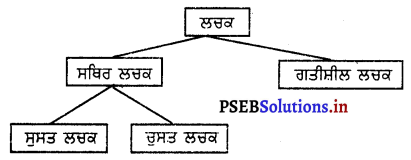
1. ਸੁਸਤ ਲਚਕ (Pasive Flexibility) – ਇਹ ਬਿਨਾਂ ਕਿਸੇ ਬਾਹਰੀ ਮੱਦਦ ਜਾਂ ਸਹਾਰੇ ਦੇ ਵੱਡੀ ਦਰ ਤੇ ਕ੍ਰਿਆਵਾਂ ਕਰਨ ਦੀ ਯੋਗਤਾ ਹੁੰਦੀ ਹੈ । ਉਦਾਹਰਨ ਦੇ ਤੌਰ ਤੇ ਕਿਸੇ ਸਾਥੀ ਖਿਡਾਰੀ ਦੀ ਮਦਦ ਨਾਲ ਸਚਿੰਗ (Stretching) ਕਸਰਤਾਂ ਕਰਨਾ ।
2. ਚੁਸਤ ਲਚਕ (Active Flexibility) – ਇਹ ਬਿਨਾਂ ਕਿਸੇ ਬਾਹਰੀ ਮੱਦਦ ਜਾਂ ਸਹਾਰੇ ਤੋਂ ਕ੍ਰਿਆਵਾਂ ਕਰਨ ਦੀ ਦਰ ਦੀ ਯੋਗਤਾ ਹੈ । ਉਦਾਹਰਨ ਦੇ ਤੌਰ ਤੇ ਲੱਤਾਂ ਨੂੰ ਝੂਲਾਉਣਾ ਆਦਿ ।
3. ਗਤੀਸ਼ੀਲ ਲਚਕ (Dynamic Flexibility) – ਇਹ ਉਹ ਲਚਕ ਹੁੰਦੀ ਹੈ ਜਦ ਸਰੀਰ ਗੜੀ ਵਿਚ ਹੁੰਦਾ ਹੈ ਅਤੇ ਕ੍ਰਿਆਵਾਂ ਪ੍ਰਦਰਸ਼ਨ ਕਰਦਾ ਹੈ । ਜਿਵੇਂ ਕਿ ਦੌੜਨਾ, ਤੈਰਨਾ ਜਾਂ ਸਮਰਸੱਲਟ (Samersault) ਆਦਿ ।
ਪ੍ਰਸ਼ਨ 5.
ਤੁਸੀਂ ਤਾਲਮੇਲ ਯੋਗਤਾ ਤੋਂ ਕੀ ਸਮਝਦੇ ਹੋ ? ਤਾਲਮੇਲ ਦੇ ਅਲੱਗ-ਅਲੱਗ ਅੰਗਾਂ ਨੂੰ ਬਿਆਨ ਕਰੋ ।
ਉੱਤਰ-
ਤਾਲਮੇਲ ਦੀ ਯੋਗਤਾ ਉਹ ਯੋਗਤਾ ਹੁੰਦੀ ਹੈ ਜਿਸ ਵਿਚ ਮੋਟਰ ਟਾਸਕ ( Motor task) ਸਹਜ ਅਤੇ ਸਹੀ ਢੰਗ ਨਾਲ ਕੀਤੇ ਜਾਂਦੇ ਹਨ ਅਤੇ ਜਿਸ ਵਿਚ ਇੰਦਰੀਆਂ ਅਤੇ ਮਾਸਪੇਸ਼ੀਆਂ ਦੀ ਸੁੰਗੜਨ ਦੀ ਪਰਸਪਰ ਸੰਬੰਧ ਹੁੰਦਾ ਹੈ। ਅਤੇ ਜੋ ਕਿ ਜੋੜਾਂ ਦੀ ਗਤੀ ਅਤੇ ਉਸਦੇ ਆਸ-ਪਾਸ ਦੇ ਅੰਗਾਂ ਅਤੇ ਸਰੀਰ ਦੀ ਸਥਿਤੀ ਤੇ ਨਿਰਭਰ ਕਰਦੀ ਹੈ । ਤਾਲਮੇਲ ਸਨਾਯੁਤੰਤਰ ਤੇ ਵੀ ਨਿਰਭਰ ਕਰਦਾ ਹੈ । ਸਰੀਰਕ ਤੰਦਰੁਸਤੀ ਵਿਚ ਤਾਲਮੇਲ ਦਾ ਅਹਿਮ ਰੋਲ ਹੈ ਜਿਸ ਤੋਂ ਬਿਨਾਂ ਕੋਈ ਵੀ ਖੇਡ ਜਾਂ ਕਿਆ ਸੰਭਵ ਹੀ ਨਹੀਂ ਹੈ ।
ਤਾਲਮੇਲ ਦੇ ਪ੍ਰਕਾਰ (Types of co-ordination-ਖੇਡਾਂ ਦੀ ਦੁਨੀਆਂ ਵਿਚ ਮੁੱਖ ਤੌਰ ਤੇ ਸੱਤ (7) ਪ੍ਰਕਾਰ ਦੀ ਤਾਲਮੇਲ ਯੋਗਤਾ ਪਾਈ ਜਾਂਦੀ ਹੈ ।
1. ਸਥਿਤੀ ਨਿਰਧਾਰਣ ਯੋਗਤਾ (Orientation) – ਯੋਗਤਾ-ਇਹ ਵਿਅਕਤੀ ਉਹ ਯੋਗਤਾ ਹੈ ਜਿਸ ਵਿਚ ਉਹ ਜ਼ਰੂਰਤ ਅਨੁਸਾਰ ਸਥਾਨ ਅਤੇ ਸਮੇਂ ਤੇ ਆਪਣੇ ਸਰੀਰ ਦਾ ਵਿਸ਼ਲੇਸ਼ਣ ਕਰਕੇ ਪਰਿਵਰਤਨ ਕਰ ਲੈਂਦਾ ਹੈ । ਉਦਾਹਰਨ ਦੇ ਤੌਰ ਤੇ ਜਿਮਨਾਸਟਿਕ ਵਿਚ ਖੇਡ ਪ੍ਰਦਰਸ਼ਨ ਮੁਤਾਬਿਕ ਸਰੀਰ ਦੀ ਸਥਿਤੀ ਨੂੰ ਬਦਲਣਾ, ਬਾਸਕਟਬਾਲ ਵਿਚ ਅਫੈਨਸ ਤੇ ਡੀਫੈਨਸ (Offense and defense) ਵਿਚ ਆਪਣੇ ਸਰੀਰ ਦੀ ਸਥਿਤੀ ਵਿਚ ਬਦਲਾਵ ਕਰ ਲੈਂਦਾ ਹੈ ।
2. ਸੰਯੋਜਨ ਦੀ ਯੋਗਤਾ (Coupling Ability) – ਇਹ ਵਿਅਕਤੀ ਦੀ ਉਹ ਯੋਗਤਾ ਹੈ ਜਿਸ ਵਿਚ ਉਹ ਸਰੀਰ ਦੇ ਅੰਗਾਂ ਨੂੰ ਗਤੀ ਵਿਚ ਅਰਥਪੂਰਨ ਢੰਗ ਨਾਲ ਸੰਯੋਜਨ ਕਰਕੇ ਕੀਤਾ ਜਾਂਦਾ ਹੈ ; ਜਿਵੇਂ ਵਾਲੀਬਾਲ ਵਿਚ ਸਪਾਈਕਿੰਗ ਦੇ ਦੌਰਾਨ ਖਿਡਾਰੀ ਤੇਜ਼ ਗਤੀ ਨਾਲ ਜੰਪ ਕਰਦਾ ਹੈ | ਬਾਲ ਨੂੰ ਹਿੱਟ ਕਰਦਾ ਹੈ । ਇਸ ਸਮੇਂ ਉਸ ਦੇ ਸਰੀਰ ਦੇ ਸਾਰੇ ਅੰਗਾਂ ਵਿਚ ਇਕਸਾਰਤਾ ਦਾ ਤਾਲਮੇਲ ਹੁੰਦਾ ਹੈ ।
3. ਡਿਫਰੇਂਸੀਏਸ਼ਨ (Differentiation Ability) – ਇਹ ਵਿਅਕਤੀ ਦੀ ਉਹ ਯੋਗਤਾ ਹੁੰਦੀ ਹੈ ਜਿਸ ਖਿਡਾਰੀ ਮੋਟਰ ਐਕਸ਼ਨ (Motor action) ਦੇ ਦੌਰਾਨ ਸਰੀਰ ਦੇ ਅਲੱਗ-ਅਲੱਗ ਅੰਗਾਂ ਤੋਂ ਕ੍ਰਿਆ ਕਰਵਾਉਣ ਦੀ ਸਮਰੱਥਾ ਦਾ ਪ੍ਰਦਰਸ਼ਨ ਕਰਦਾ ਹੈ , ਜਿਵੇਂ ਕਿ ਵਾਲੀਬਾਲ ਵਿਚ ਸਪਾਈਕਿੰਗ ਜੰਪ ਦੇ ਦੌਰਾਨ ਸਥਿਤੀ ਦੇ ਅਨੁਸਾਰ ਬਾਲ ਨੂੰ ਸੁੱਟਣਾ (Drop) ਕਰਨਾ ।
4. ਪ੍ਰਤੀਕ੍ਰਿਆ ਕਰਨ ਦੀ ਯੋਗਤਾ (Reaction Ability) – ਇਹ ਵਿਅਕਤੀ ਦੀ ਉਹ ਯੋਗਤਾ ਹੈ ਜਿਸ ਵਿਚ ਸਿੰਗਨਲ ਮਿਲਣ ਤੇ ਖਿਡਾਰੀ ਪ੍ਰਤੀਕ੍ਰਿਆ ਕਰਦਾ ਹੈ , ਜਿਵੇਂ 100 ਮੀ: ਦੌੜ ਵਿਚ ਸਿੰਗਨਲ ਹੁੰਦੇ ਹੀ ਇਕ ਵੇ ਤੇ ਦਿਸ਼ਾ ਵੱਲ ਤੇਜ਼ ਗਤੀ ਨਾਲ ਦੌੜਨਾ ।
5. ਸੰਤੁਲਨ ਯੋਡਾ (Balance Ability) – ਇਹ ਵਿਅਕਤੀ ਦੀ ਉਹ ਯੋਗਤਾ ਹੈ ਜਿਸ ਵਿਚ ਉਹ ਗਤੀ ਵਿਚ ਸਰੀਰ ਦੀ ਸਥਿਤੀ ਬਣਾਈ ਰੱਖਦਾ ਹੈ ; ਜਿਵੇਂ ਕਿ ਸਕੂਟ ਸਟਾਂਪ (Scoot stop) ਅਤੇ 400 ਮੀ: ਵਿਚ ਆਪਣੀ ਲਾਈਨ ਵਿਚ ਰਹਿ ਕੇ ਦੌੜਨਾ ਆਦਿ ।
6. ਲੈਅ ਦੀ ਯੋਗਤਾ (Rhythm Abhity) – ਇਹ ਵਿਅਕਤੀ ਦੀ ਉਹ ਯੋਗਤਾ ਹੈ ਜਿਸ ਵਿਚ ਉਹ ਲੈਅ ਨੂੰ ਸਮਝਦੇ ਹੋਏ ਲੈਅ ਵਿਚ ਗਤੀ ਬਣਾ ਕੇ ਰੱਖਦਾ ਹੈ । ਉਦਾਹਰਨ ਦੇ ਤੌਰ ਤੇ ਬਾਸਕਟ ਬਾਲ ਵਿਚ ਲੈ-ਅਪ (Lay up) ਸਾਂਟ ਲਗਾਉਣਾ ।
7. ਹਿਣ ਯੋਸਤਾ (Alkation Ability) – ਇਹ ਵਿਅਕਤੀ ਦੀ ਉਹ ਯੋਗਤਾ ਹੈ ਜਿਸ ਵਿਚ ਉਹ ਪ੍ਰਸਥਿਤੀ ਨੂੰ ਸਮਝ ਕੇ ਉਸ ਵਿਚ ਪ੍ਰਭਾਂਵੀ ਪਰਿਵਰਤਨ ਲੈ ਕੇ ਆਵੇ । ਉਦਾਹਰਨ ਦੇ ਤੌਰ ਤੇ ਬਾਸਕਟ ਬਾਲ ਵਿਚ ਜੰਪ ਸੱਟ ਕਿਆ ਦੇ ਅਨੁਕੂਲ ਬਣਾਉਣਾ ਆਇ ॥
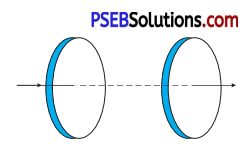
![]()

![]()
![]()
![]()

![]()
![]()
![]()






